|

|
 |
|
- |
|

Email us at
info@coastal181.com
|
|
 Previous
Photos of the Day - PAGE 8 Previous
Photos of the Day - PAGE 8
 Previous
Photos of the Day - PAGE 7 Previous
Photos of the Day - PAGE 7
 Previous
Photos of the Day - PAGE 6 Previous
Photos of the Day - PAGE 6
 Previous
Photos of the Day - PAGE 5 Previous
Photos of the Day - PAGE 5
 Previous
Photos of the Day - PAGE 4 Previous
Photos of the Day - PAGE 4
 Previous
Photos of the Day - PAGE 3 Previous
Photos of the Day - PAGE 3
 Previous
Photos of the Day - PAGE 2 Previous
Photos of the Day - PAGE 2
 Previous
Photos of the Day - PAGE 1 Previous
Photos of the Day - PAGE 1 |
|
.jpg) |
|
#2000 - It is well-know that
Ronald Reagan was a race announcer, that James
Dean and Steve McQueen were quite the gassers,
but was Jackie Gleason really a flagman?
Actually, that nattily attired dude – replete
with spats –was Augustus Fuller "Cotton" Grable,
one serious character in his own right. Here he
is, saying "no go" to a start by Mel Hansen and
Rex Mays on the 1.062-mile dirt at Arlington
Downs, Texas, on August 17, 1949. Grable, once a
Big Car racer himself nicknamed "the Blonde
Blizzard from Texas," retired to waving the
sticks, just as he did in the movie "To Please a
Lady." (Bart Stevens Collection) |
|
a |
|
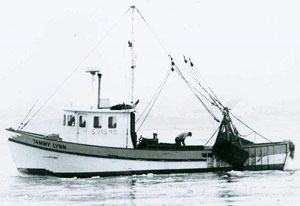 |
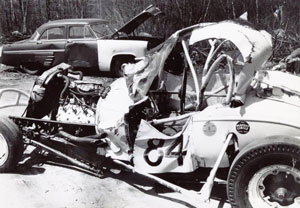 |
#1999 - Bob Cloutier, a
great racer from the coast of New England,
passed away last week from cancer at age 78. Bob
was one of the original founders of the New
England Super Modified Racing Association
(NESMRA) when it sprung up after a
competitor-walkout at the Pines Speedway In
Groveland, MA, in 1965. An accomplished tuna
fisherman and popular charter-boat operator, Bob
was also very passionate about his racing – both
in New England and in Florida during winter – as
you can see from this photo taken after a little
spill at Hudson, NH. (Photos, Russ Conway
Collection)
Services will be held Saturday
March 3 at the Phaneuf Funeral Home, 243 Hanover
Street, Manchester, NH. |
|
a |
|
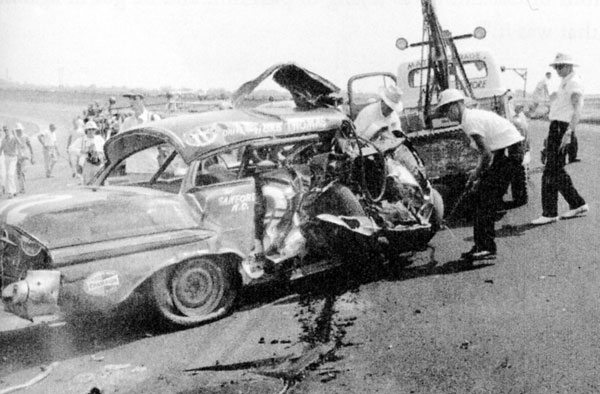 |
|
#1998 - On October 23, 1956,
Herb Thomas, leading in NASCAR Grand National
Points, pulled into Shelby, NC, for a 100-miler
on the half-mile dirt. After getting spun by
Speedy Thompson on lap 109, Thomas sat sideways
in the groove and was clobbered several times,
flipping him in different directions. He
sustained life-threatening head injuries. The
next year he attempted a comeback. After a race
at Raleigh he told his wife, “I can go down the
straightaway but I can’t get into the turns with
it. It’s just not like it used to be.” After a
race at Lincoln, PA, Speedway, he hung it up. It
was the end of his career behind the wheel, and
he asked Fonty Flock to substitute for him in
the Southern 500 on September 2. Flock qualified
up front, but got caught up in a horrific
three-car crash in the third turn. It was the
end of Thomas’s Pontiac – and the end of Bobby
Myers’ life. From FULL JEWELLED – Stock Car
Racing, 1951- 1956, As Told to Russ
Hamilton. |
|
a |
|
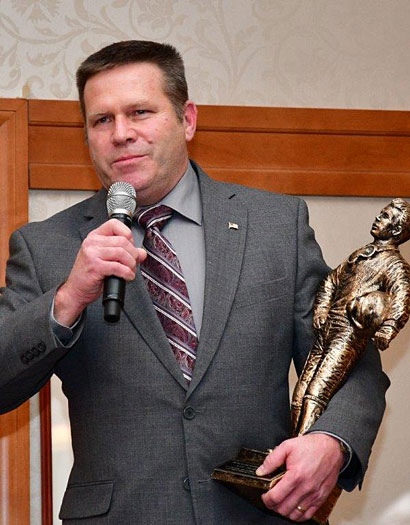 |
|
#1997 - It didn’t take Karl
Fredrickson too many winters to become an
accomplished motorsports media entrepreneur. In
2012 he restarted Dick Berggren’s SPEEDWAY
ILLUSTRATED magazine, which is really
humming. Last year he launched a companion
magazine, CC RACER, that is showing
tremendous promise. And last month he was
awarded the Jim Hunter Memorial Writers Award at
the Eastern Motorsports Press Association
conference. The honor seems particularly
appropriate as Karl and the late Jim Hunter
(NASCAR’s former Vice President of Corporate
Communications) are both noted for their unusual
passion for and engagement in the short-track
community. A few years back when Karl won his
first feature in a pavement Modified at a weekly
NASCAR event, Jim emailed him with
congratulations. (TDSPEEDSHOTZ Photo) |
|
a |
|
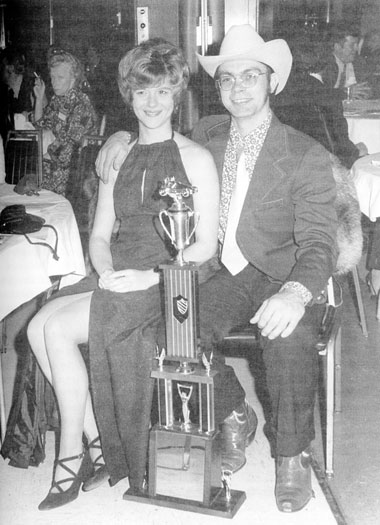 |
|
#1996 - Happier times. “A
petite and pretty Cindy Todd with her
husband-to-be, winning race driver Rich Vogler,
in a 1974 banquet shot. The couple was married
two years later, but the union lasted only until
1979.” Quote and Photo from NO TIME FOR
YESTERDAY: Rich Vogler, His Life 1950-1990,
by John Sawyer. |
|
a |
|
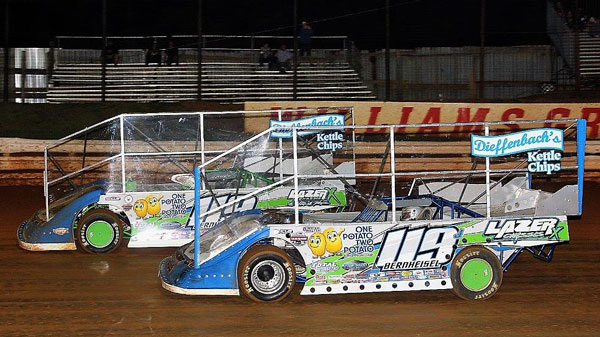 |
|
#1995 - No one could
question that the Bernheisel Team was ready for
the “run what ya brung” show at Williams Grove
on October 6. That’s Jim Bernheisel on the
inside in the #119j with son Bryan alongside in
the #119. They were one-two in the main, with
Bryan edging out his dad. Photo from Mike
Feltenberger’s STRAPPED IN magazine.
(Kirk Rissmiller Photo) |
|
a |
|
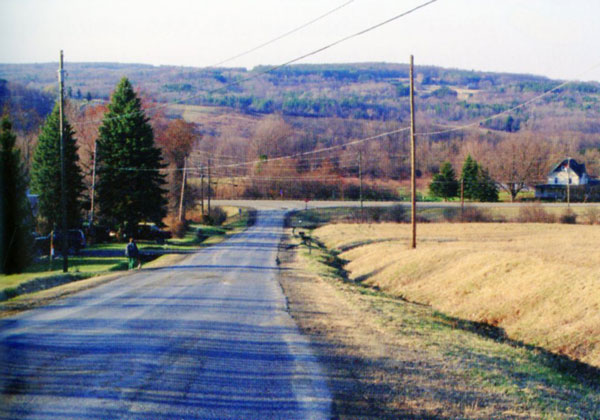 |
|
#1994 - It looks bucolic
today, but this downhill was bad ass in the
1953-1955 races at the old 4.6-mile Watkins Glen
road course in New York. Even back then the top
cars would achieve 150 mph approaching Townsend
(90-degree, right-hand) Corner. To make it even
trickier, drivers pointed out that the surface
down the slope was no putting green. From
LOST ROAD COURSES, by Martin Rudow.
(Photo courtesy Judy Rudow) |
|
a |
|
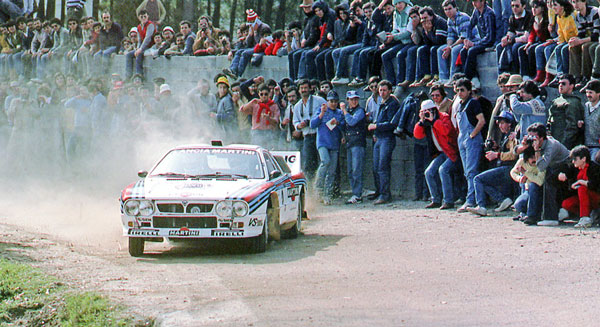 |
|
#1993 - That’s Walter Rohrl
negotiating a turn on Sintra, the first section
of the Rally de Portugal, fairly tight against
human guard rail. Crowd control was often a
serious issue there, but not more so than on
March 5, 1986 when Joaquim Santos’s car left the
course and plunged into the crowd, killing three
and injuring dozens. Photo from LANCIA 037:
The Development and Rally History of a World
Champion, by Peter Collins(Photo courtesy
of Lancia Motor Club) |
|
a |
|
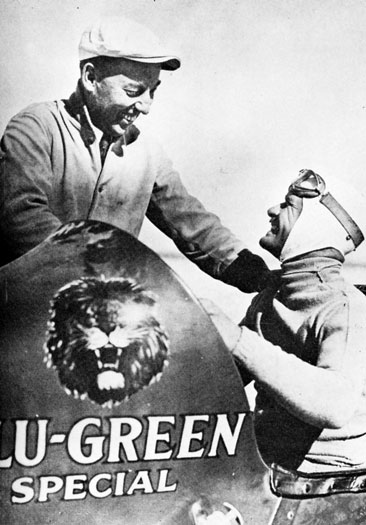 |
|
#1992 - “A highlight at
Legion Ascot Speedway in Los Angeles was the
introduction of the first crash helmet worn in
competition on an American track. Crash helmets
in the U.S. were unheard of at this time, and
every driver used the old-style cloth headpiece
under his strapped googles. Wilbur Shaw (shown
above with Art Pillsbury, AAA Western Director,
wearing the old-style helmet), who was to win
three Indianapolis races, then received a gift
that was to set the safety standard for all
present and future drivers. The gift was a crash
helmet, given to Wilbur in the spring of 1932 by
Major H.O.D. Seagrave of England. Thus Wee
Wilbur became the first man to wear one. Shaw
was resoundingly booed when he first wore it. He
was heckled by speed thirsty fans and sometimes
called “chicken.” Many Ascot drivers refused to
wear the helmet for fear they would lose
prestige and become targets of howling fans.
Then it happened: Shaw was in a heat race one
afternoon with Stapp, Sam Palmer, Saulspaugh and
Spangler. Shaw came out of the north turn too
fast, smashed into the homestretch fence and
flipped his car towards the infield. Wilbur was
ejected and airborne about 25 feet and landed on
his head, shoulders, and buttocks. He came out
of the flight with nary a scratch. After the
significant part Shaw’s helmet played in
preventing serious injury, or even death, crash
helmets began to blossom.” Quote and Photo from
LEGION ASCOT SPEEDWAY – 1920s-1930s, by
John R. Lucero. |
|
a |
|
.jpg) |
|
#1991 - It was kind of
unlikely when the boys from SCODA, representing
the Sports Car set, showed up at the half-miler
at Reading Fairgrounds on the afternoon of June
9, 1957. Not surprisingly, it was a
one-time-only. It was won by frequent victor
Jake Jacobs, who towed in from Providence, RI,
with his Corvette. (Mike Ritter Collection) |
|
a |
|
.jpg) |
|
#1990 - World Rally
competitor Mikka Kirvonen won his first, the
Telstra Rally Austria, in 2006. The next season,
though, he is said to really have matured as a
driver. He tested every approach, every
technique. Here, at Rally Italy on the island of
Sardinia, he checked out the aerial groove. From
FORD FOCUS WRC: The Autobiography of a Rally
Champion, by Graham Robson. |
|
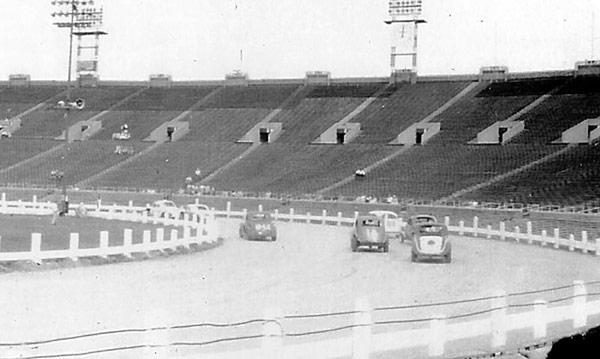 |
|
#1989 - If this was a race
that day in 1957 at the Philadelphia Municipal
Stadium, we probably should feel sorry for the
promoter. If one of those cars got to flipping
along the top of those guard rails, we’d have to
feel REALLY sorry for the driver (Mike Ritter
Collection) |
|
a |
|
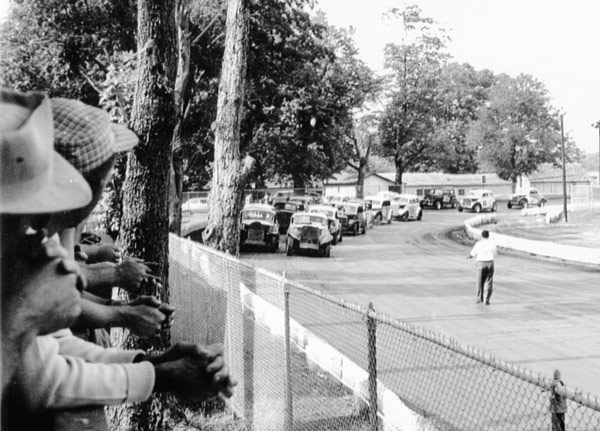 |
|
#1988 - This was the way it
looked at the Square, Flemington, NJ, on August
17, 1958, as the Modifieds were warned to stay
cool on their parade lap. (But is that tree on
the left or the right side of the fence?!?)
(Mike Ritter Collection) |
|
a |
|
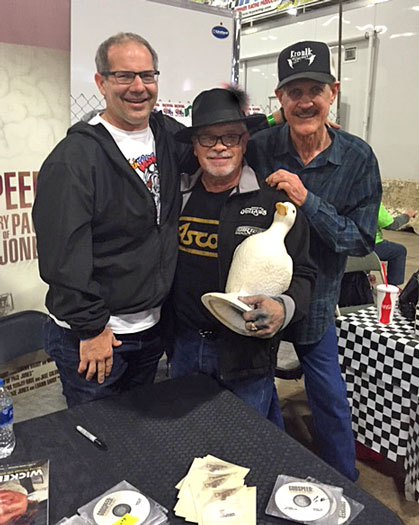 |
|
#1987 - Our Chili Bowl booth
seems to have its way of attracting quacks. Here
are (l to r) Page Jones, Shane Carson and
relative, and Jimmy Oskie. (Coastal 181
Collection) |
|
A |
|
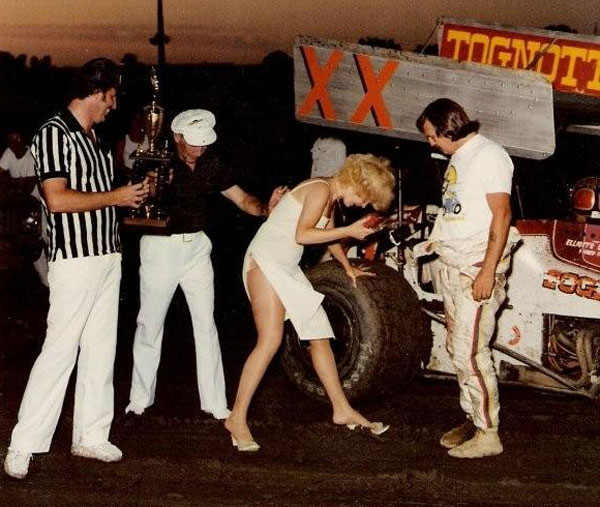 |
|
#1986 - It looks like that
trophy gal had to navigate the berm before
reaching GP, the late, great Gary Patterson, for
his victory kiss. (Gary Patterson Racing/Images) |
|
A |
|
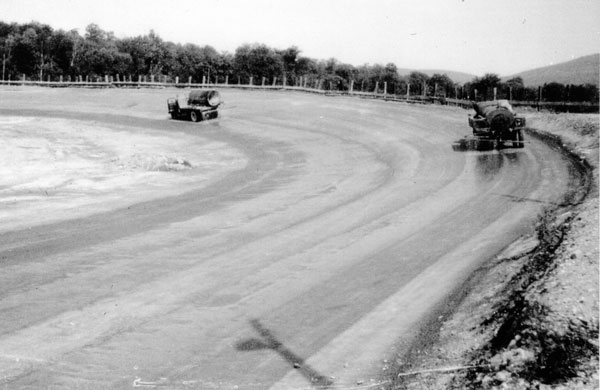 |
|
#1985 - This is a tell-all
image of what promoter Howie Commander has been
up to for the last five decades. Lebanon Valley
Speedway, New York, one of the Northeast’s most
iconic racing facilities, looked ten decades
more primitive as it was being prepared for
racing the weekend of August 9, 1957. (Mike
Ritter Collection) |
|
a |
|
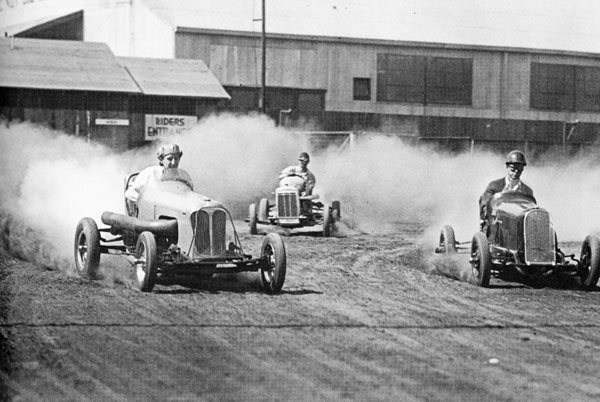 |
|
#1984 - It wasn’t exactly the Chili
Bowl. Eighty-five winters ago, in April of 1935
a publicity session was held at Atlantic Stadium
in East Los Angeles for a new form of race cars
becoming known as Midgets. Here Curly Mills,
Charlie Vondera, and Roy Richter try to make
some speed on the loose surface of the former
motorcycle track. From ROY RICHTER: Striving
for Excellence, by Art Bagnall. (Roy Richter
Collection) |
|
a |
|
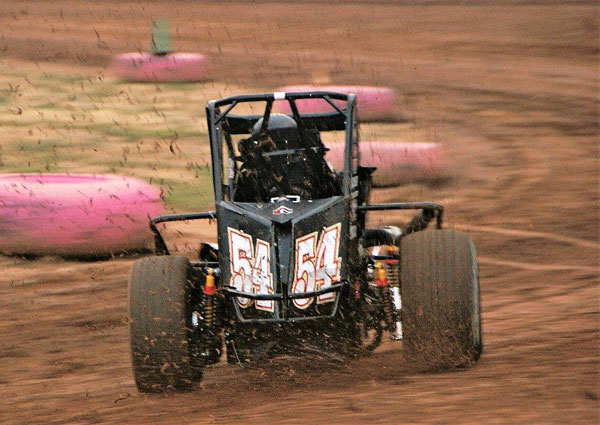 |
|
#1983 - Matt Westfall, the
"Flying Buckeye" out of Pleasant Hill, Ohio,
spends his share of the day on the road – and on
the clay. Like his role model Jack Hewitt, the
2015 Eldora Late Model Champion races anything
anywhere. He's a Silver Crown rookie of the
year, top performer at the Chili Bowl, USAC
Sprint feature winner, modified standout, etc.,
etc. Last summer he often ventured east to
Speedway Entertainment shows. He's at the top of
his game in his SpeedSTR in this cool shot by
Mike Feltenberger at Linda's Speedway,
Jonestown, PA. Catch him if you can. |
|
A |
|
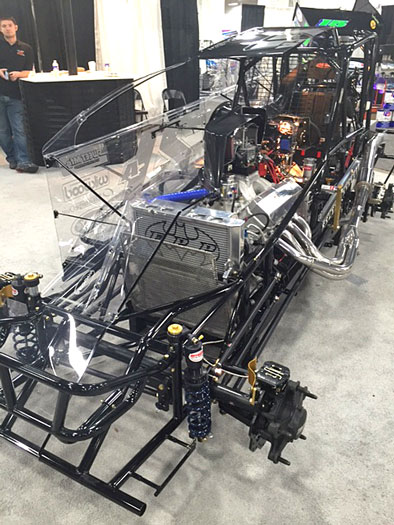 |
|
#1982 - This Troyer "under
glass" was at the AARN Motorsports show in Oaks,
PA a week ago. It was hard to take its likeness
as so many folks surrounded it all weekend. The
TD-4 is the personal ride of Peter "Batman"
Britain, the Weedsport, NY, resident via
Brisbane, Queenland, Australia. Britten was the
'17 Albany-Saratoga track champ and came in an
oh-so-close second in the Super Dirt Car finale
at Oswego. There ain't much on this car you can
buy from NAPA. (Coastal 181 Photo) |
|
a |
|
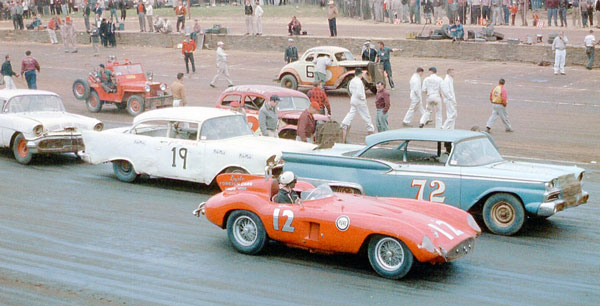 |
|
#1981 - Good Lord! Certain photos
just appear to depict some other reality, and
this is one of them. Any feedback on what this
event was and where would be gratefully received
at
lewboyd@coastal181.com (Mike Ritter
Collection) |
|
a |
|
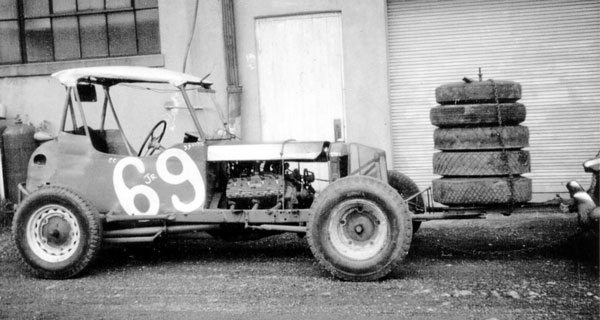 |
|
#1980 - Who knows when or
where? They might have been a tad lean on roll
bars, on safety hubs – and a trailer, but they
were all set for stagger options with that
perfectly arranged tire rack. (Mike Ritter
Collection) |
|
a |
|
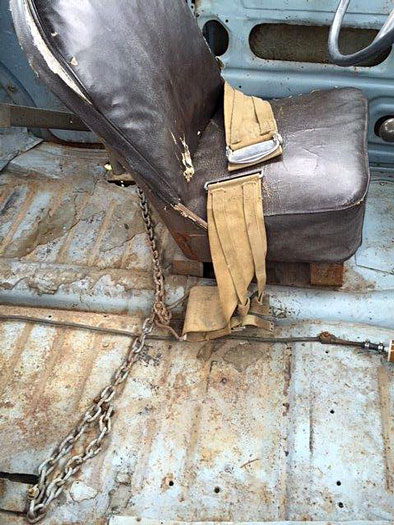 |
|
#1979 - "The way we were."
Photo taken in at Cairo (NY) Speedway Reunion,
2017. (Coastal 181 Collection) |
|
A |
|
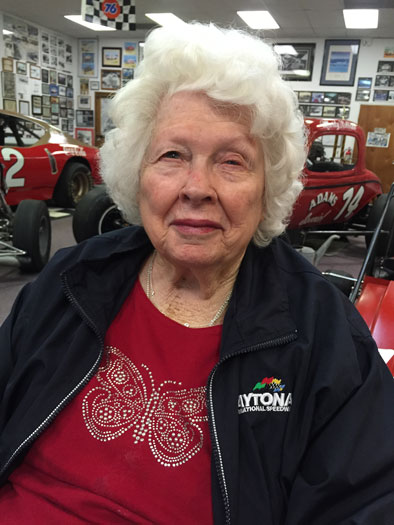 |
|
#1978 - “She’s still
working. A year ago, this space published a
photo of Juanita “Lightnin’” Epton, the longest
serving employee of Daytona Speedway. She has
worked at the track since the day the ticket
office opened in 1958. She’s still at the track
nearly every day, working in the ticket office
at age 98. As mentally sharp as when she was 20,
on February 14 when the annual Living Legends of
Auto Racing’s awards banquet begins, Lightnin’
will deliver the invocation. The following day
she’ll be back at work in the ticket office.”
Quote and Photo from Dick Berggren |
|
a |
|
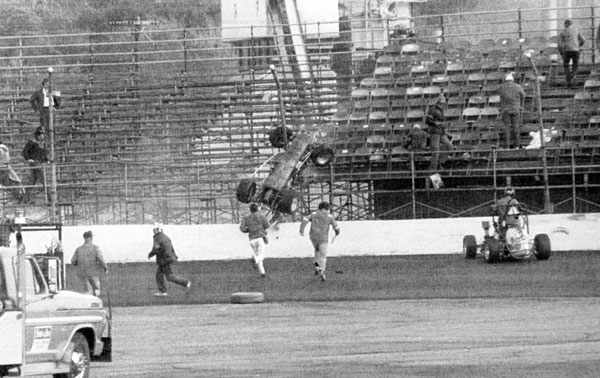 |
|
#1977 - “May 1, 1981 a pack of USAC
Midgets was hot-lapping the one-fifth-mile of
macadam that easily defines the Indianapolis
Speedrome. It was a highly interesting session
since (father and son) Don and Rich Vogler were
playfully roughhousing with each other at full
speed….Cut and sliced to cruelly simple, it just
happened. Entering turn three, Don Vogler’s
handcrafted Midget inexplicably failed to turn,
impacted the guardrail, began to flip, and ended
up tangled well above the ground in the
catch-fencing….Rescuers quickly reached the
scene, Rich Vogler among the vanguard of them.
He was there just long enough to grasp the
gravity of the situation and he strode rigidly
back across the track. “My Dad won’t make it.
Too much impact…just too much impact,” he
mumbled.” He didn’t. Photo and quote from NO
TIME FOR YESTERDAY – Rich Vogler: His Life
1950-1990, by John Sawyer. |
|
A |
|
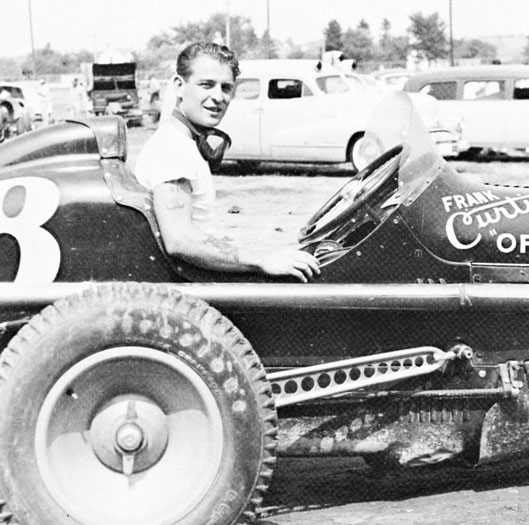 |
|
#1976 - Wally Campbell, one
of the East Coast’s most serious gassers, is
shown at Cedar Rapids in 1953 in Frank Curtis’
Sprinter. Campbell, who perished at Salem the
next season, was strong-armed. But his tattoos
and his T-shirt, the racers’ fashion statement
of the day, did little to protect those biceps.
Typically, on the old fair tracks, drivers would
return to the pits all bloody and banged up from
flying dirt clods and rocks. Arnie Knepper
labeled the condition “Offy rash.” Later, when
fire suits were in vogue and the track surface
looked a little racy, some guys would tape a
protective layer of cardboard to their arms.
There was no visible compromise to their
masculinity, as few fans saw they did it. From
1976 SPRINT CAR PICTORIAL. (Larry
Sullivan Photo) |
|
A |
|
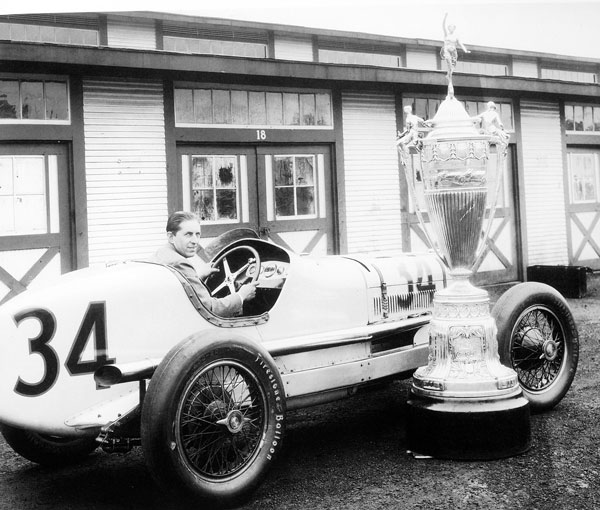 |
|
#1975 - A trophy that looked
like it meant it! “Harry Hartz poses with the
Wheeler Schebler trophy he won in 1932. It was
originally intended for the 1909-1910
Indianapolis events. As of 1914, the trophy
would be awarded to the car owner that led at
400 miles. Hartz led at 400 miles in 1930, 1931,
and 1932.” Quote and Photo from
HARD DRIVING MEN: Images of Speed, by
Dick Wallen (Indianapolis Motor Speedway Photo) |
|
A |
|
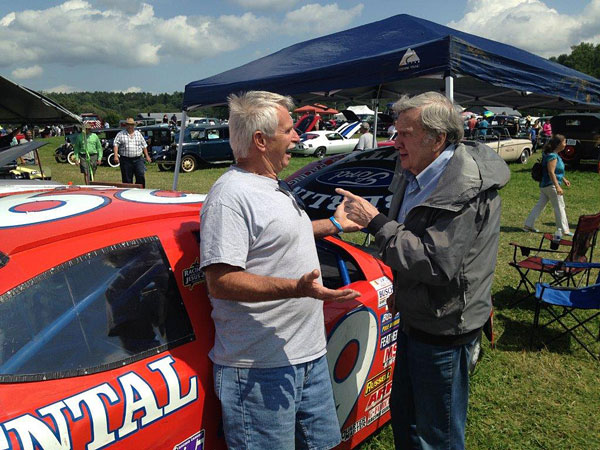 |
|
#1974 - That's Dave Dion
(L), a spicy, former champion Northeast Late
Model racing standout, having a bit of
discussion with Kenley Squier. Ken is a 2018
inductee to the NASCAR Hall of Fame who, back in
promoting days, tried mightily to keep Dave in
check – with mixed results. Dave has moved to
Daytona, hooked up with the Living Legends of
Auto Racing, and each year, these days, he hosts
what just might be the coolest, down-to-earth
event of Speedweeks. It is called "Coffee with
Characters," and it is a free-ranging, often
hilarious, discussion among racing notables from
all over the country. It is scheduled for this
year at 10:00am, Thursday, Feb. 15, at the LLOAR
Museum, 2400 South Ridgewood Ave, South Daytona.
If you need more info, give Dave a shout at
(603) 320-3095 (Dion Brothers Collection) |
|
a |
|
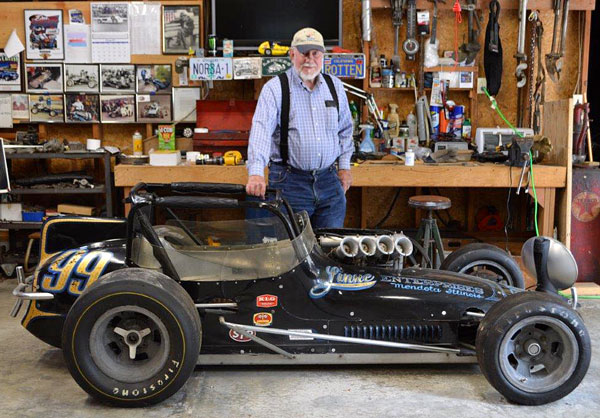 |
|
#1973 - In the early 1970s,
championship driver and prodigious car builder
Don Edmunds put his well-utilized pencil to
paper to design a four-wheel, independent
suspension Midget. His hope was the car might
really help keeping open wheel – and Indy –
racing accessible to American drivers, most all
of whom were trained with straight axles and
torsion bars and little lap time with the new
independent chassis technologies. The car was
lightning fast, but was banned both in the
United States and in Australia. It was, however,
Don's favorite of all the cars he ever built.
Recently, when Paul Weisel, the former racer and
current race historian/writer from New Jersey,
went to Don's home in Oregon to work on the book
they were producing, Paul noticed that the car
had a set of two Hoosier dirt tires on the
front. Don had been unable to locate a pair of
the original pavement front Firestones. Turns
out that Paul used to have Firestone's Northeast
racing tire warehouse, and the next time he went
west, he brought the proper rubber with him.
Paul writes, "Don was all smiles. We had them
mounted at a local tire dealer and the above
photo is the first one taken with Don and his
prized roadster on four vintage Firestones."
From
THE SAGA OF ROTTEN RED: The Don Edmunds Story,
by Paul Weisel Jr. (Paul Weisel Photo) |
|
A |
|
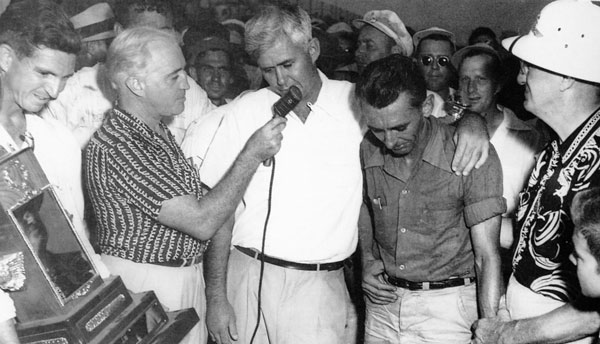 |
|
#1972 - A lot of ex-racer
Harold Brassington’s South Carolina neighbors
thought he had gone a little wacky in 1949. The
previous year he had gone to Indy and seen the
enormous crowd; he announced at a card game that
he was going to build a huge, banked and paved
facility for stock car racing in Darlington.
Equally unbelievably, he planned to open with a
500-miler for the Strictly Stock cars on the
Monday of Labor Day weekend in 1950 that he
would call the Southern 500. Seventy-five cars
showed up from everywhere, and after 15 days of
qualifying, still fascinated with Indy,
Brassington lined the grid up three-deep, 25
rows. The fans showed up, too – so many of them
that hotels filled, and Brassington opened the
infield for cars and trucks so fans would have a
place to sleep. Apparently most of them decided
to drink instead. Some of them likely caught a
few Zs during the show itself. It took the
winner, Johnny Mantz, over six hours to urge his
1959 Plymouth along the 500-mile run. He was the
slowest qualifier, but unlike others he used
heavy-duty truck tires and just plodded along
while faster entries broke or had tire failures.
He averaged 75.250mph. That’s Brassington with
his arm around Mantz in victory lane, and
Cannonball Baker is on the right. From STOCK
CAR RACING – The High Speed History of America’s
Premier Motorsport, by Don Hunter and Al
Pearce. (Tom Kirkland Photo) |
|
a |
|
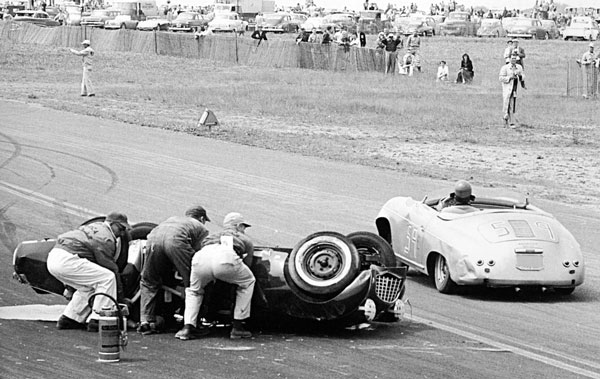 |
|
#1971 - “For many privateer
(sports car) racers, the TR3 proved to be the
car of choice…In the 1950s, drivers frequently
raced in short sleeves and the equivalent of a
polo helmet; cars did not have roll bars or
sometimes even seat belts. This accident at the
1956 Redwood Empire amateur race in Arcata,
California, claimed the life of William Howard
‘Pete’ Snell. Another amateur racer, Dr. Howard
Snively, was the course physician and after
seeing how poorly the existing crash helmets
worked, he began serious efforts to do something
about it. Within a year and with help from the
SCCA, the Snell Foundation was born and by 1959
the first Snell standards were implemented. The
Snell number certifications for helmets continue
to this day.” Quote and Photo from THE
ILLUSTRATED TRIUMPH SPORTS AND RACING CARS,
by G. William Krause. (Photo courtesy Revs
Institute, William Hewitt Collection) |
|
A |
|
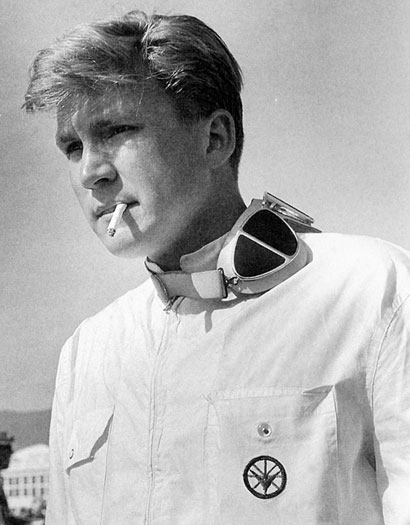 |
|
#1970 - Handsome Lance
Reventlow was son of socialite Barbara Hutton
and Count Kurt von
Haugwitz-Harderberg-Reventlow. Relying on his
resources as heir to the Woolworth fortune, he
began road racing in California with his buddy
James Dean. He then set up a company building
Chevy-powered Scarab race cars, driven to glory
by stars such as Chuck Daigh and Carroll Shelby.
Married initially to Jill St. St. John and
subsequently Mouseketeer Cheryl Holdridge, he
died in a plane crash in 1972. Can you imagine
seeing a figure like that today with a cigarette
in the mouth? Photo from
UNITED STATES AUTO CLUB: Fifty Years of Speed
and Glory, by Dick Wallen. (Dave
Freidman Photo) |
|
A |
|
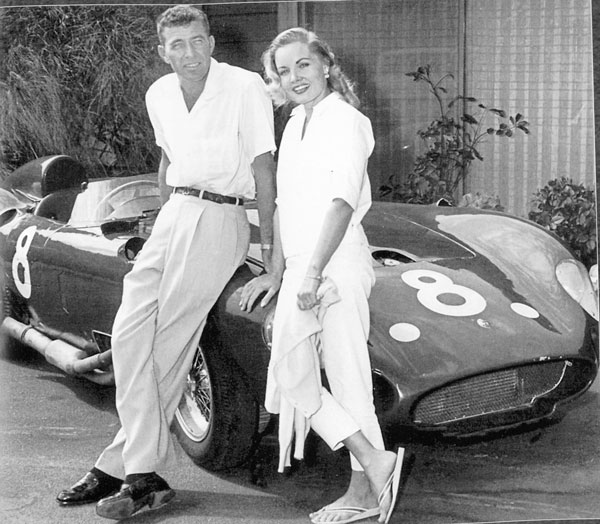 |
|
#1969 - “Carroll Shelby was
kissed so many times by [actress] Jan Harrison
that he asked her to marry him…After watching
the bull fights in Tijuana, Mexico, they were
married. A few months later he returned to
Mexico and terminated it. He and Jan remained
friends, however, for the rest of his life.”
Quote and Photo from
CARROLL SHELBY: A Collection of my Favorite
Racing Photos, by Art Evans with
Carroll Shelby. |
|
A |
|
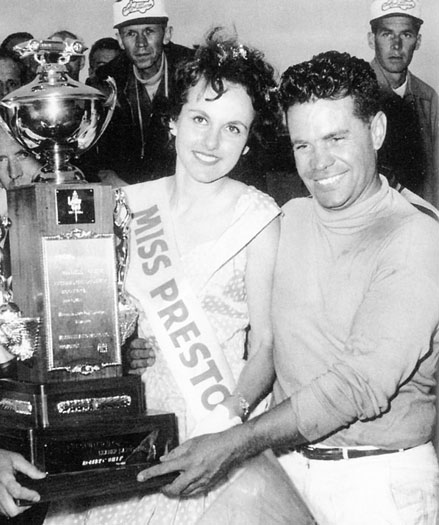 |
|
#1968 - Three “B-boys” from
Arizona were ’50s-era open wheel champions:
handsome Art Bisch, bespectacled Bobby Ball, and
the state’s “Cowboy” Jimmy Bryan. All of them
perished pursuing the oily grail. Ball, a
fabulous Midget wheelman, died 14 months after
being injured at Carrel Speedway in Gardena, CA,
in 1954 in a wreck in which Bryan was also hurt.
Bisch won the 1956 CRA title and moved up to
Championship cars. As shown above, in spring of
1958, he won Milwaukee, but he died in a
100-miler at Atlanta’s Lakeside Speedway on July
4, 1958. Two years later, Indy-winner Jimmy
Bryan met his demise in Langhorne’s dreaded Puke
Hollow on the very first lap of the June USAC
Big Car main event. Photo from
UNITED STATES AUTO CLUB: Fifty Years of Speed
and Glory, by Dick Wallen |
|
A |
|
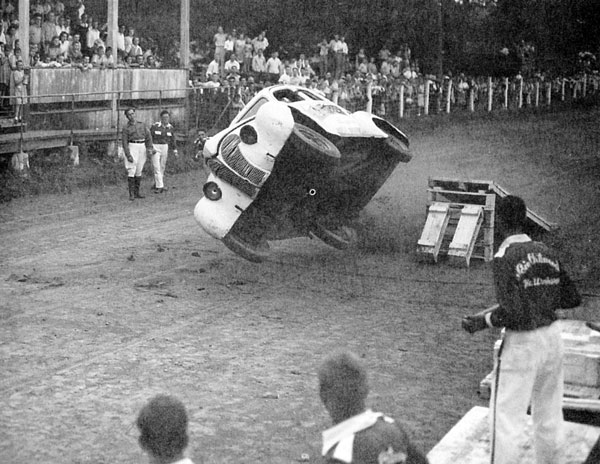 |
|
#1967 - Right after World
War II, Joie Chitwood ramped up his thrill show
with several traveling units. His friend and
employee, Snooks Wentzel, became manager of one
of them. Shown here doing an early rollover
crash while Chitwood (upper left in the riding
boots and pants) watched, he had become quite
the stuntman himself. As reported in Chitwood’s
biography, “Then in the evening of July 1, 1952,
Snooks was doing deliberate auto rollovers in
Haverhill, Massachusetts, [at the old Pines
Speedway]. A crash man had quit, and the show
was short-handed, so Snooks decided to do the
rollover. He started with a full tank of gas. At
the time, stuntmen didn’t drain the gasoline out
of the junkers. He rolled the car
wheel-to-wheel, side-over-side, landing on all
four wheels, drove back up the track, approached
the narrow rollover ramp and flipped the car
again. He repeated the feat as many times as he
could landing in the same place every time. On
the fourth roll that evening, something went
wrong. The car did not roll back up onto its
wheels, but came to rest on the driver’s side.
Then it caught fire. Before the firetruck in the
infield could drive over, the car exploded.
Snooks was knocked unconscious by the blast and
died. Apparently the gas cap came off after the
first roll. Each successive time Snooks did the
rollover, more fuel was dumped in the same spot.
It is not known what actually ignited the fuel.
The engine may have backfired or the fan may
have hit the radiator shroud causing sparks.” It
was obviously a frighteningly sickening
spectacle. And, to make it even more horrible, a
sizeable crowd in the grandstand watched, as did
all the drivers scheduled for the jalopy
feature. They were all lined up, buckled in
their cars, on the backstretch. Photo and Quote
from SAFE AT ANY SPEED: The Great Double
Career of Joie Chitwood, by Jim Russell and
Ed Watson. |
|
A |
|
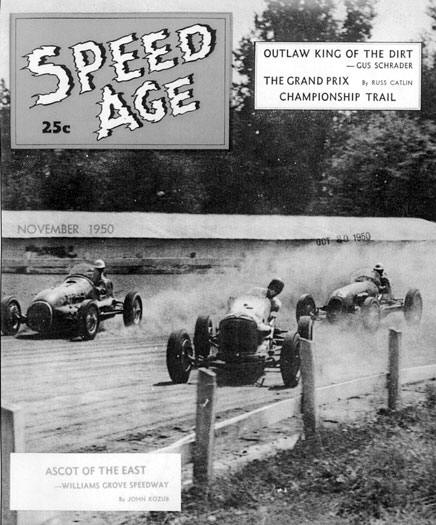 |
|
#1966 - SPEED AGE
magazine was close to biblical in 1950. Its
November cover featured Hank Rogers, Walt Brown,
and Rex Mays at Williams Grove. From INDY
CARS ON SHORT TRACKS, by Buzz Rose and Joe
Heisler. |
|
A |
|
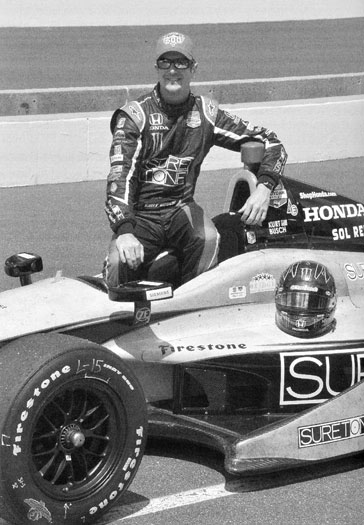 |
|
#1965 - In 2014, Kurt Busch
took a shot at the Brickyard, driving for
Andretti Autosport. “…Then there was the
responsibility of the three-wide start. That was
the first time I’d ever done something like
that, where you have the responsibility of the
three-wide parade and when they drop the green –
that’s the first time I’d really been in all
that dirty air. That was probably the most
intense moment of the month. Everybody was
telling me how it insane it was once the green
flag drops. Then there was also the
responsibility – with guys like Scott Dixon and
Juan Pablo Montoya on my inside. It was like
‘Whoa. Here we are and it’s real. It’s race time
and here we go.” He brought it home sixth,
Rookie of the Year. Photo and Quote from
INDY 500 MEMORIES: An Oral History of “the
Greatest Spectacle in Racing,” by Art
Garner and Marc B. Spiegel |
|
A |
|
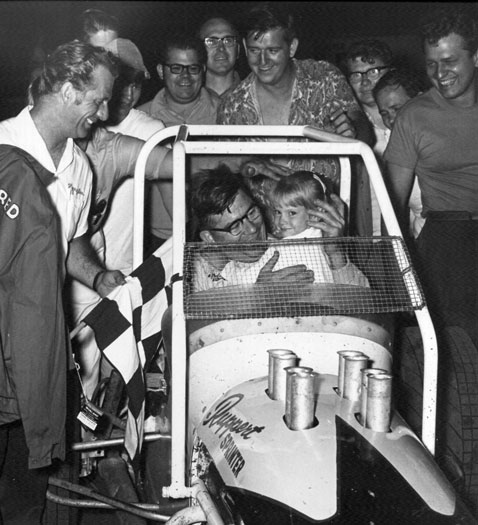 |
|
#1964 - It was an amazing
night at Reading, PA, on the Thursday before
July 4, 1969. The track held a combined URC/ARDC
show to benefit the promising Bob Wilkey who had
died there on May 29. The pits were awash with
Sprinters. A surprise entry among them was
Modified standout Dick Tobias who climbed into
Russ Ruppert’s Hillegass. Toby had never ever
been in a Sprinter, but he qualified handily in
third spot for a 24-car main. Little question he
knew the short route around Reading. He assumed
the lead in the second turn of the first lap and
romped on to the win, to wild applause. In his
words, “I drove the last lap exactly the way I
drove the first. I couldn’t be happier if I had
just won Indianapolis.” His good luck charm for
the evening was his daughter Tina. Quote and
Photo from
TOBY: The Star-Crossed Story of an American
Racing Family, by Lew Boyd (Tobias
Family Collection) |
|
A |
|
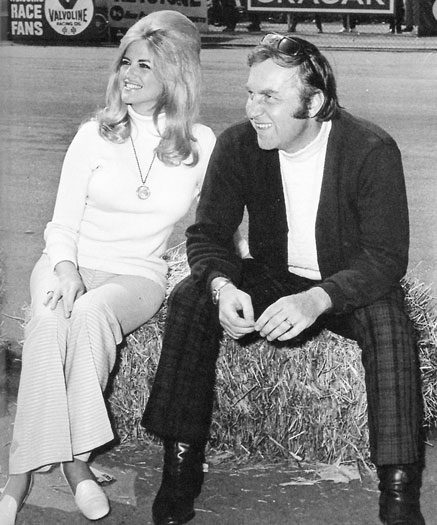 |
|
#1963 - “God bless Brock
Yates. This shot was taken when he came up to do
an interview with me at Bakersfield. Brock and I
started on the story and worked our way through
the pits, when we were told that Garlits got
hurt at Lions, when he lost his foot in a
horrible clutch explosion. So Brock and I jumped
on a plane and went down to the LA airport and
were there when Pat Garlits walked off the
plane. I looked her right in the eyes and never
blinked. She told me later, ‘I knew, Linda, that
if you closed your eyes, I had lost Don.’ I
said, ‘No, we haven’t lost him.’ And then we
went to the hospital.” Quote and Photo from
LINDA VAUGHN: The First Lady of Motorsports,
by Linda Vaughn with Rob Kinnan, Foreword by Don
Garlits. |
|
A |
|
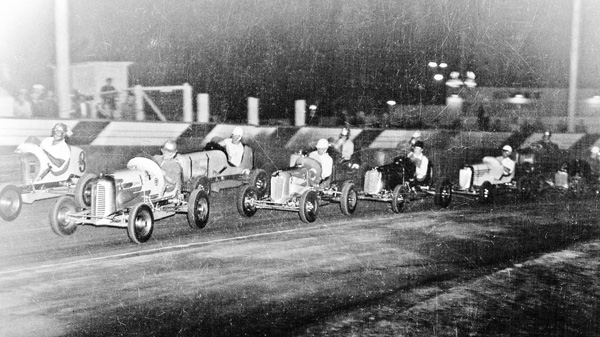 |
|
#1962 - It was a glorious
scene in every way, but “the flower once born
forever dies.” The track was an amazingly
well-appointed 1/5-mile oval built specifically
for the Midgets that were exploding in
popularity in the mid-1930s in California.
Located on Gilmore Island in LA, Gilmore Stadium
held crowds of 18,500. The racing, too, brought
rave reviews. It was aggressive and dangerous,
but sadly dismantled in 1951. Shining stars had
included Ronney Householder, Roy Russing, Curley
Mills, Swede Lindskog, Gilbert Guthrie, and
Billy Betteridge. In this faded photo, popular
Bob Swanson out of Minneapolis was on the point.
The first Turkey Night Grand Prix was held at
Gilmore in 1934, and he won it. Swanson went on
to be the 1935 National Midget Champion, but
died qualifying for a Midget event in Toledo,
Ohio, in June of 1940. In his book
LET ’EM ALL GO, Chris Economaki stated,
“I believe he may be the finest racing driver
America ever produced. I consider it a toss-up
between Swanson and Bob Sweikert, the terrific
driver from California (who died in a Sprint Car
at Salem, Indiana)”. Photo from
ROAR WITH GILMORE: The Story of American’s Most
Unusual Oil Company, by Charles Seims
and Alan Darr. |
|
A |
|
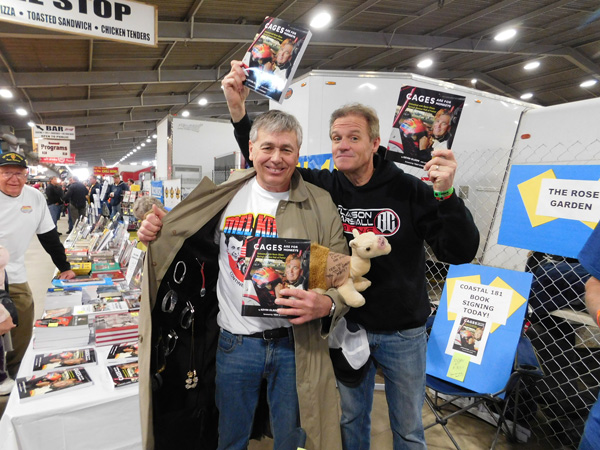 |
|
#1961 - So, we’re bravin’ the
wintry blast and packin’ up for the Chili Bowl
in Tulsa, which runs from January 8 - 13.
Here’s a shot from last year with Kevin Olson
and Kenny Wallace redefining the art of selling
books. This year should really be
something: Page Jones will be with us signing
GODSPEED: The Page Jones Story DVD; Rich
Tobias signing the just-released
TOBY; the Olson Boys, KO and Loren, with
CAGES ARE FOR MONKEYS and
MIDGETS OF WISCONSIN; Dave Darland;
Bentley Warren ...and did someone say Vladimir
Putin? The joint will be jumping! (Coastal 181
Collection) |
|
a |
|
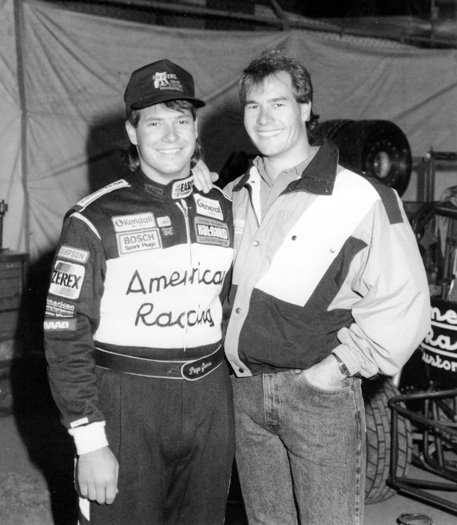 |
|
#1960 - “To an outsider like
me, it was obvious that P.J. (right) and Page
(Jones) had talent, skill, and their father’s
drive to succeed. When the boys reached their
teen years, I remember many a Saturday night at
California short tracks like Ventura Speedway
and Ascot Park, watching the boys as they
polished their trade. The Jones boys not only
shared their father’s speed, but also his
temperament – especially when someone pushed
them a little too far. If you were looking for
trouble, the Jones boys would accommodate.”
Quote by Tom Madigan in PROFESSOR SPEED:
Danny McKeever and the Mind Game of Going Fast,
by Tom Madigan with Andrew Layton (Tom Madigan
Collection) |
|
A |
|
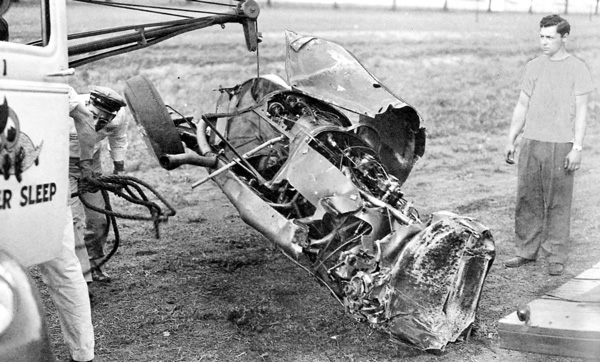 |
|
#1959 - Indianapolis, Indiana – May 2,
1949: “One of the Midwest’s lesser hot
rod/modified drivers, Byron Horne, had another
Granatelli entry, also Mercury-powered. He had
so little experience that his entry smelled like
a rent-a-ride. He ran out of talent in a
micro-second on May 2, the first crash of the
season. His claim to fame was that he nearly
died, not of his injuries, but by choking on his
false teeth. That resulted in an instant new
rule requiring all drivers to remove dentures
before taking to the track.” Quote from
THE ROARING ROADSTERS: The Road to Indy
by Dick Wallen (Dick Wallen Collection) |
|
a |
|
.jpg) |
|
#1958 - This is an open comp
event at Seekonk, MA, Speedway in the early
1970s. It was a dynamic time in Modified racing,
and you can detect the tension about track
rules. The Seekonk entries were A-frame cars
with late model bodies, engines up front, as
seen in the front row. That's Eddie Hoyle on the
pole in the Maverick-skinned Hendrickson
Brothers entry, while Jimmy Wilkins starts on
the outside. They are followed by the red and
white, Red & White Moving Company Camaro, with
the late Ronnie Bouchard at the helm. A little
further back on the outside are three coupes,
more standard flyweight Modifieds of the time
with set-back motors. They came to town from
nearby Connecticut. (RA Silvia Collection,
Johnny Mercury Photo) |
|
a |
|
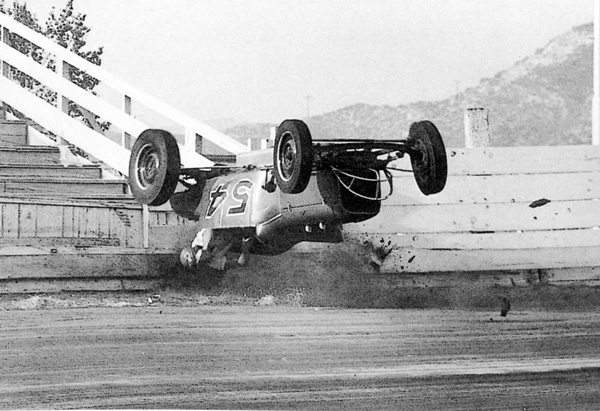 |
|
#1957 - “Although there
were several (pre-war roadster racing)
associations in Southern California, drivers
could be fickle about where they ran. They might
pop back and forth between groups since the
fines in CRA – supposedly $50 – were too small
an impediment. Some drivers used phony names,
but it was hardly worth the trouble. Bob Cross
had a reason of his own for racing as Bob Denny.
His bosses in the telephone company didn’t want
their employees engaging in hazardous
activities. Presumably climbing a telephone pole
wasn’t hazardous. Cross’s girlfriend’s surname
was Denny, so he reversed the usual process, and
took her name.” Hope the corporate head of Human
Resources didn’t notice Cross this day at
Bonelli Stadium. (Photo and Quote from
ROARING ROADSTERS: The Road to Indy, by
Dick Wallen. (Dick Wallen Collection) |
|
a |
|
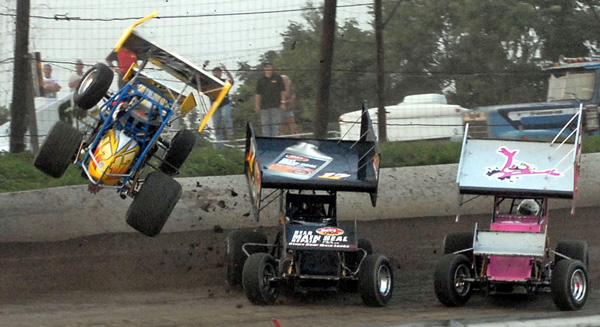 |
|
#1956 - Competition on the
1/3-mile dirt of 54-year old Grandview Speedway
in Bechtelsville, PA, has always been racy – and
often on the aggressive side. URC dates have
been no exception. The Sprinters came to town on
July 26, 2008, and Denny Garl put on quite a
high-flying show. Becca Anderson and the late
Kramer Williamson quite properly decided to go
low. (Photo by Frank Simek, our Man with the
Hat) |
|
A |
|
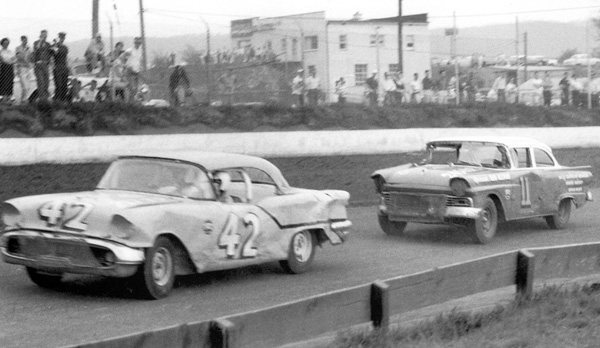 |
|
#1955 - It really happened.
Twice – on June 15, 1958 and April 26, 1959.
NASCAR’s Grand National stalwarts pulled into
the half-miler located at the Reading, PA,
Fairgrounds. That’s Lee Petty in his familiar
#42 chased by Junior Johnson. Johnson’s ’57 Ford
was a little faster the second year, and his
average speed remains the NASCAR track record –
53.768 mph. Photo from STRAPPED IN,
June 2006. (Marburger Collection) |
|
A |
|
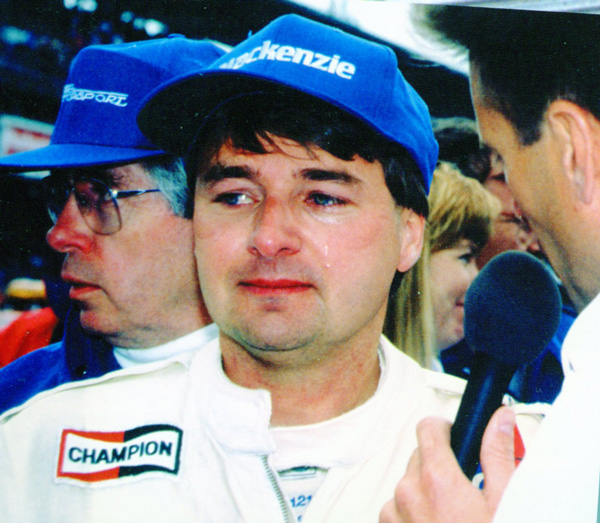 |
|
#1954 - It really was close
– .043 of a second – and the closest finish in
the history of the Brickyard. Personable,
popular Canadian racer Scott Goodyear had just
been beaten at the line in 1992. Photo from
AUTO COURSE: THE OFFICIAL HISTORY OF THE
INDIANAPOLIS 500, Second Edition, by Donald
Davidson and Rich Shaffer (IMS Collection) |
|
a |
|
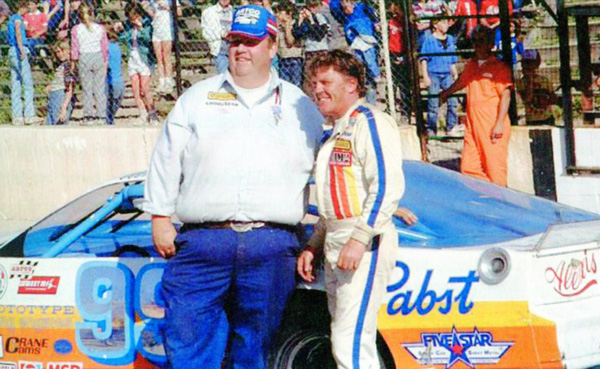 |
|
#1953 - “Victor Getzloff
(Left) and his brother, Albert, were hitchhiking
to the races at the track in Adams-Friendship
near their rural Bancroft home in Central
Wisconsin in the late 1950s. Just twelve years
old at the time, the brothers were picked up by
a man who was en route to the track – with a
race car tugging behind a pickup truck with a
not-so-sturdy tow chain. ‘Hop in guys,’ said the
stranger. The Getzloff boys climbed inside the
race car that was being towed. They were just
happy to get a lift to the races. Little did
Albert know that the man picking them up, the
late Richard Trickle (Right), would eventually
team up with ‘Bib Vic’ as his crew chief years
later and form one of the most dominant teams in
the history of short track racing in America.”
From WISCONSIN INTERNATIONAL RACEWAY: Where
the Big Ones Run! by Joe Verdegan (Bob
Bergeron Photo) |
|
A |
|
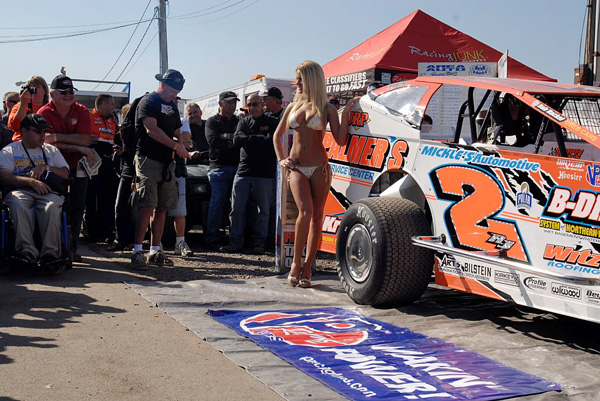 |
|
#1952 - Our buddy Otto
Graham sure has a way of uncovering great
images. How about this one he took at Super DIRT
Week at Syracuse in 2011? |
|
a |
|
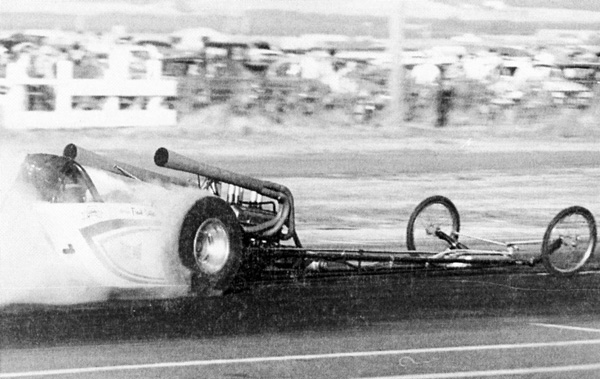 |
|
#1951 - “I did the welding and built
the exhaust system on Jack Costella’s
well-designed little Midget (gas class)
Dragster. It had a 190-inch wheelbase and
weighed only 800 pounds. It was driven by a
Wilkinson 350 cubic-inch Chevy small block, with
12x5.50 Midget tires on the rear and 17x1.75
bicycle rims on the front. It was one of the
first dragsters with no suspension, and the
front axle was set without the extreme caster
used by customary dragsters at the time. There
was no transmission; it was also one of the
first dragsters to use direct drive…..When Jack
first appeared at Fremont (CA) Raceway with the
car, race officials went into brain spasms about
the frame being joined with nickel-silver-bronze
and not heli-welded. I had sold Jack on the
brazing concept to gain joint surface area on
the .02-thin tubing he used in the fame
construction. The exceptional strength and
ductility of nickel-silver-bronze was not well
known at the time. We worked up some sample
joints of the frame tubing both heli-welded and
brazed as well as a destruction test that Jack
could perform with the test joint clamped in a
vice mounted on the tailgate of his pickup truck
and a ten foot lever. He performed this
demonstration at the drag strip for the
officials. It proved by a light year that the
brazed joints were superior…. Frank Santos was
the original driver and set the top gas record
in 1962 at Fremont at 196mph with an elapse time
of 8.6 seconds. After Santos went into the Navy,
Dave Uyehara drove the car to numerous top gas
wins and actually was top eliminator over all
classes on occasion.” Quote and Photo from
GEORGE BENSON: THE RACING YEARS - A Memoir of
the Life and Times of a Racer 1952-1987,
by George Benson (Rich Welch Photo, circa 1963) |
|
a |
|
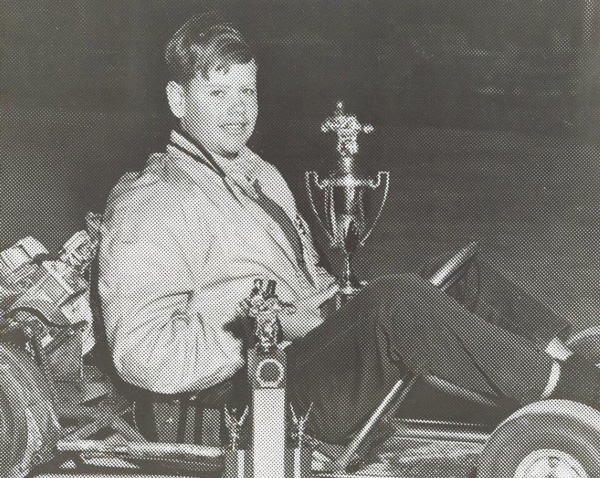 |
|
#1950 - That Dave Lape out in
Canajoharie, New York, sure collected a room
full of trophies. Back in the late 1960s, he
chased NASCAR national points with a best finish
of fifth. He subsequently joined the church of
the clay full-time and was a DIRT front runner
for the next four and a half decades. Here he
was as a teeny-bopper – full head of hair,
rather full around the mid-section, and winning
already. (Jessica Lape Collection) |
|
A |
|
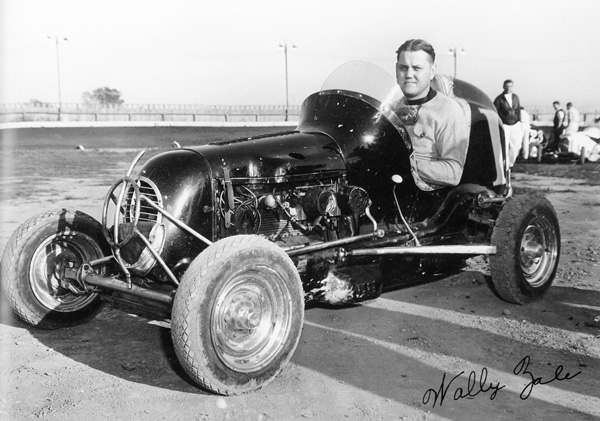 |
|
#1949 - “Wally Zale was best
known as the leader of the Chicago Gang, a group
of Midget drivers from the Chicago area. He won
65 Midget features in 1936, 47 in 1939. His best
year was 1940 with 67 feature wins and 59 more
in 1941. Zale and Frank Perone were killed when
their passenger car was struck by a train in
April of 1942.” Quote and Photo from
HARD DRIVING MEN: Images of Speed 1895-1960,
by Dick Wallen. (Dick Wallen Collection) |
|
a |
|
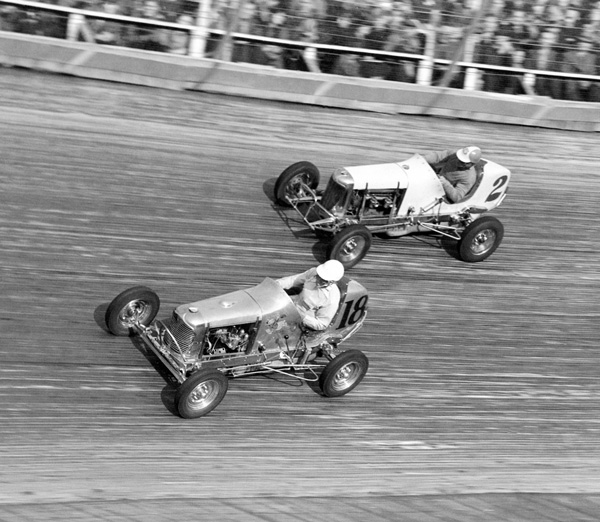 |
|
#1948 - Big boys battle on
the boards. Neither Duane Carter (#18) nor Paul
Russo set it up with a push at Nutley, NJ, in
1938, and they went very fast. Photo from
HARD DRIVING MEN: Images of Speed 1895-1960,
by Dick Wallen. (Dick Wallen Collection) |
|
A |
|
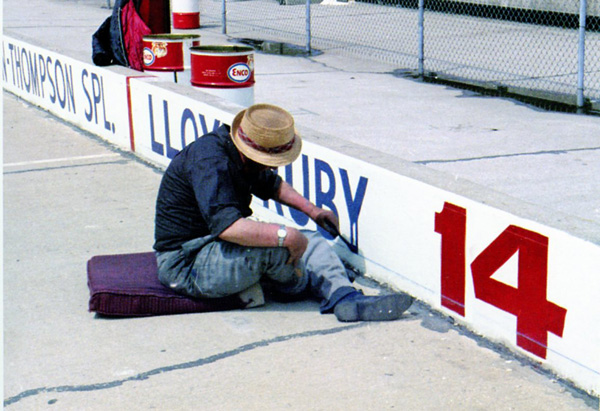 |
|
#1947 - That’s Lloyd Ruby’s
name being painted on the pit-lane wall in
advance of the Indy 500 in 1966. The laid-back
Texan would run the event 18 times, leading the
parade 18 times in five different races for a
total of 526 laps. He pulled down a third in
1964, but, when he passed away at 81 in Wichita
in 2009, he was remembered as the greatest
driver never to win it. From
HARD LUCK LLOYD: The Complete Story of
Slow-Talking, Fast-Driving Texan Lloyd Ruby,
by John Lingle (Indianapolis Motor Speedway
Collection) |
|
a |
|
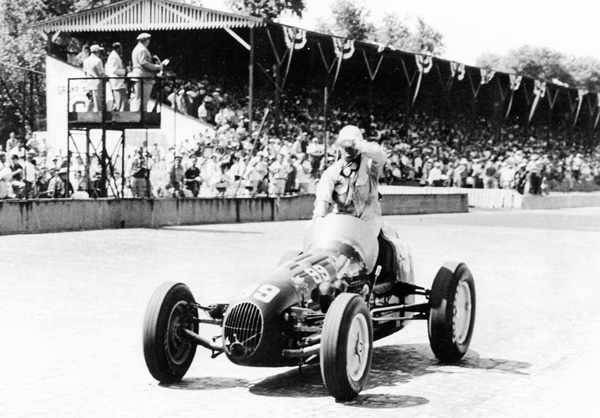 |
|
#1946 - “The win [at Indy in
1951] did not come easily for Lee Wallard in
spite of the fact that he led for 159 laps. The
left rear shock broke, giving him a terrible
pounding…the exhaust pipe broke…and the brakes
gave out….He took the checkered flag with three
minutes to spare over Nazaruk…and shut the
engine off in turn four, climbed up on the tail
of the car, and then drifted, brakeless, down
past the pits…towards Victory Lane. He was in
quite a bit of discomfort. Although
fire-retardant uniforms were not mandatory in
those days, he wore one… (which had) abrasive
blotches. The constant pounding of the bricks,
coupled with the fact that he did not wear an
undershirt, caused his skin to be severely
chafed. After the victory ceremonies were over,
he went to the infield hospital, where he was
rubbed down with liniment. He then climbed on
the scales and discovered he had lost 15 pounds
since breakfast. Earlier, he had quipped that
due to having carried block after block while
building his own house over the last few months,
he estimated he was one inch shorter than he had
been in 1950.” Quote and photo from
AUTOCOURSE – OFFICIAL HISTORY OF THE
INDIANAPOLIS 500, Second Edition, by Donald
Davidson and Rick Shaffer. |
|
A |
|
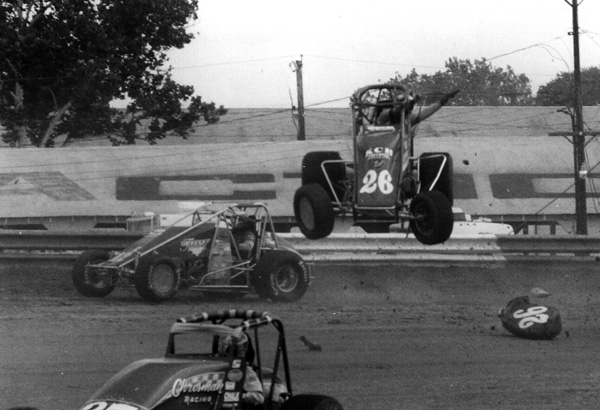 |
|
#1945 - Peril everywhere!
“Ohio racer Todd Kane not only loses his tank at
Terre Haute, but his arm restraint is not
impressing anybody.” Quote from
DID YOU SEE THAT? Unforgettable Moments in
Midwest Open-Wheel Racing, by Joyce
Standridge. (Allen Horcher Photo) |
|
a |
|
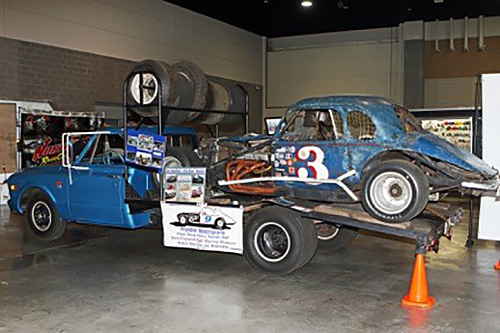 |
|
#1944 - Everyone’s favorite,
Rhode Island’s soft-spoken, ever-smilin’ Ric
Mariscal founded the ProNyne Racing Museum in
Pawtucket, is a major force with the New England
Auto Racing Hall of Fame, and a Director and Ex
Comm member of the North East Motor Sports
Museum in New Hampshire. But he wasn’t always
that way. For years he was the consummate local
racer in stock cars, Figure Eights, and sports
cars. Then one day – by chance – he was asked to
take the late Lenny Boehler’s iconic Old Blue #3
Modified to a vintage event at New
London-Waterford Speedbowl. He climbed in and,
wheeling down the backstretch, was overcome with
a kind of spiritual moment. “My life changed,”
he recalls. He sold all his cars and launched
into his selfless, preservationist period. He
has pleased thousands and thousands of people.
Just this weekend he parked the pleasingly
industrial and un-chromed Ole Blue on its
original hauler in the middle of the floor of
the New England Racer Auction and Trade Show in
Springfield, MA. It almost seemed to shimmer
with memories. (Photo by Dick Ayers) |
|
A |
|
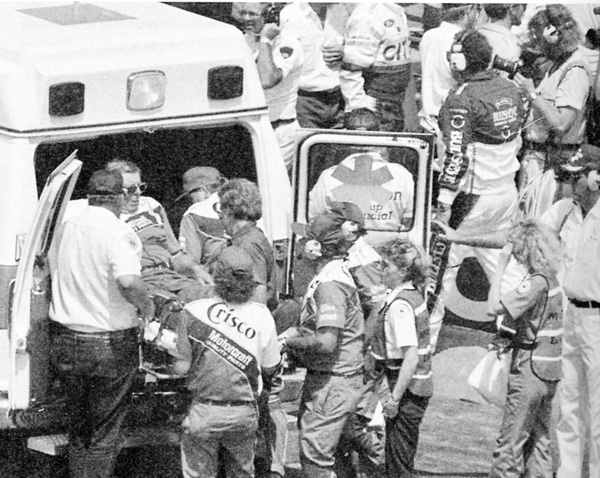 |
|
#1943 - It was the moment of the late Bud
Moore’s only racing injury: At the World 600 in
1988 race leader Brett Bodine slid on pit road
and clobbered Bud, his boss, launching him into
the Wood Brothers’ pit, over the fence, and into
the air bottles. He is shown here (in sun
glasses) being loaded into the ambulance with a
broken leg. When everyone had coming running
over to help him, Bud yelled, "Don’t come over
here messing with me! Get that car out of the
pits!" Turns out that the race was almost
halfway, and Brett was able to motor on and
capture the $10,000 bonus for leading. Bud,
though, was hurt so badly that he had to learn
to walk again during weeks of rehabilitation.
Quote and Photo from
BUD MOORE: Memoir of a Country Mechanic from
D-Day to NASCAR Glory, by Bud Moore with
Perry Allen Wood. (Photo Courtesy Davie Hinshaw,
Charlotte Observer Collection,
Robinson-Spangler Carolina Room, Charlotte
Mecklenburg Library) |
|
A |
|
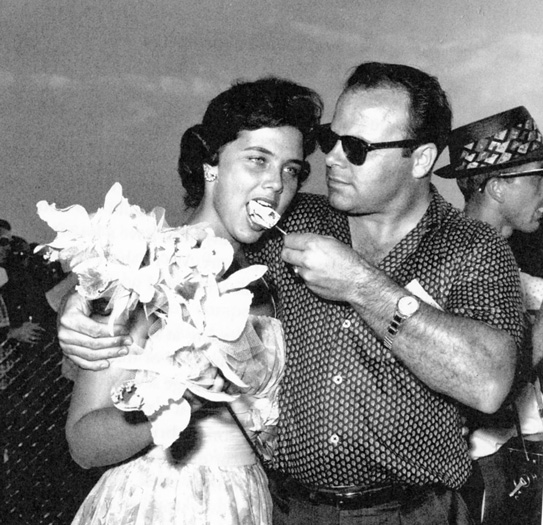 |
|
#1942 - Bruton Smith and
Curtis Turner staged the first World 600 at
Charlotte in 1960. Curiously, prior to a rather
big moment of the green flag, Smith shared ice
cream with Rita Souther, Miss World 600. There
was actually a back story to the moment. Turns
out that Smith grew up in Oakboro, North
Carolina, on a cotton farm in very modest
circumstance. At school, he became infatuated
with Eskimo Pies, which his classmates devoured
at ten cents apiece, but he could never afford
any. He speculated in a 1997 interview, “I
wanted to one day reach a goal in life where if
I wanted an Eskimo Pie I could buy one.” Quote
from
CHARLOTTE MOTOR SPEEDWAY: From Granite to Gold,
by Deb Williams. (Photo CMS Archives) |
|
A |
|
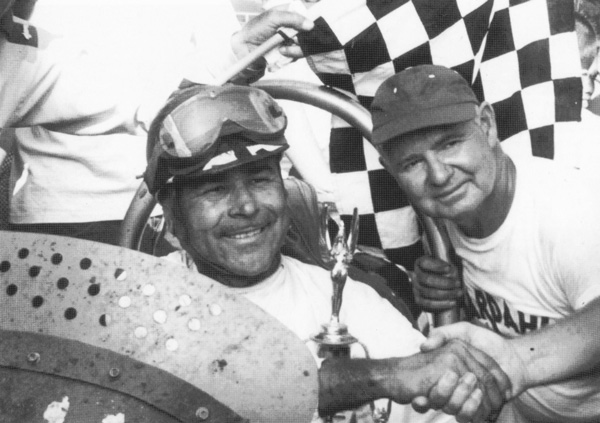 |
|
#1941 - An early sixties
shot for the ages. Floridian “Pistol Peter”
Folse in victory lane at Sedalia in 1960 with
Hector Honoré, owner of the fabled “Black Deuce”
Bardahl Sprinter. “Folse, the man who had worn
flashy clothes, partied with the best of them
and was well-regarded within Sprint Car racing,
received his real fame, though, beginning in
1959, when he replaced Bobby Grim as the pilot
of Honoré’s Bardahl Special. Pete won three
straight IMCA point championships, and followed
that with two consecutive runner-up positions.
His five years of rimriding with Honoré’s
Offenhauser produced 111 features, mostly with
IMCA. Quote from National Sprint Car Hall of
Fame and Museum, Photo from
BIG CAR THUNDER: Sprint Cars on American’s
Fair Circuits, Volume 1, by
Bob Mays. (Lou Ash Photo) |
|
A |
|
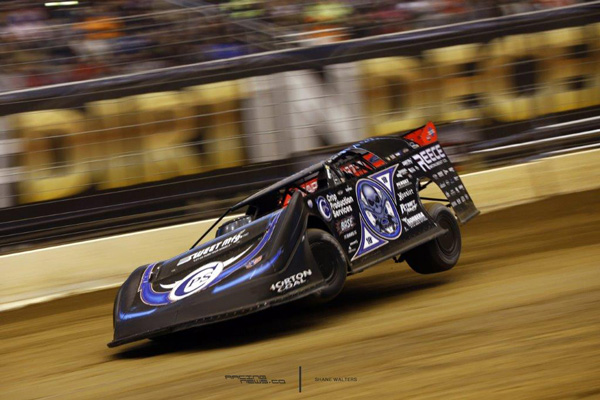 |
|
#1940 - Was Scott Bloomquist on the
hammer at the Gateway Dirt Nationals in 2016? A
way cool photo by Shane Walters. |
|
A |
|
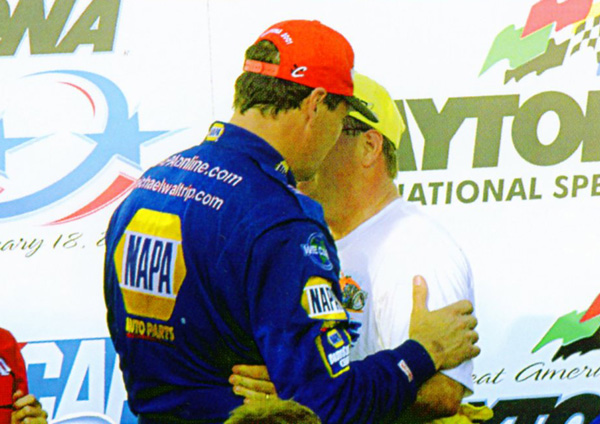 |
|
#1939 - It was just after the final lap
of the tragic Daytona 500 in 2001. “A shaken Ken
Schrader made his way to victory lane and shared
the stunning news (about Dale Earnhardt) in a
quiet moment with race winner Michael Waltrip.
In an instant the celebration of Waltrip’s first
Winston Cup victory in the sport’s biggest race
was over.” Quote and Photo from
DALE vs. DAYTONA: The Intimidator’s Quest to Win
the Great American Race, by Rick
Houston. (Photo courtesy of Jeff Robinson, BRH
Racing Archives) |
|
A |
|
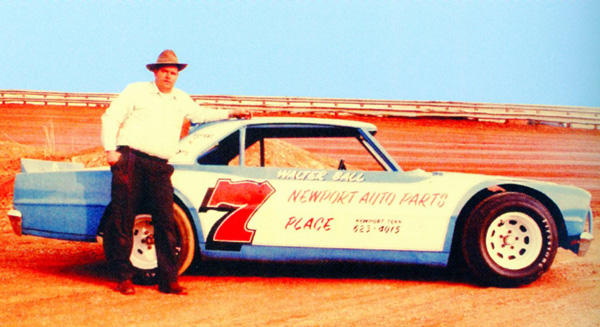 |
|
#1938 - Walter Ball was some
kind of gasser. The Johnson City, TN, native
reportedly won over 400 features and
championships at six tracks in Tennessee and
Virginia. His peak year came in 1977 when he won
19 shows in 21 starts on the sloped banks of
banks of Volunteer Speedway in Bulls Gap, TN.
Later, helmet on the hook, he crewchiefed son
Dale to victory, and they became Volunteer’s
first father/son champs. He passed away there at
the Speedway on his seventieth birthday of a
heart attack. Photo from
A HISTORY OF EAST TENNESSEE AUTO RACING: The
Thrill of the Mountains, by David
McGee. (Walter Ball Family Collection) |
|
A |
|
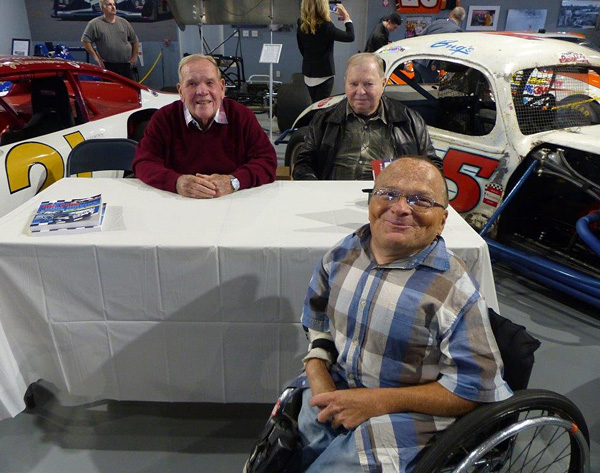 |
|
#1937 - "Rapid" Rick Raducha
is unquestionably one of the most outgoing and
popular racing personalities on the East Coast.
He's shown here at the recent "Legends Day" at
the North East Motor Sports Museum, with the
great New England wheelmen, George Summers
(Left) and Bugsy Stevens in the background. Rick
sports a constant 10,000-watt smile, though he
is savaged by osteogenesis imperfecta, causing
severe bone brittleness. He has suffered over
200 fractures. Still, he grinds away daily with
his Driver Connection marketing business and his
"Rapid Raceway" slot car activities. Rick's
sister, Dawn, has launched a fund-raising
campaign so that a van can be purchased that
will allow much fuller mobility for Rick and his
wheelchair. The vehicle will come to about
$60,000, and so far approximately $10,000 has
been donated. Please help out however you can.
Contributions go to: Rick Raducha, 106
Pierremount Ave, New Britain, CT 06053 (Don
White Photo) |
|
A |
|
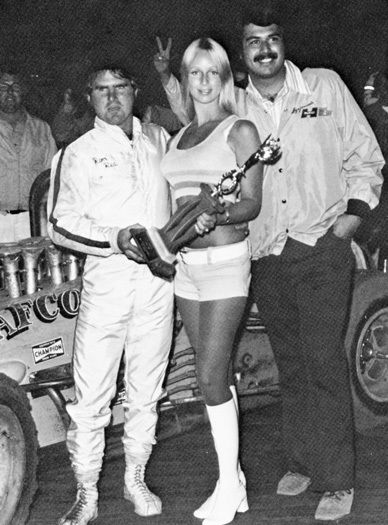 |
|
#1936 - So what’s with Ron
Rea? The normally smilin’, well-traveled
“California Cowboy” was the most prolific winner
at Ascot in 1972. Here he had just won the
trophy dash and the “Firecracker 50” and was
joined in victory lane by comely Sandy Bargett
and assistant general manager, J.C. Agajanian
Jr. Everyone else seemed to be having a pretty
good time…. From RACING PICTORIAL – 1972
Fall Edition. (Photo by Hal Lane) |
|
a |
|
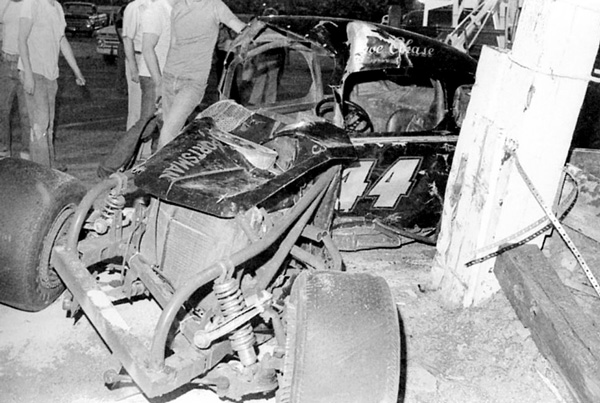 |
|
#1935 - Long slide, short
stop. Dave Chase was on the hammer in his
classic-looking #444 coupe on the backstretch at
Connecticut’s New London-Waterford Speedbowl in
1977 when he got sideways and clobbered the pit
gate big time. He was badly injured – and never
returned to racing. The track removed the exit.
From
MODIFIED STOCK CARS of the ’60s and ’70s,
by Steve Kennedy. |
|
a |
|
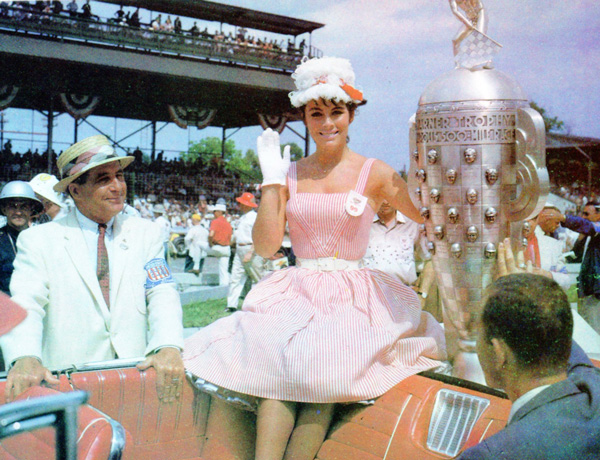 |
|
#1934 - That was the Borg
Warner trophy at the time of the start of the
’59 Indy 500. The next visage to be embossed on
it would be the day’s winner, Rodger Ward. Back
then roadsters ruled the day, red-leather seats
were popular, and white gloves were fashionable.
But some things never change. Chief Steward
Harlan Fengler’s appreciation for race queen
Erin O’Brien is obvious, as everyone’s would be
today. From UNITED STATES AUTO CLUB RACING
PICTORIAL – 1959. (Ray Mann Photo) |
|
A |
|
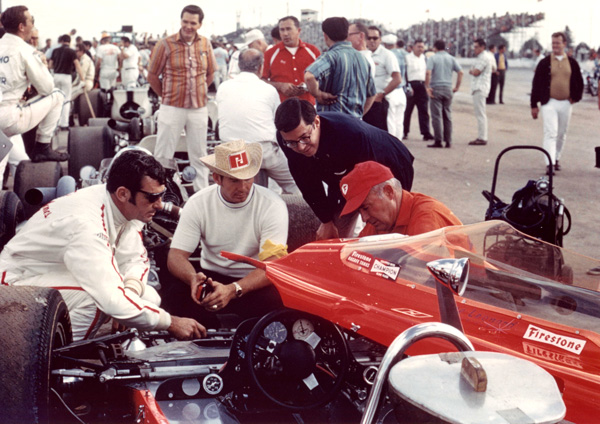 |
|
#1933 - That’s Joe Leonard in the
Nomex and Parnelli Jones in the headgear,
checking out the right front. Here’s what Dan
Gurney had to say about Leonard’s arrival at
Indy: “In order to pass his rookie test, he had
to pass a mandatory physical examination and
vision test administered by Dr. Thomas Hanna,
the esteemed medical authority at the Speedway.
And Joe had a flaw and a big one, very poor
eyesight. Without passing, Joe would not get
permission to race. I took it upon myself to
lobby and convince old Doc Hanna to let him take
his driver’s test anyway. Doc could not let Joe
pass without compromising Speedway regulations.
But he had wisdom and he looked at Joe’s racing
achievements which belied his lack of reasonable
vision and tried to find a solution. He came up
with some special Coke-bottle glasses for Joe to
wear, which enabled him to pass his vision and
rookie tests with flying colors. We called them
the two-and-half milers. From that day forward,
when Joe showed up in Gasoline Alley early in
the morning, we greeted him by singing, ‘Jose
can you see?’” Photo from
As A Matter Of Fact, I Am Parnelli Jones,
by Bones Bourcier (Hugh Baird Photo, Parnelli
Jones Collection), Quote from
INDY 500 MEMORIES: An Oral History of “The
Greatest Spectacle in Racing,” by Art
Garner and Marc B. Spiegel |
|
A |
|
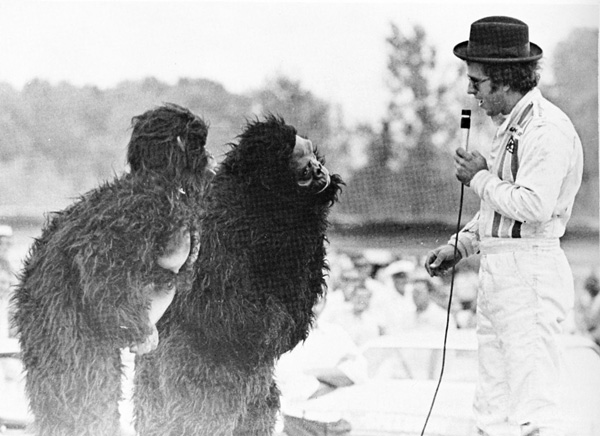 |
|
#1932 - Back in the ’70s,
lensmen extraordinaire Gene Crucean and John
Mahoney spearheaded a neat publication called
Sprint Car Pictorial. Their 1976 edition carries
this rather remarkable image of “Preacher”
Pancho Carter. It is said he was officiating
“the marriage of the apes” at the season finale
at Eldora. The caption points out that promoter
Earl Baltes had a “fertile imagination.” Has
neo-owner Tony Stewart matched that? (Rick Lane
Photo) |
|
A |
|
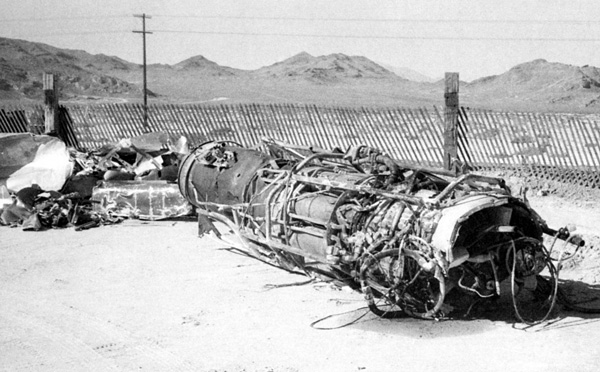 |
|
#1931 - In September
of 1962, a daring, young, recently married
hotrodder, biker, and jalopy racer from
California climbed into a thundering J-7 jet
engine-powered land-speed car at Bonneville.
Glenn Leasher was intent on achieving fame and
fortune – and he would go flat out so to do.
After a couple of unsuccessful runs, Leasher
terrified his crew by roaring by them at
enormous speed far beyond the beginning of the
measured mile. Their concern was justified. The
car drifted off into the ungraded salt, and
Leasher still did not lift or deploy the chute.
Instead there was an explosion of sand, eruption
of the fuel tank, and the most horrific crash
ever at Bonneville. Leasher died. Remains of
“the Infinity” are shown at a Utah Highway
Department storage yard. From
SPEED DUEL: The Inside Story of the Land Speed
Record in the Sixties, by Samuel
Hawley. |
|
A |
|
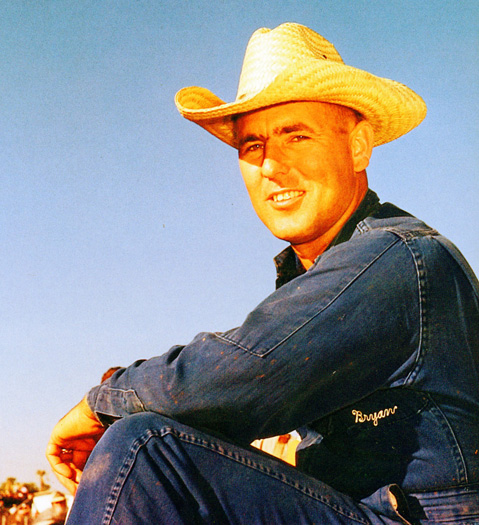 |
|
#1930 - “In one of his early URA Red
Circuit soirees at Fresno, California, Jimmy
Bryan, ‘the Arizona Cowboy,’ had heard about the
Vukovich boys and wasn’t really surprised when
Bill rammed him with a wheel in a non-too-subtle
manner. But Bill was surprised to find a wheel
stuffed right back at him, and this
back-and-forth banging continued throughout the
feature. After the race, Jim headed for the pits
and fully expected to have to fight half of
Fresno, especially when he saw Vuky striding
purposefully toward him, still wearing his
helmet. (This was a trait of Vuky’s; once the
evening’s racing began, he rarely took his
helmet off.) All Bryan saw, however, was the
swiftly approaching Vukovich, and he looked
around for a wrench in case he had to protect
himself. The grim look on Vuky’s face was
misleading. When he got to Bryan, he stuck out
his hand. ‘Son of a bitch, that’s how I like to
race!’ enthused Vuky. ‘Good job, Kid!’ They
shook hands, and Vukovich strode off. A slow
grin spread over Bryan’s tanned face. He’d just
received the best compliment of his young
career.” Quote and photos from
THE FABUILOUS FIFTIES: American Championship
Racing, by Dick Wallen. |
|
A |
|
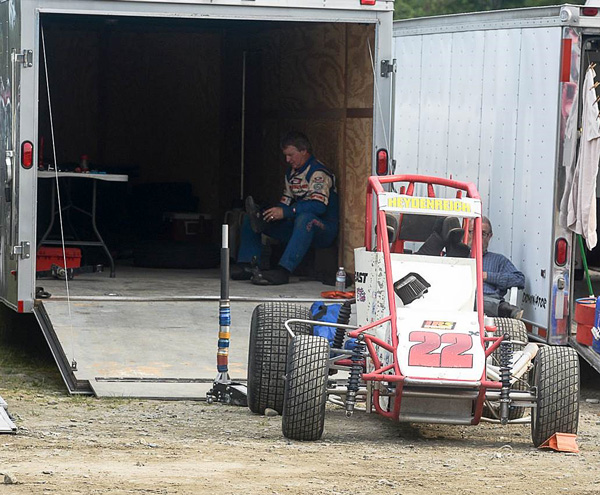 |
|
#1929 - John “Hot Rod” Heydenreich, a
60-something export from Bloomsburg, PA, to the
Midwest and USAC, has been racing forever. He
won the Hut Hundred in 1978, the Chili Bowl in
1990, set a Sprint Car record at Eldora – and he
still makes the dirt fly in open-wheelers. Here
he is suiting up for the millionth time – on
this occasion for a DMA/USAC show at a lively,
old-time quarter-miler in Vermont, Bear Ridge
Speedway. (Photo by Photographer par Excellence,
John DaDalt) |
|
a |
|
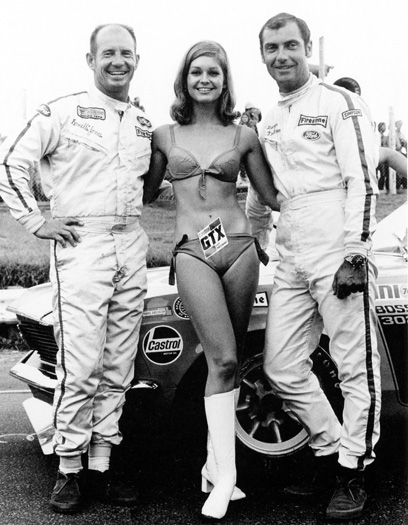 |
|
#1928 - That’s Parnelli Jones (L) and
George Follmer. They were the hot setup in
1969/1970 Trans-Am racing. Parnelli recalled in
2013: “Overall, George and I had plenty of good
times. Back in the day, Judy and I socialized
with him a lot…. We still do some vintage racing
together, and that is always a kick for us,
sometimes not so much for the car owners. The
only real difference between racing vintage and
the old days is the fact that we now don’t have
girls hanging around the pits and we don’t have
to tell George, ‘Come on, George, leave the
girls alone and get into the car. It’s time to
go racing.’” Quote and Photo from
FOLLMER: American Wheel Man, by Tom
Madigan. (Follmer Collection) |
|
A |
|
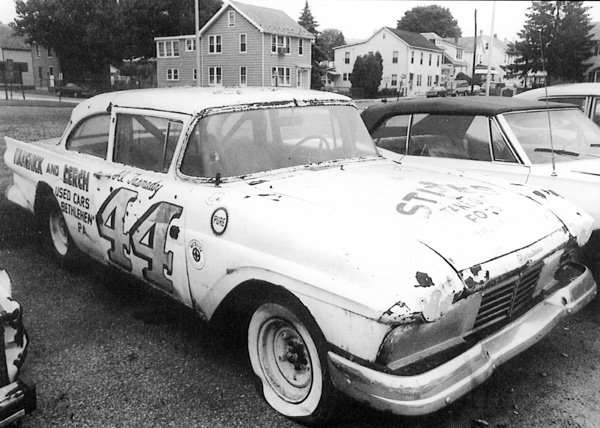 |
|
#1927 - You never know just what’s
gonna show up in a parking lot in New Jersey.
This Hanchick & Lerch-funded ’57 Ford was driven
by Al Tasnady in the 1964 Sportsman/Modified
200. Note the trick aero work on the top of the
front fenders and over the headlights. Tas had
also run a factory-backed ’57 Plymouth
Convertible on the beach – and a Modified on the
road course. He retired in 1972 with 400
victories under his belt. From STRAPPED IN,
December 2006. (Shultz Photo) |
|
4 |
|
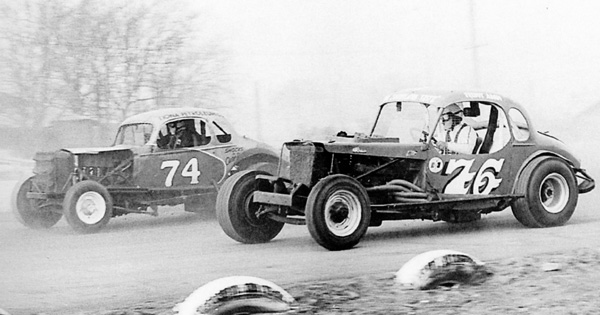 |
|
#1926 - On the gas one day at Reading.
Masked marvels Freddy Adam (#76) and Budd Olsen.
From STRAPPED IN, October 2012.
(Zellers Photo) |
|
a |
|
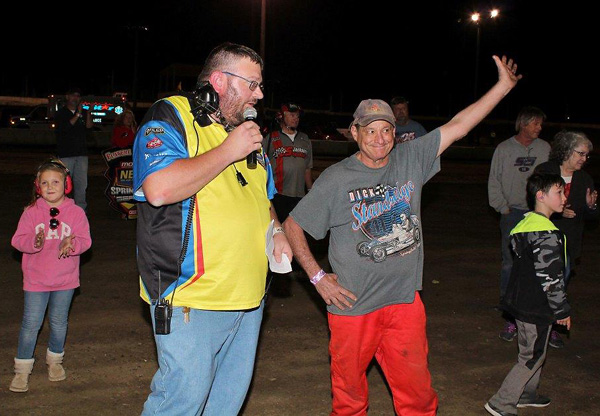 |
|
#1925 - No question that Rick
Standridge out of Collinsville, Illinois, is one
of America's all-time coolest short-trackers.
His bride, Joyce, stopped counting his feature
trophies at 200. This year he reached 50 – 50
years of racing, that is – still with a
50-year-old budget. A couple of weeks back he
was warmly honored by announcer Dewain Hullett
and an enthusiastic crowd at Jacksonville (Ill)
Speedway, one of the very first tracks he
frequented. (Standridge Family Collection) |
|
A |
|
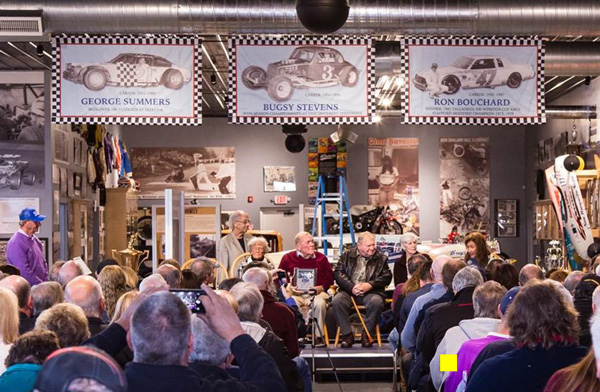 |
|
#1924 - This past Saturday’s “Legends
Day” at the recently opened North East Motor
Sports Museum in Loudon, NH, had to be one of
the most emotional racing gatherings ever.
World-class oval-trackers George Summers, Carl
“Bugsy Stevens” Berghman, and the late Ronnie
Bouchard, known as “the Three Amigos,” were
honored. In the image above, Dick Berggren, Russ
Conway, Maggie Summers, George, Bugsy, and Doris
Berghman listen as Paula Bouchard reads a
poignant memory of her husband. There was a
smile on every face – and a wee tear in each eye
– as everyone left after the sold-out,
interactive four-hour affair. (Scott Patten
Photo) |
|
a |
|
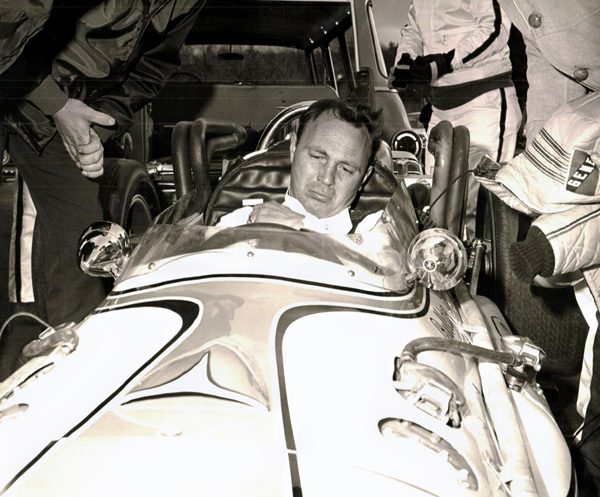 |
|
#1923 - That’s the late Gene
Bergin, one of New England’s finest all-time
short-trackers, getting ready to test talented
rookie owner Jim Jorgensen’s “Swamp Yankee”
Chevy Indy Car at Stafford (CT) Speedway back in
1968. Gene did not look all that comfortable.
That became even more apparent when they went to
Milwaukee, attempting to qualify on the
billiard-table flat fairground mile. “No matter
what Gene did, the car pushed badly in the
corners. Gene felt the solution was the same
thing he’d always done: manhandle the thing and
let the rear end hang out. The harder Gene
tried, the worse it got. Every time he went out,
the car went slower. They didn’t make the show,
and Gene erupted. He picked up a bucket of water
and threw it at the car. The pits were full of
TV and media. The car’s co-owner, Buzz Harvey,
who was trying to project a professional image
to attract sponsors, didn’t appreciate the
meltdown. Opinions vary on what happened, but at
the end of the day, Bergin was out.” Quote and
Photo from
SWAMP YANKEE: The Racing Life of Jim Jorgensen,
by Walt Scadden. (Jim Jorgensen Collection) |
|
A |
|
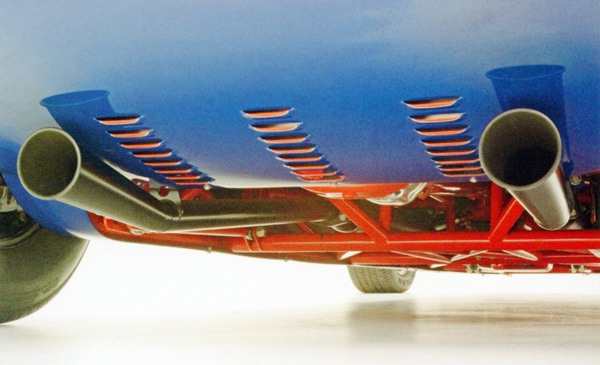 |
|
#1922 - Pretty! If you could see
what sits atop this tubular space frame chassis,
it would be a drop-dead beautiful ’32 Roadster
called “Roadchamp.” It is owned by Steve Moal of
Moal Coachbuilders in Oakland, CA. Photo from
DEUCE: The Original Hot Rod: 32 x32, by
Mike Case. |
|
A |
|
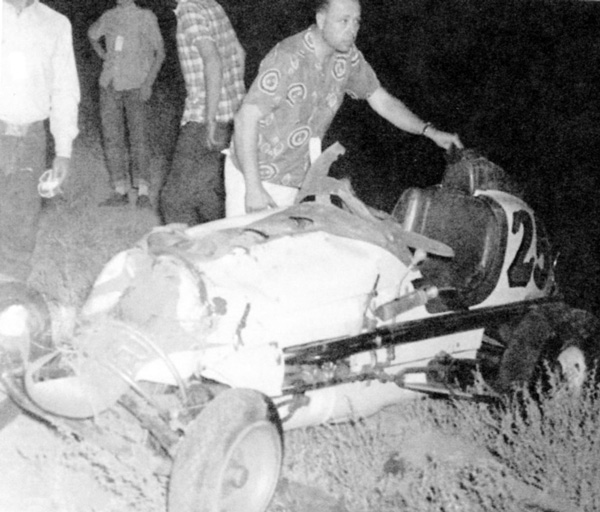 |
|
#1921 - Sometimes a bad night can
throw the green to a just plain bad weekend.
Such was the case in 1954 when Don Edmunds towed
his Midget into the 5/8 mile portion of the 1.4
mile asphalt tri-oval at Marchbanks Stadium in
Hanford, CA. He took time never having been on
the track before. With the advice of Billy
Cantrel to “drive it like dirt”, he slid around
turn one, the rear pointed to the wall. He was
fast. But in the next turn, it didn’t work, and
over the banking he went. He landed under car,
but fortunately his head was somewhat protected
by a slight hole in the ground. URA car owner
Bob Sorenson is shown inspecting the busted up
car. Following a night in the crash house,
Edmunds was released but still beaten up. His
crew arranged a station wagon equipped with a
mattress in back to drive him home. That’s when
they got T-boned at an intersection by a pickup
truck. The wagon flew off the road, and Edmunds
off his couch. Ouch. Photo from
THE SAGA OF ROTTEN RED: The Don Edmunds Story,
by Paul Weisel, Jr. |
|
a |
|
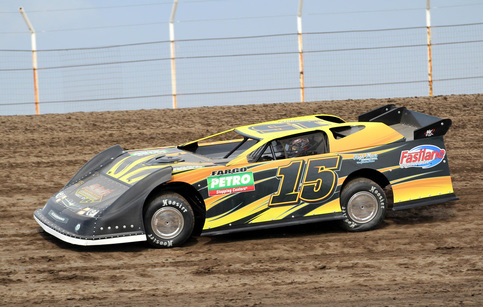 |
|
#1920 - We all know him as the longest
continually running competitor on the World of
Outlaws tour, but 235 Sprint Car wins ago, Donny
Schatz wheeled Late Models. He’s shown here at
River Cities Speedway in Grand Forks, North
Dakota. He was WISSOTA Rookie of the Year in
1993 and Champion just three seasons later.
Photo from
TODAY’S SPRINT KINGS, by Gerald Hodges |
|
a |
|
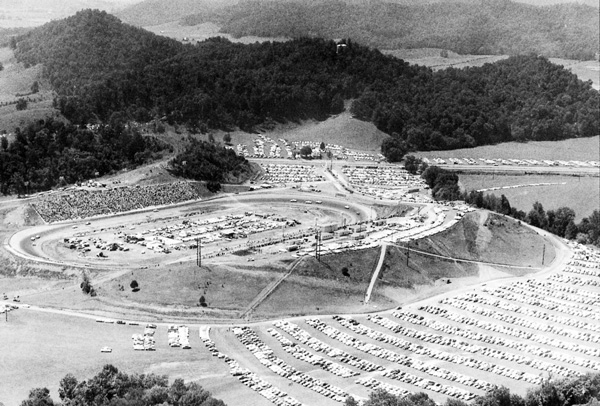 |
|
#1919 - This is how it
looked in the mountainous Tri-Cities area of
Tennessee in the spring of 1965. Bristol
International Speedway had been operating for
four years. A capacity crowd of just under
20,000 showed up to watch Junior Johnson snag
the Southeastern 500 on May 2. From NASCAR –
The Complete History, by Greg Fielden. |
|
A |
|
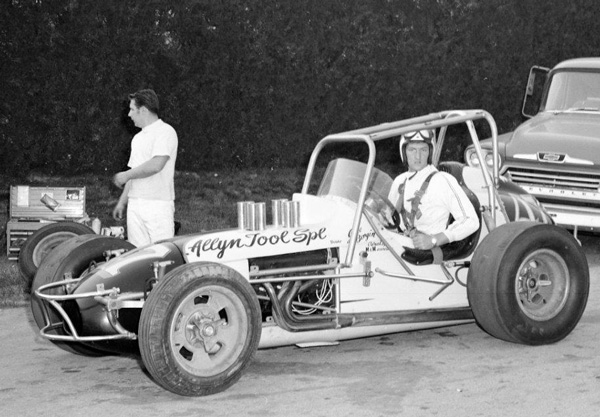 |
|
#1918 - Here's a neat shot
from our Quaker State buddy, Dale Snyder. That's
Bentley Warren in the Connecticut-based Allyn
Tool Sprinter owned by Skip Matczak at Pennsylvania's Hershey Stadium
on May 28, 1969. If their tool box and single
spare tire seem a bit modest, Skip has an
explanation. Money was beyond tight for the team
back then, and they had to get creative, even
with travel logistics. While on the road, they
would typically sneak into motels about eight in
the morning and look for a room just vacated.
They'd hang a 'Do not Disturb' on the door,
shower, and wash off all that clay from the
night before. The two had some fine runs,
though, and Bentley was on his way to the
Brickyard. (Dale Snyder Photo) |
|
A |
|
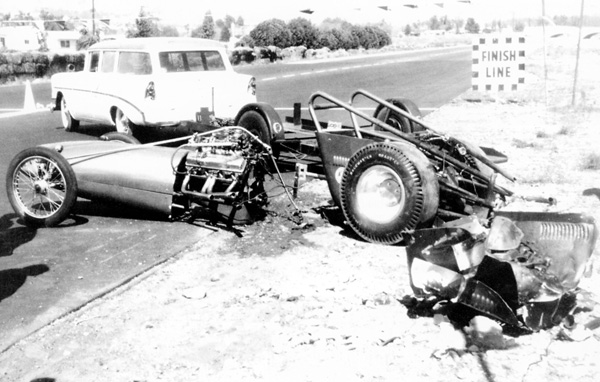 |
|
#1917 - In the early 1960s, when
Harry Hibler was track manager of “the Pond”
(The San Fernando Drag Strip), one of the more
unpleasant things he had to deal with was clutch
explosions – and they occurred frequently. In
this case the flywheel of the Valley Home
Service Special (a top-shelf dragster with a Max
Belchowski chassis) cut the car in half, before
taking flight, and trying to saw the roof of a
nearby church. The minister returned the
flywheel, and Hibler offered the entire
congregation track passes, but his courtesy was
declined. Photo from
LOST DRAG STRIPS II – More Ghosts of Quarter
Miles Past, by Scotty Gosson. (Courtesy
Dave Wallace Jr.)
|
|
a |
|
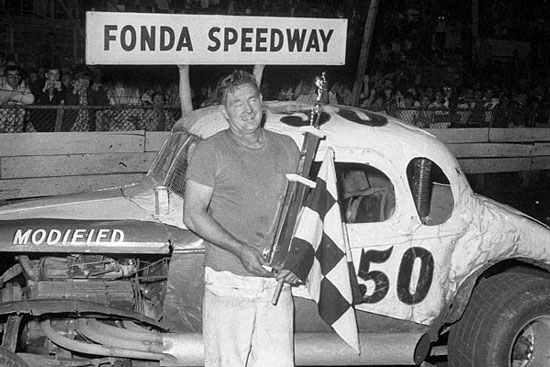 |
|
#1916 - New Hampshire’s
Ernie Gahan towed a million miles hither and
yon, often alone, with his stark,
industrial-looking #50, on a budget of less than
nothing, and somehow beat out Ray Hendrick for
the 1966 NASCAR Modified crown. When he fell
terminally ill in 2009, a group of admirers
sought to recover his championship trophy. Years
before, he had donated it to a museum that was
never built. Finally, it was found and brought
to the nursing station at Ernie’s hospital, and
the nurses were told that they had a NASCAR
champion in house. They got together as a group,
went into his room, and presented it. One of
them asked, “Mr. Gahan, are you as good as Kyle
Busch?” (Photo by Our Main Man with the Hat,
Frank Simek) |
|
A |
|
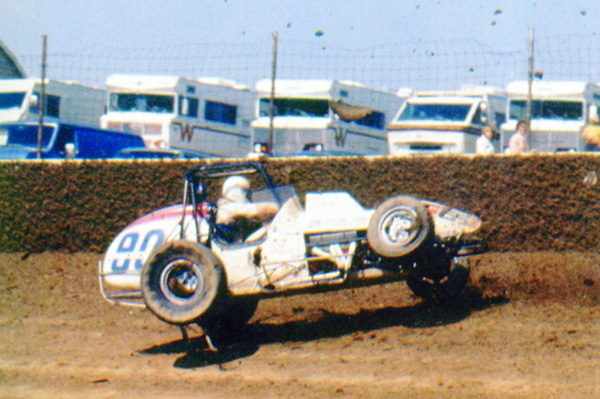 |
|
#1915 - We have just
received our shipment of the new and expanded
version of
HEWITT’S LAW by Jack Hewitt and Dave
Argabright. It is really cool, but how could it
not be with ‘Do-it’? Here he was in 1975, taking
quite an unusual line at Eldora. His comment:
“Part of the learning process. Sometimes you
gotta find that wall so you’ll know where it is
next time….” (John Mahoney Photo) |
|
a |
|
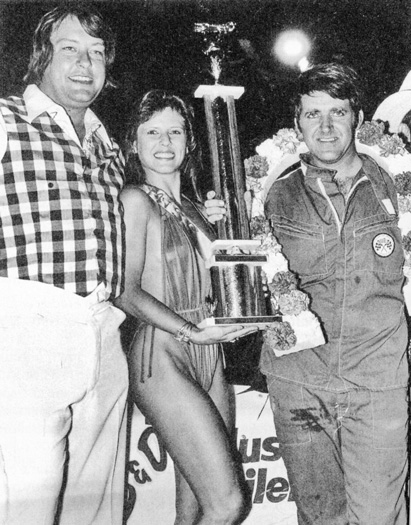 |
|
#1914 - Freddy Smith, the “Southern
Gentleman,” was clearly pleased with his first
NDRA win – at Wythe Raceway on May 31, 1980 –
and celebrated with series honcho Robert Smawley
and the comely Eva Taylor. Smith raced until
2012, reportedly collected 784 wins, and was
inducted into the National Dirt Late Model Hall
of Fame in its inaugural class. From
THE ROCK-EM, SOCK-EM TRAVELIN’ SIDEWAYS DIRT
SHOW – A History of Robert Smawley’s NDRA,
by Gary L. Parker. (Robert Smawley Collection) |
|
A |
|
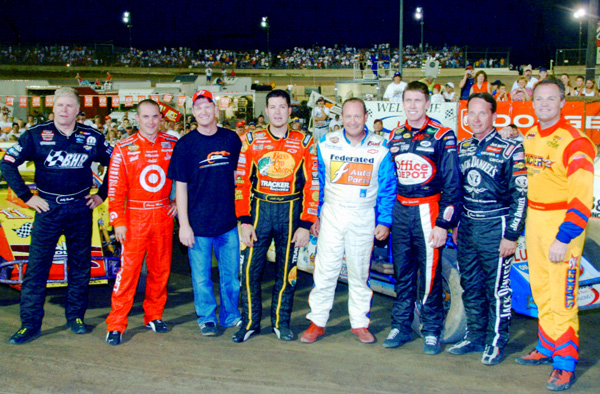 |
|
#1913 - It was not that long ago
that NASCAR’s elite drivers were a bit more
engaged in things grassroots. Quite the cadre of
them showed up at Ken Schrader’s (he’s in white
between Truex and Edwards) I-55 Speedway in
Pevely, MO. It sure looked like they were having
a good time. (Coastal 181 Collection) |
|
a |
|
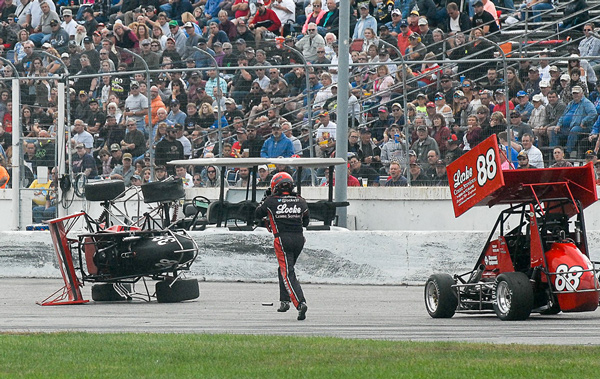 |
|
#1913 - All in the family.
Probably 10,000 viewers tuned in at this moment
last Sunday at the World Series at Thompson (CT)
Speedway. An up-and-coming open cockpit driver,
14-year-old Ryan Locke, drilled the wall coming
off turn four and flipped. Close behind was his
dad, Jeff, who was out of his car in an instant,
sprinting over to his boy. Mercifully, all was
well. (Good Guy John DaDalt Photo) |
|
A |
|
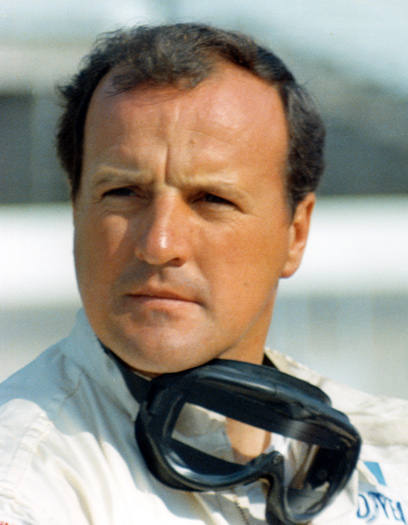 |
|
#1912 - A.J. Foyt: “I had a Midget
race car and they used to always have a race the
night before the 500. I knew many of the drivers
in the 500 because they’d come to my Daddy’s
shop when they raced in Houston. I used to
change tires and wash the cars of Johnny
Parsons, Jimmy Reece and Bill Vukovich, and all
of them when they came to town. So I knew them
all. The night before the Indy Midget race, I’m
working on my car and Jimmy Reece and a bunch of
other drivers walked up. Jimmy asked me what I
was doing and I told him I was jacking a little
weight. He said, ‘The only place you need to
jack some weight is on the right side of the
car, up in front of the steering gear.’ I asked
him what the heck he was talking about. ‘The
throttle foot,’ he said, ‘Put a little more
weight there.’ I never forgot that.” Quote from
INDY 500 MEMORIES: An Oral History of “The
Greatest Spectacle in Racing,” by Art
Garner and Marc B. Spiegel, Photo from
FOYT, ANDRETTI, PETTY, by Bones
Bourcier (John Mahoney Photo) |
|
a |
|
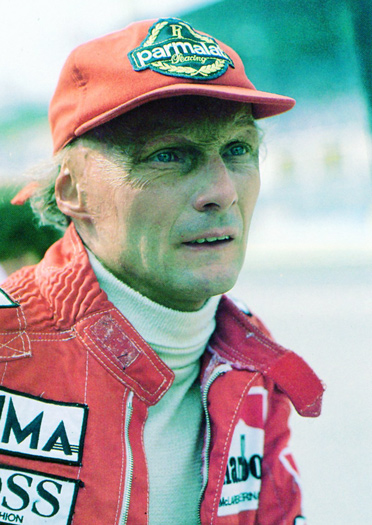 |
|
#1911 - Niki Lauda: “When I
first saw the film (of his fiery crash at
Nürburgring in 1976), I obviously knew that was
me, that something was happening to me. But,
somehow, I felt completely detached from it – it
was a horrendous shunt that somebody was
involved in, but I couldn’t relate what I was
seeing to myself. I didn’t remember. There was
no correlation between the film and my present
state; the driver on the screen was a total
stranger. There it all was: jack-knife, impact,
slide, flamers. ‘Look at that. God Almighty,
look at that.’” Quote and photo from NIKI
LAUDA: Meine Story, by Niki Lauda with
Herbert Volker. |
|
A |
|
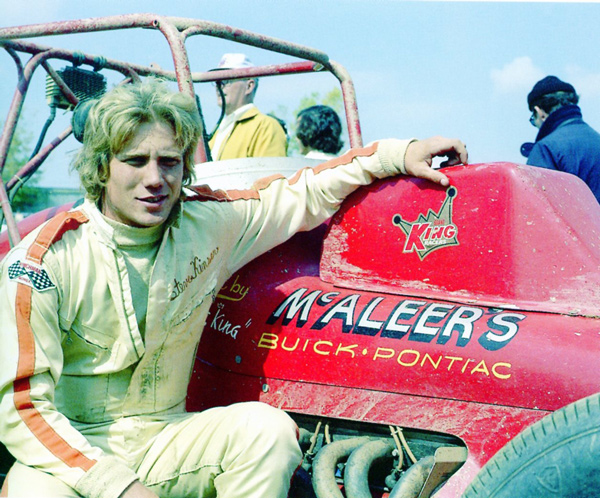 |
|
#1910 - A fresh-faced,
22-year-old Steve Kinser was 63rd in 1976 USAC
Sprint points. He had 577 World of Outlaws
A-feature victories to go. From
SEVENTIES CHAMPIONSHIP REVOLUTION: American
Racing Championships, by Dick Wallen.
(Dennis Torres Photo) |
|
A |
|
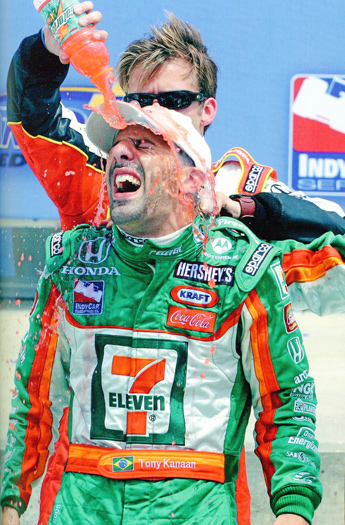 |
#1909 - That’s Dan Wheldon making sure
Tony Kanaan was properly hydrated. They had
quite the relationship.
At Indy in 2011,
says Tony, “He passed me with about 15 laps left
in the race. I didn’t know it at the time, but
he thought I chopped him a couple of times
during the race. I hadn’t, but he perceived it
that way. While he passed me, I saw what
appeared to be a wave. I thought ‘What the hell?
Why is he waving?’ He ended up winning and I
finished fourth, so I walked over the Victory
Lane to congratulate him. I went to hug him, but
he swore at me. He started yelling at me that I
had cut him off. I said, ‘Dan, you just won the
Indy 500. Let it go.’ He wouldn’t, so I had to
apologize. ‘I wouldn’t do that to you,’ I said.
‘You know me.’ Then I said ‘Didn’t you wave when
you passed me? I thought you were happy.’ He
said ‘No, I was flipping you off.’
“At
the awards banquet the next night, I
congratulated him on the win and had some fun
with our little moment. I said, ‘I did notice
you waving when you passed me. Sometimes when
you stick your hand up at 220mph, you can’t
control all your fingers. It looked like you
lost a few of them.’” Quote and Photo from
LIONHEART: Remembering Dan Wheldon, by
Andy Hallbery and Jeff Olson. |
|
a |
|
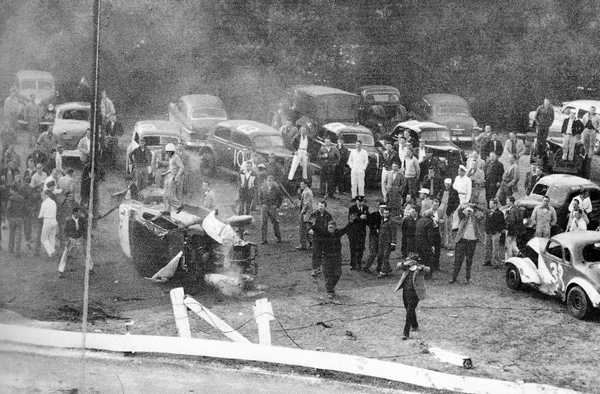 |
|
#1908 - What Clint Bodford did in the
1950s when he flipped his coupe over the fence
and into the pits at Bowman Gray was curious,
but not that unusual. It seems that at the time,
after a noteworthy crash, drivers sometimes
climbed atop their cars to wave. Were they
celebrating survival? One thing for sure –
repair of damages was not as expensive back
then. From
BOWMAN GRAY STADIUM, by Richard Miller.
(Forsyth County Public Library Collection) |
|
a |
|
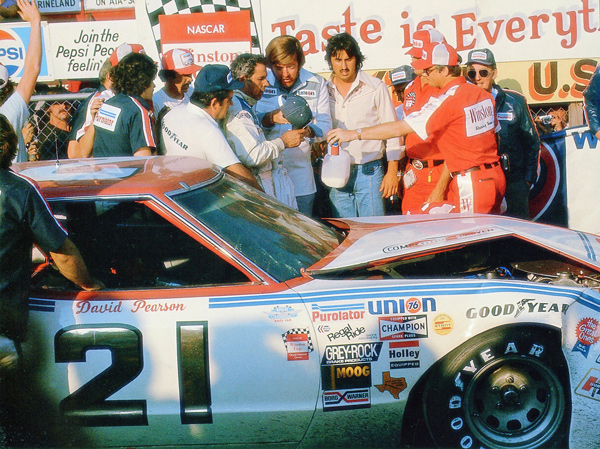 |
|
#1907 - It has often been
referred to as one of the most intense finishes
in NASCAR history. On the last lap of the 1976
Daytona 500, the Fox, David Pearson, stormed by
the King, Richard Petty, on the backstretch for
the lead. The King dipped low in 3 and 4, and
there was contact – and pandemonium. Lots of
infield grass was aerated as they spun, but the
Fox was able to limp across the line for a win
in his abbreviated Wood Brothers machine. From
STOCK CAR RACING: The High-Speed History of
America’s Premier Motorsport, by Don Hunter
and Al Pearce. |
|
a |
|
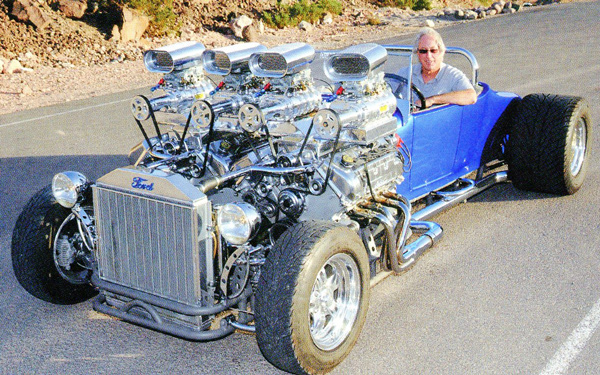 |
|
#1906 - New Zealander Gordon
Tronson apparently has little problems dreaming
up and crafting rather remarkable vehicles. This
time he started out with two wide-bodied,
all-aluminum 4.6 DOHC engines and a fiberglass
1927 T body. A million hours later, some
1.5-inch tubing for the chassis, and several
Weiand Roots superchargers later, he rolled out
“Double Trouble.” From How To Swap Ford
Modular Engines Into Mustangs, Torinos, and More,
by Dave Stribling. (Gordon Tronson Collection) |
|
a |
|
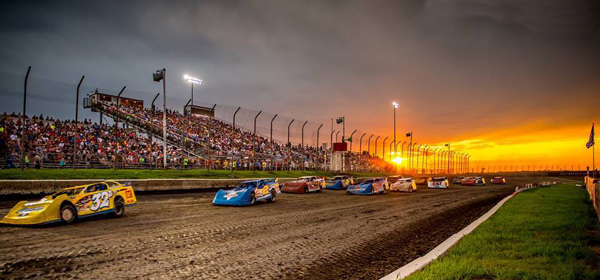 |
|
#1905 - It was a beautiful
thing, as if the sun blessed the field, on the
evening of July 22, the seventh annual Imperial
Tile Silver Dollar Nationals at I-80 Speedway in
Nebraska. It was especially beautiful for T-Mac,
Timmy McCreadie, who took off and hid after lap
22 and won himself $53,000. (Buck Monson Photo) |
|
A |
|
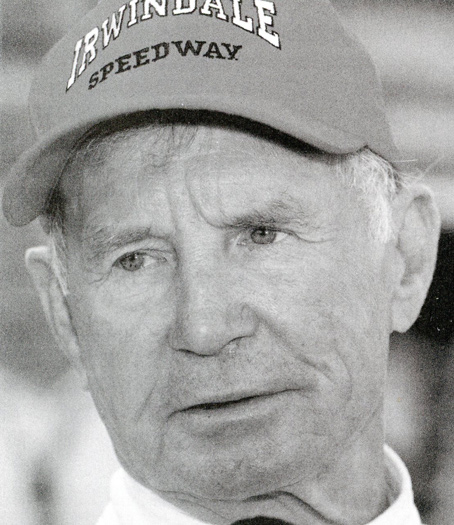 |
|
#1904 - Sam Posey’s conclusion on
Rufus was: “Rufus Parnelli Jones could look
mean, scary mean, but the facts show he never
pushed people off the road, never did any things
mean people do. He just beat you and beat you
again, and he did it so often, you had to
conclude he was mean.” Quote and Photo from
WHERE THE WRITER MEETS THE ROAD, by Sam
Posey. |
|
A |
|
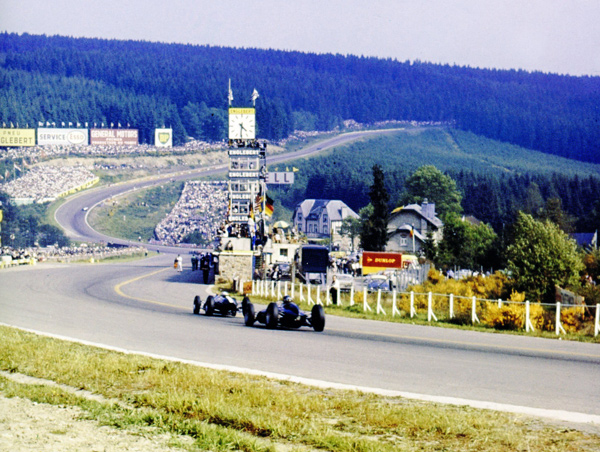 |
|
#1903 - A slightly misty shot from the
Spa (Circuit de Spa-Francorchamps in Belgium) in
its original form in the early 1960s. Formula 1
cars must have been really honking on that
downhill S-turn. From 1960s IN FOCUS - Rare
and Unseen Photographs From a Golden Decade of
Motor Racing, Damien Smith, Editor. |
|
a |
|
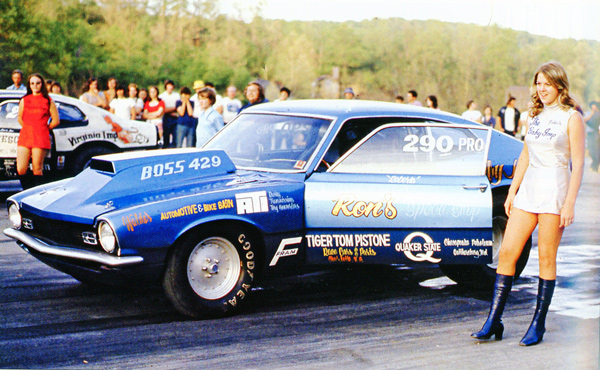 |
|
#1902 - "Now that’s one way
to get them out to the track. Roberta “Baby Imp”
Schultz and her sister Linda in the far lane
were part of the Miss Universe Drag Team that
was dreamed up by promoter Tom "Smoker" Smith.
It was a popular circuit that ran only a few
years in the early 1970s. To the cringe of
feminists everywhere, the hot pants and boots
were mandatory gear." Quote and photo from
MATCH RACE MAYHEM: Drag Racing’s Grudges,
Rivalries, and Big-Money Showdowns, by Doug
Boyce. (Photo courtesy Bill Truby) |
|
A |
|
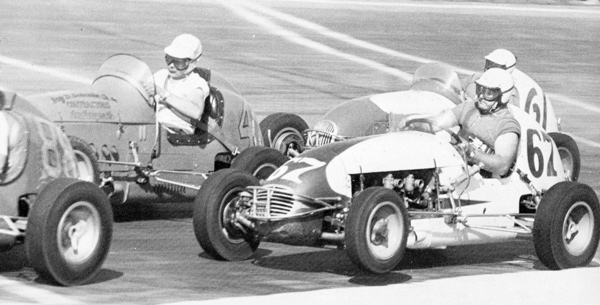 |
|
#1901 - Feel the momentum.
It was the Night before the 500 at the 16th
Street Speedway in Indianapolis on May 29, 1958.
Running hard were Lloyd Ruby #4, big-armed Buzz
Barton in the #67, and Mauri Wilson in the #61.
From The Kurtis-Kraft Story, by Ed
Hiltze. (Dave Knox Photo) |
|
A |
|
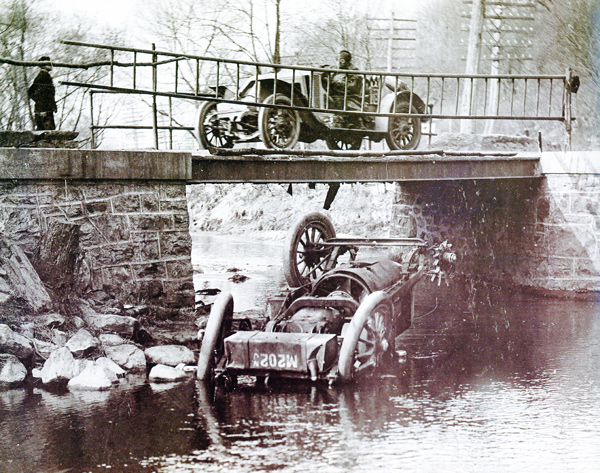 |
|
#1900 - The 30-mile track on
the streets of Briarcliff Manor, NY, back on
April 24, 1908, had few of the safety
considerations so much a part of road-racing
facilities today. Future star Ralph De Palma was
riding mechanic for Albert Campbell in an AAA
event when they hit a log and flipped into a
creek. Both survived – and Julian Block flew by
on the bridge in a Renault roadster likely not
even knowing they were there. From
THE 1912 MILWAUKWEE RACES: Vanderbilt Cup and
Grand Prize, by Joel E. Finn. |
|
A |
|
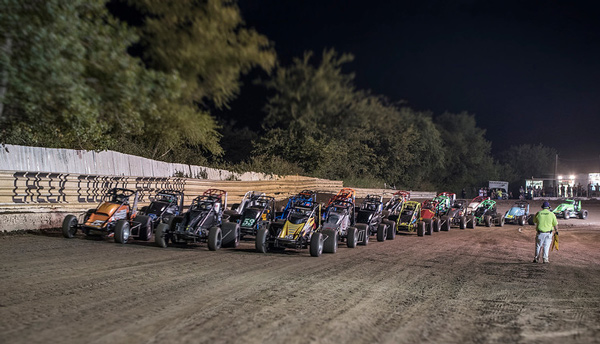 |
|
#1899 - This neat photo from
Kyle James out in Tulsa shows him keeping the
field in order on the pace lap. He writes, “It
was a 55-lap non-wing Sprint Car race called the
Ironman 55, run the second weekend of September
at Oklahoma’s Creek County Speedway. Put on by
local racers Danny Smith and David Stephenson
plus Steve Gran with the track, it featured
2-barrel 360 sprints that run locally normally
with wings. It benefited a triple amputee
veteran who received a $20,000 mobility chair.
The green #13 car trailing the field is
71-year-old Len Larkin in his 51st year of
racing. He ran an 8-lap heat, a 12-lap B and a
55-lap A, and finished 17th of 25 cars.” (John
Parham Photo) |
|
a |
|
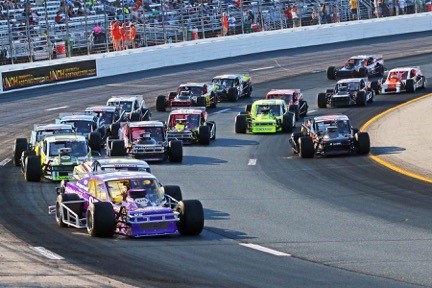 |
|
#1898 - To paraphrase the old racing
expression, “he ran where they weren’t.” The
incomparable Bobby Santos III put on a real show
in the Modified race at New Hampshire Motor
Speedway last Saturday. After saving everything
by cruising around in starvation mode for some
90% of the 100-miler, he decided it was time to
go. But he snookered everyone. As shown above,
he went downstairs, two feet right on the
infield line. He was so strong that he lost no
noticeable momentum to the cars on the outside,
even coming off turns two and four. He waltzed
easily and uncontested under everyone for the
win. (Dick Ayers Photo) |
|
a |
|
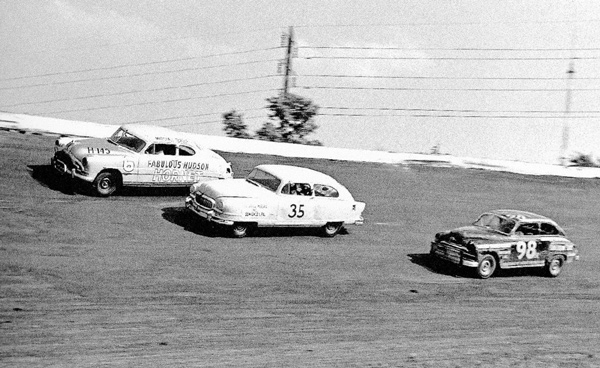 |
|
#1897 - Three decidedly
un-racy-looking cars at a 1951 NASCAR “Grand
National” event. Upstairs was Al Teague in a
Hornet, in the middle a streamline NASH, and
downstairs a 1950 Plymouth fastback. It’s hard
to believe, but Johnny Mantz drove that Plymouth
to the first-ever 500-mile stock car race, the
Southern 500. From DODGE DYNAMITE! – 50
Years of Dodge Muscle Cars, by Peter Grist. |
|
A |
|
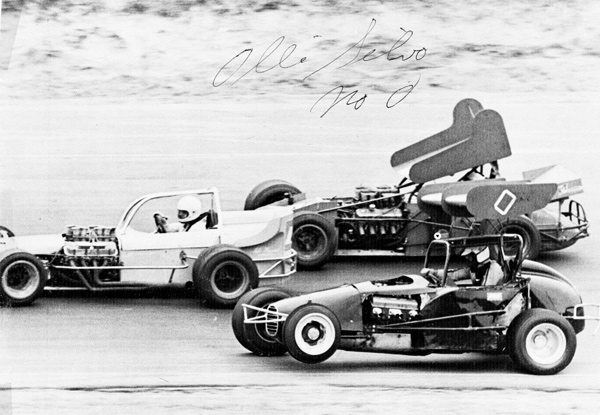 |
|
#1896 - The late Ollie Silva
really was incredible. That’s Ollie in his
old-time, industrial-looking, small-block #0
Super at the NESMRA Challenge Cup at Thompson,
CT, in 1972. Here he blasted under the big
blocks of Brian Herb (high) and Ken Andrews
(middle groove). Wrestling with his bow-spring
front end all the way, Ollie sealed the deal and
won the show. (NESMRA Collection) |
|
a |
|
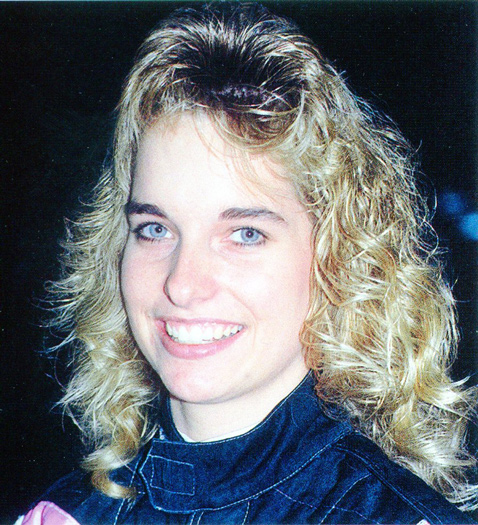 |
|
#1895 - On October 5, 1991,
Kara Hendrick, a beloved, up-and-coming driver
the country was watching, died in a USAC Midget
race at El Cajon (CA) Speedway. Her father,
Arthur, mourning, said, “People came up to me
all time and asked how I could let my daughter
race. I would tell them I’m doing everything I
can to discourage her. I would go up to her and
say, ‘Kara, I’m not going to put any more money
into your car,’ but she would go out and get it
from sponsors. She’s up there right now, looking
down and saying, “Dad, you were right. It is
dangerous, but I still want to drive.” From
UNITED STATED AUTO CLUB: Fifty Years of Speed
and Glory, by Dick Wallen (John Mahoney
Photo) |
|
A |
|
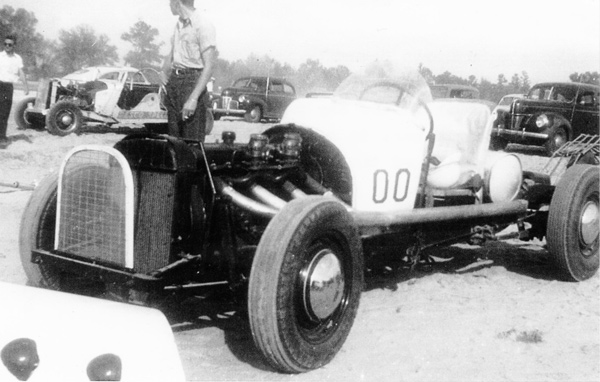 |
|
#1894 - This mighty six-banger was
fielded by Emil Reutimann, Buzzie and Wayne’s
dad in the 1947-48 era. Usually the
Reutimanns concentrated on tracks in the
Tampa-St. Petersburg area, but on this occasion,
Emil ventured east to the imposing 1.25-mile
Pompano Beach Speedway. The track, built
for horse racing, only lasted a season or two
with race cars because of its poor surface.
(Brian Sharp Collection)
|
|
a |
|
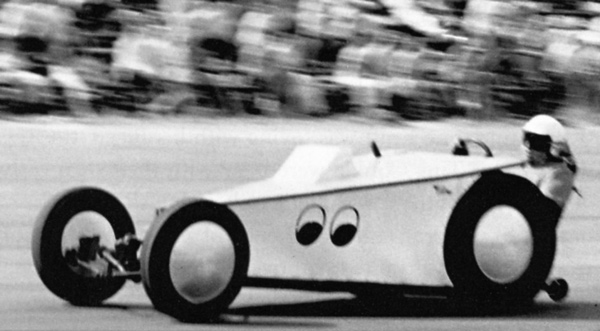 |
|
#1893 - “A very unique early
dragster was Slice of Pie, campaigned by
Creighton Hunter around 1955. Creighton’s
crude-looking dragster featured a full,
owner-fabricated body covering a front-mounted
tri-carb flathead, positioned sideways in the
chassis and running direct drive via chain to
the rear axle. Creighton relied upon a jacking
system to raise the rear of the car once he was
at the starting line. Bringing up the RPM, he
dropped the car when the flag dropped. Creighton
topped 150 mph with the car in 1956 before
crashing it at Santa Ana.” From
1001 DRAG-RACING FACTS, by Doug Boyce.
(Bob McClurg Photo) |
|
a |
|
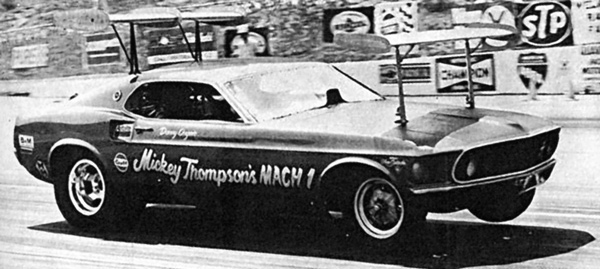 |
|
#1892 - In 1969, Mickey
Thompson towed his SOHC Ford-powered Funny Car
to Detroit Dragway to test. Here the front wing
appears to be set for downforce, while the rear
seems to be neutral. Sometime shortly after the
car’s debut, the sanctioning body outlawed the
wings. There was a lot to learn about mounting
them. Speed and downforce could fold the wing
struts back or collapse the entire assembly.
Several road race cars experimented with the
strut mounting system. A series of accidents,
attributed to wing failure, led to rules that
prohibited them or required upgrades to the
mounting. From
KAR-KRAFT: Race Cars, Prototypes, and Muscle
Cars of Ford’s Specialty Vehicle Program,
by Charlie Henry. |
|
a |
|
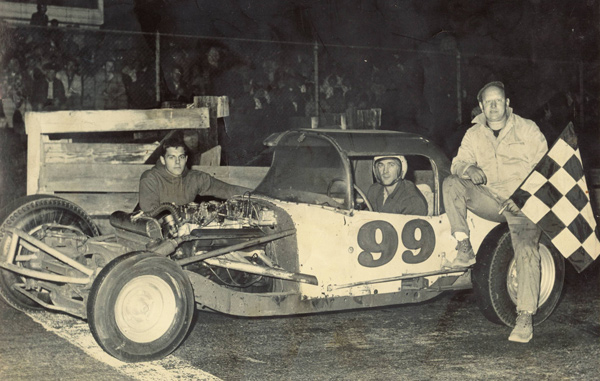 |
|
#1891 - Soft-spoken New England Hall
of Famer Fred Borden passed away last weekend,
having just reached his 90th birthday. Freddie
was a starring chauffeur starting back in the
jalopy days in Massachusetts and New Hampshire,
at venues such as Dracut, Hudson, the Medford
Bowl, and West Peabody. By the mid-’50s he had
advanced to the cutdowns and is seen in this
photo in Andy Smith’s remarkable A-Framed #99
when overhead engines came on the scene. In the
1960s he was The Man at Westboro, MA, and
Brookline, NH, Speedways, driving the Falconi
Bros. #10 Modifieds. He is likely the biggest
winner in Westboro’s 38-year history. (Coastal
181 Collection) |
|
a |
|
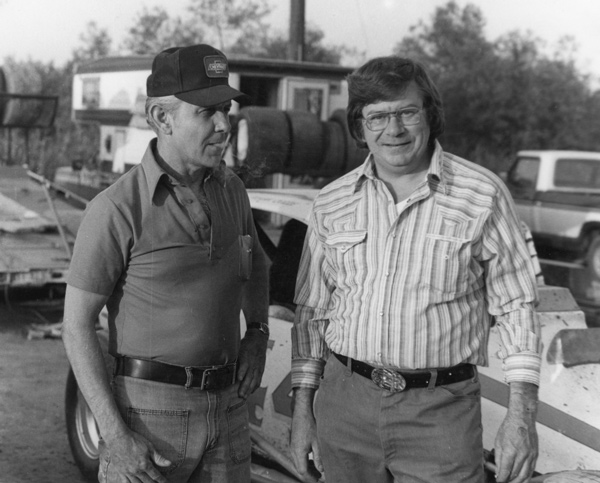 |
|
#1890 - Two true Eastern
legends, great friends, fast racers, and
talented car builders, the late Budd Olsen (L)
and Dick “Toby” Tobias. Olsen started racing far
and wide in 1948 and was 1951 National Auto
Racing Association Sprint Car champ in 1951.
Seven years later he romped to the NASCAR
National Modified Championship in Busty Luso’s
’37 Ford coupe. He took in $600 plus a shotgun
for the title. He subsequently raced locally
until 1973 when he retired and built BOSS
Modifieds with his son, Doug. Toby, on the other
hand, began with jalopies in 1950 on local
bullrings and over the next couple of decades
began to race nationally, entering national USAC
competition in open-wheelers. He died at
Flemington, NJ, in a Sprinter in 1978. His
company, Tobias Speed Equipment, is said to have
sold 1,000 kits and cars, including Modifieds
and Sprint Cars. (Bob Sweeten Photo, Rob Sweeten
Collection) |
|
A |
|
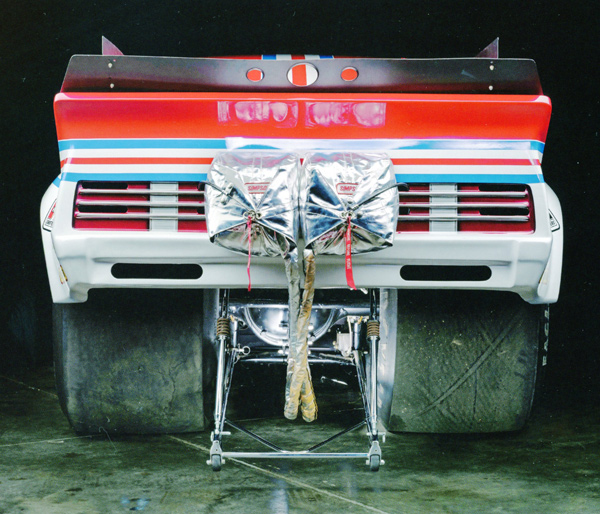 |
|
#1889 - “The sport of drag racing has
changed much since Kenny Bernstein built this
Funny Car in 1978. Today, the strip is one
thousand feet, and Funny Cars travel it in less
than 3.9 seconds, topping out at over 330 miles
an hour. But the heart of just about every Funny
Car and Top Fuel dragster since the
mid-seventies has been the 426 Hemi. Today these
500-cubic-inch engines generate 11,000
horsepower, with 90% nitromethane forced into
the engine at 110 gallons per minute. It’s
estimated it takes 950 horsepower just to turn
the supercharger at full throttle, and the twin
sparkplugs throw a spark equivalent to an arc
welder to ignite the dense explosive fuel
mixture. Still, open one of these $150,000
engines, and the block and cylinder head design
is clearly based on the legendary 426 Hemi –
huge valves, twin rocker shafts, and
hemispherical combustion chambers.” From THE
ART OF MOPAR – Chrysler, Dodge, and Plymouth
Muscle Cars, by Tom Glatch. (Tom Loeser
Photo) |
|
A |
|
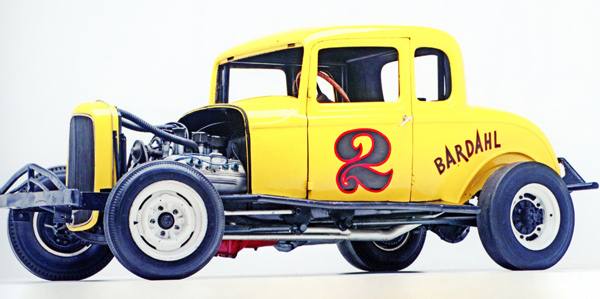 |
|
#1888 - It looks kinda
clunky, but it sure wasn’t. This was one of A.J.
Foyt’s “Supermodifieds” at Playland Park and
North Houston Speedways back in the 1950s. It
was Flathead powered with an Ardun OHV
conversion, a Hilborn injection on top, and a
Harmon-Collins magneto hanging off the front.
A.J. reportedly “tipped the can” with some
interesting chemistry in the gas tank. This
phase of Foyt’s career would come to an end
mid-summer in 1956 when he left for Midwest
Sprint Car wars. (Photo from
DEUCE – The Original Hot Rod; 32 x32,
by Mike Chase. ) |
|
a |
|
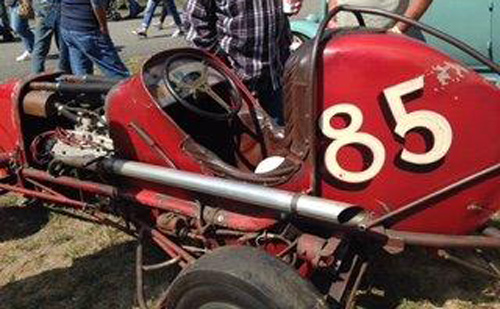 |
|
#1887 - The seemingly centuries-old
group of good guys, the Ty-Rods Club, held their
annual gathering in Lancaster, MA, this past
Sunday. The day was as awash in sunshine as
Florida was in Irma, and 100s of square tops and
early muscle cars rumbled in. One of the biggest
hits of the show, though, was an oval-track race
car – the original pre-war Midget in original
condition owned and operated by Ralph Moody of
Holman and Moody fame. Believed to be one of the
first tube-framed Midgets ever, the car
certainly showed Moody's creativity. He even
solved the overheating problem so generic to
Ford V-8/60s. Note the two radiator hoses coming
from the top of the radiator towards the
cockpit. They go to an auxiliary water tank
under the cowl. (Coastal 181 Photo) |
|
A |
|
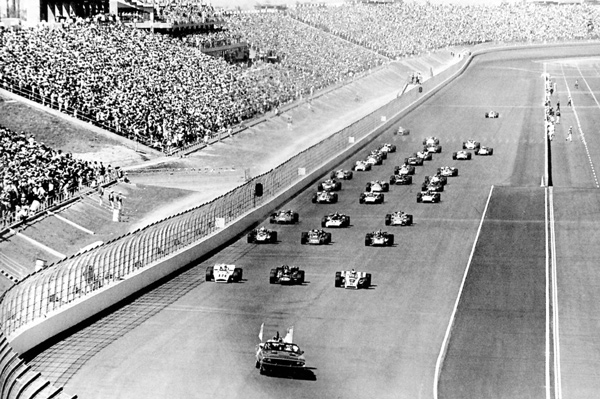 |
|
#1886 - It is the start of
the 1970 California 500, the opener of the
enormous and controversial Ontario Motor
Speedway before a crowd of 178,000. The
ambitious $145 million (today’s dollars) project
was successful at the outset and did attract
major attendance, but over time it was not the
massive audience necessary. All of the racing
legacy that’s left at the 800 acres across the
freeway from the Ontario International Airport
is an indoor go-kart track in the middle of a
business park. Photo from
LOST ROAD COURSES, by Martin Rudow.
(Riverside International Automotive Museum
Collection) |
|
A |
|
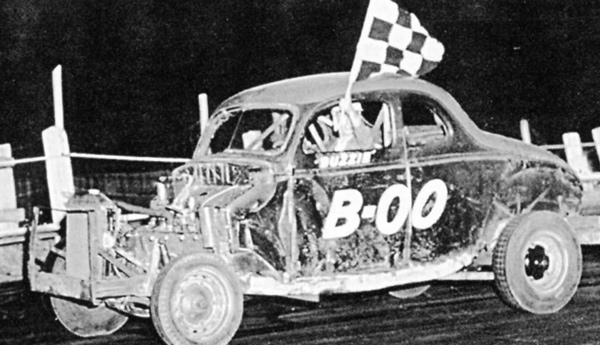 |
|
#1885 - Everybody move back! This
is Buzzie Reutimann’s first car, at Rocket
Speedway in Orlando in 1957. The track, notable
for its guardrail, ceased operations that year.
Buzzie most certainly did not. From
FLORIDA MOTORSPORTS RETROSPECTIVE PICTORIAL,
by Eddie Roche. (Charles Greco Photo) |
|
a |
|
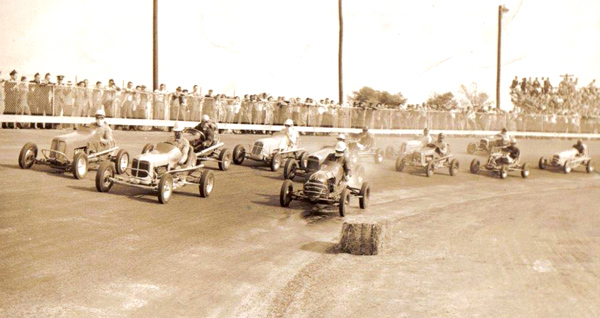 |
|
#1884 - Seventy-one years
ago last Memorial Day an energetic entrepreneur
named Anthony Venditti carved out the shape of a
track on Rt. 6 in Seekonk, MA, formed a
quarter-mile speedway largely out of cement, and
opened with a gala Bay State Midget Association
event. It was won by infamous East Coast open
wheeler Oscar "Cannonball" Ridlon. Fate would
not make life easy for Venditti, as there were
three separate fatalities that inaugural season.
He persevered, however, and the track became
successful and is operated still today by the
Venditti family. (Pete Zanardi Collection) |
|
A |
|
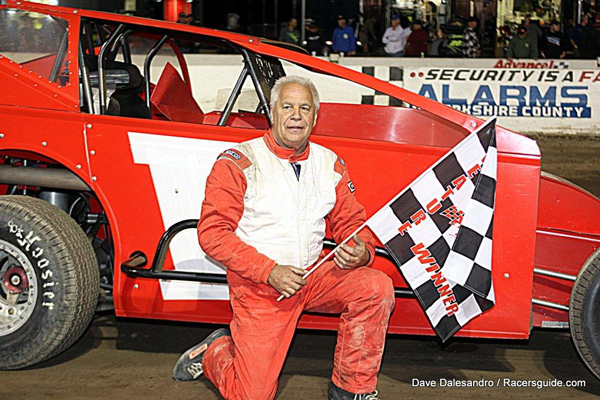 |
|
#1883 - In one of the coolest races ever,
74-year-old Denny Soltis of Torrington, CT,
romped home winner of this year's big block
Modified finale at Lebanon Valley (NY) Speedway.
It was an incredible performance – a remarkable
human feat. It certainly does NOT seem like
yesterday that rookies Denny Soltis, the late
Corky Cookman, and we - in our #181 - lined up
together at the Valley opening day in 1969.
(Photo by Our Man from Amsterdam, Dave
Dalesandro) |
|
a |
|
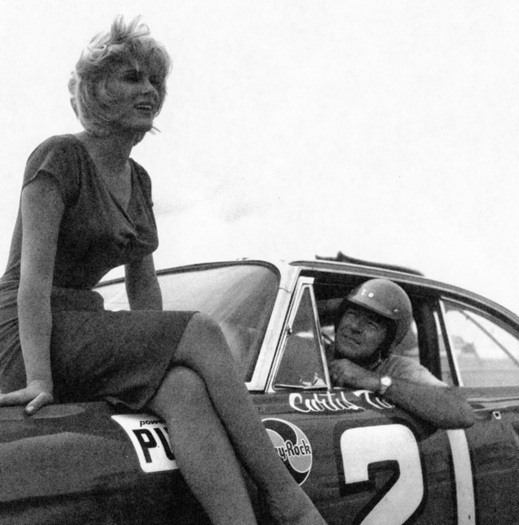 |
|
#1882 - Charlotte Motor
Speedway has long held the belief that inviting
dignitaries can really spice up the show – even
by year two in 1961. June Wilkinson, the English
model and actress, was in town for the World
600. Quite predictably, she caught the attention
of promoter/racer Curtis Turner. Photo from
CHARLOTTE MOTOR SPEEDWAY HISTORY: From Granite
to Gold, by Deb Williams. (CMS
Collection) |
|
a |
|
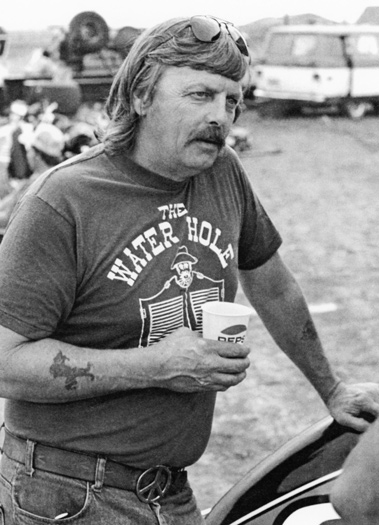 |
|
#1881 - They say that once
the great G.P. (Gary Patterson) went to
Australia and ran a Midget with his familiar
peace sign. A spectator asked him what kind of
number that was. G.P. replied it was a #1 with
crutches ’cause he was so damn fast that it
needed them to stay upright when he raced.
(Joyce Standridge Collection) |
|
A |
|
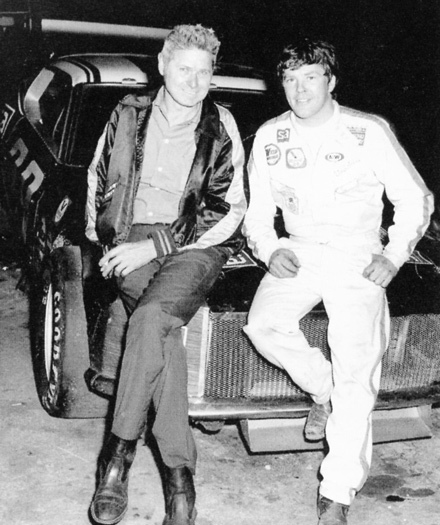 |
|
#1880 - Illinois’ Bud
Koehler (L) and Wisconsin’s Dick Trickle pose at
Blue Island’s Raceway Park on May 19, 1964. The
1/5-mile asphalt facility offered up nearly 3000
programs before being shuttered in 2001. Trickle
ran third in the main, while the respected
Koehler won it, as he did 489 other mains at
that track alone. When having his picture taken,
Koehler would typically hide his right hand
which had been injured and deformed in a
railroad incident when he was a kid. From
BLUE ISLAND’S RACEWAY PARK by Stan
Kalwasinski and Samuel Beck (Stan Kalwasinski
Collection) |
|
a |
|
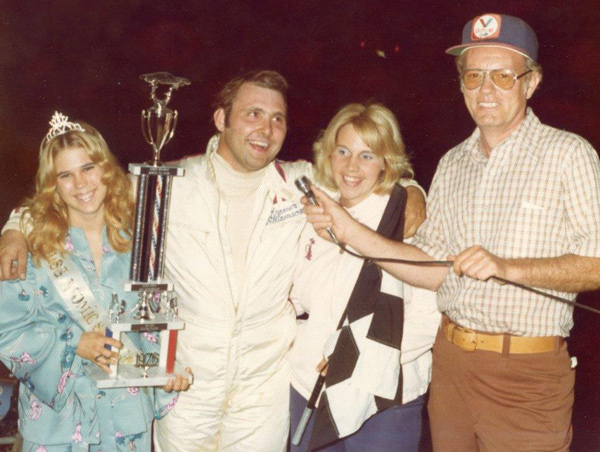 |
|
#1879 - Kramer's excellent June day. On
June 9, 1976, Kramer Williamson and crew made
the long trip out to Atomic Speedway in Ohio,
and he won the All Star Super Sprint race
handily. While in Victory Lane with Roy Salt
(R) and Miss Atomic Speedway Ronna McCloy (L),
Kramer announced his intention to marry Sharon
Beahm. (Photo from
KRAMER WILLIAMSON: Sprint Car Legend,
by Chad Wayne Culver.) |
|
a |
|
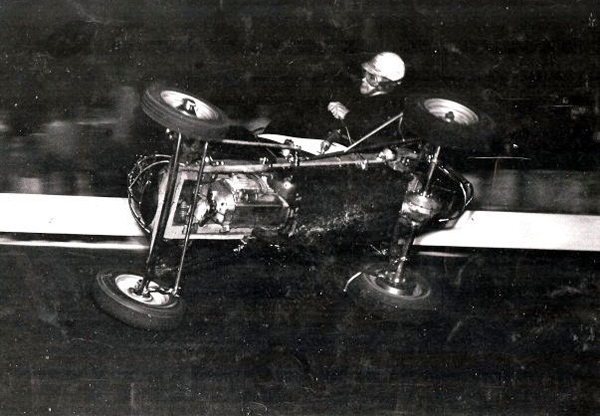 |
|
#1878 - Dick Shuebruk
appears to be following the old race-driving
adage, "Never give up trying to get out of a
crash." But that night in 1947 at the old Dracut
Speedway in Massachusetts, he flipped anyway.
(Pete Zanardi Collection) |
|
A |
|
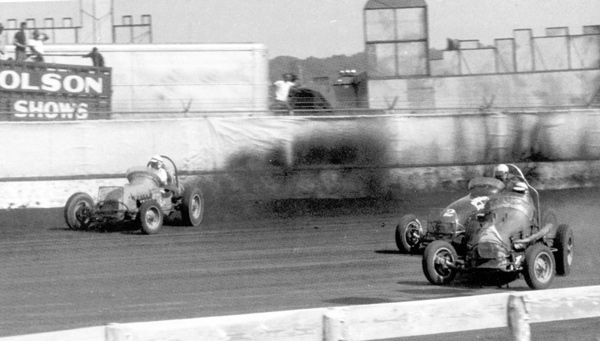 |
|
#1877 - Des Moines, 1969.
Pete Folse (Honore Offy #2) and the ill-fated Al
Chamberlain (his own Chevy #55) duel downstairs
while A.J. (D. Wilson Offy) hammers the outside.
From
BIG CAR THUNDER, Vol. 1, by Bob Mays.
(Leroy Byers Photo) |
|
A |
|
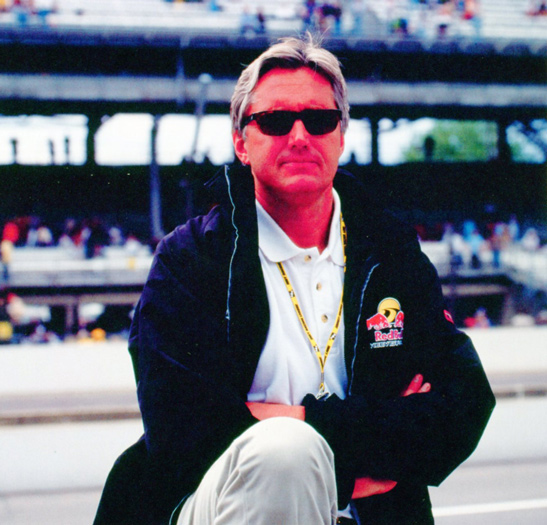 |
|
#1876 - “In my first year
at Indy, about halfway through the month of May,
I walked over to where A.J. Foyt was. I was
stuck. Turn 1 was really difficult because the
car I had – I didn’t know it at the time – was
very imbalanced aerodynamically and it was loose
– the back end kept coming out. That isn’t a
problem when you’re going 100mph on an open road
race, but if you’re going around Indy at 230mph,
it is an issue. So I went there and I said,
‘Hello, I’m Eddie Cheever,” and he looked at me
with great disdain. The disdain did not bother
me so I just sat there and said, ‘Look, could
you give me one good thought that I could use
around here because I’m really stuck – I can’t
seem to go any quicker.’ He paused and in that
southern drawl of his, he said, ‘Keep turning
left.” I thought, OK, where’s the punch line to
the joke. He smiled at me and walked over and
got into his car – and that was that.” Quote by
Eddie Cheever, Jr, from INDY 500 MEMORIES, by
Art Garner and Marc B. Spiegel. (Photo from
THE RACE: Inside the Indy 500, by James
McGuane) |
|
A |
|
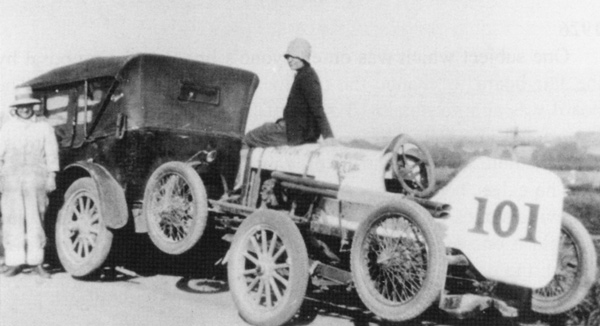 |
|
#1875 - Ready for DoT
inspection and ready to cruise down the highway
in style was Midwestern competitor Lawrence
Hughes. From
THE HIGH BANKS: Belleville’s Amazing Track and
the Men Who Tried to Tame Her, by Beryl
Ward, L.A. Ward, and Bob Mays (Lawrence Hughes
Collection) |
|
A |
|
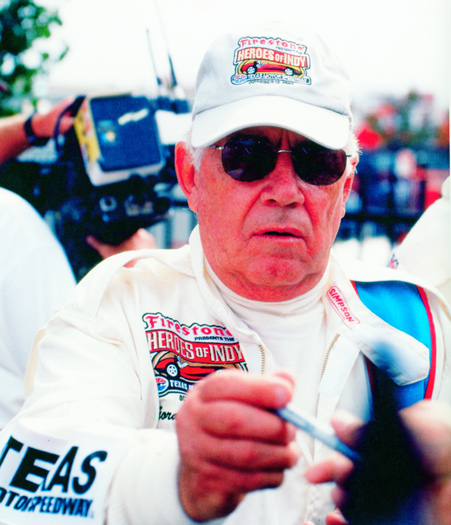 |
|
#1874 - Tom Sneva on the
Indy 500: “I remember in 1981, we were just a
little bit into the race, and I’m getting a lot
of cross-frequency chatter over the radio. It
took me a few laps to realized that it was one
of the observers. They had twelve observation
posts around the track. The guy at ‘post nine’
had spotted a good lookin’ gal in Section 23 –
Row WW, and he was trying to tell his buddy over
at observation post eight where she was. I was
in a pretty good battle with Foyt at the time,
and it took me about twelve laps to find her
myself. There are some of the stories that don’t
always get out. These are some of the problems
that drivers have to overcome, that fans don’t
realize, at times.” Quote and Photo from
THE RACE: Inside the Indy 500, by James
McGuane, |
|
A |
|
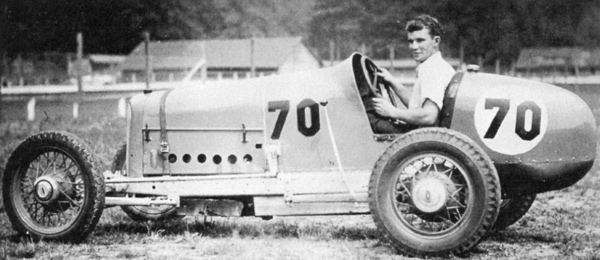 |
|
#1873 Guess who? Huge hint: He loved the
outside! Photo from STRAPPED IN
magazine, November 2013. Answer:
PDF HERE |
|
a |
|
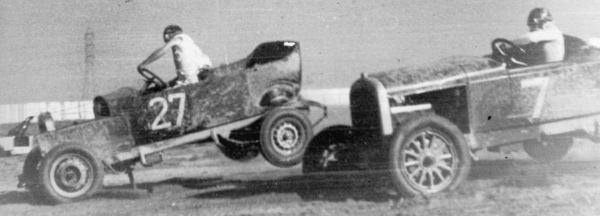 |
|
#1872 - It was August 21,
1938 in Southgate, CA. The 37 competitors,
including Bill Stroppe and Wally Parks, went to
battle in the first “jalopy derby” before 10,000
fans at Southern Ascot Speedway. Don Farmer in
the #27, being chased by Tall Valance, was the
class of the field. He sat on the pole and won
it, apparently paying little regard to either
helmet or seat belt. From MEMORIES OF THE
CALIFORNIA JALOPY ASSOCIATION, by Thomas D.
Luce. (Photo, Don Farmer Jr Collection) |
|
a |
|
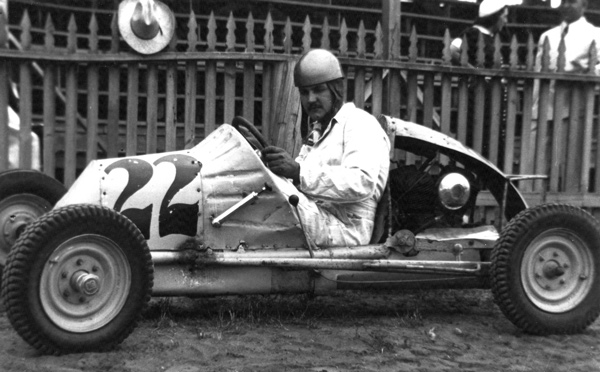 |
|
#1871 - By 1939 the mighty
Midgets had really mushroomed nationwide. In his
brand new book, Loren Olsen lists 13 venues in
Wisconsin alone that held races. Some tracks
such as Milwaukee State Fair Park and Racine
Horlick Field ran full schedules, while some
venues ran just one show. Tomah Fairground was
one of them, but it didn’t even get through its
solo event, which was cancelled because of a bad
accident and never restarted. One of the
competitors there was Joe Deswysen, who was
looking pretty fearsome in his rear-engine
machine. From
MIDGETS OF WISCONSIN: An Illustrated
Year-by-year History of Midget Racing in
American’s Dairyland, by Loren Olsen.
(Photo, Ramsby Racing Collection) |
|
a |
|
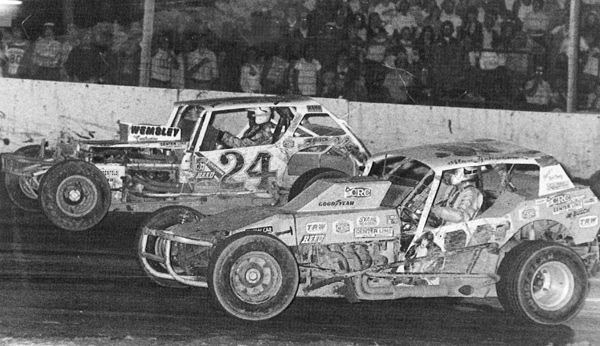 |
|
#1870 - Wily Will Cagle (#24) and Alan
Johnson (that would be #14j beneath the clay)
duel for the point in a DIRT feature at
Canandaigua, New York, back in 1980. That was
right at the juncture that the manufactured
chassis would become the rule of the day. The
era of a bunch of guys gluing something up in
their garage with a few boxes of 6011 welding
rod was gone in an instant. From STRAPPED IN
magazine, May 2009. (Lukowski Photo) |
|
A |
|
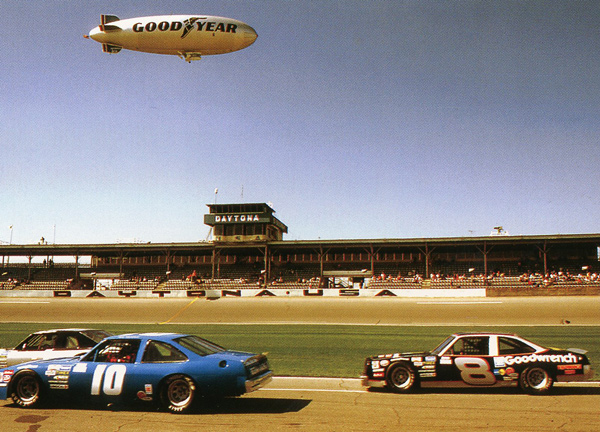 |
|
#1869 - “GM Goodwrench’s first
appearance as Earnhardt’s primary sponsor came
in the 1986 Busch Series season opener at
Daytona. Here, he waits on a postcard-perfect
Daytona day with Morgan Shepherd (7) and Ken
Bouchard (10) for practice to begin prior to the
race.” Quote and photo from
DALE vs DAYTONA: The Intimidator’s Quest to win
the Great American Race, by Rich
Houston (Photo Courtesy Dick Conway) |
|
A |
|
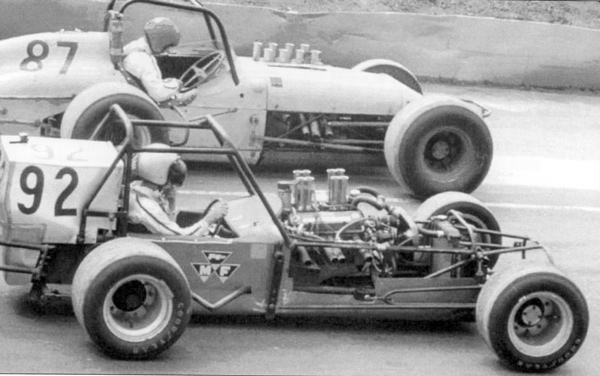 |
|
#1868 - Fueled up at Oswego, New York.
(Photo from STRAPPED IN magazine, Nov.
2013, WM Collection) |
|
a |
|
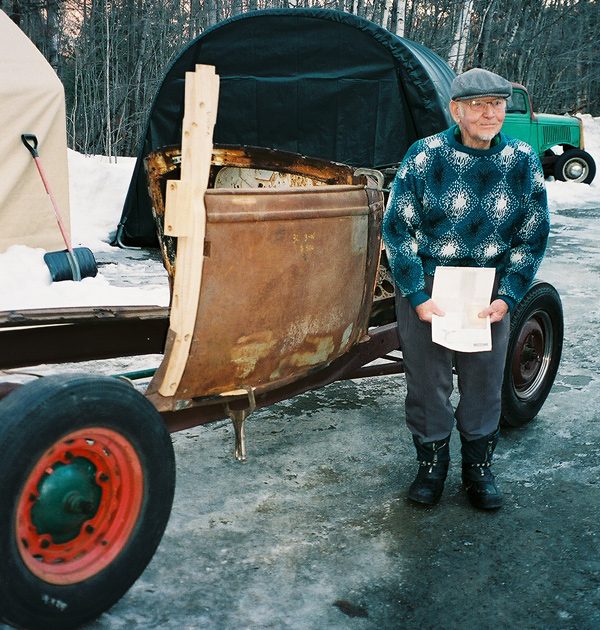 |
|
#1867 - Marty Harty, a 98-year-old New
England Auto Racing Hall of Famer, passed away
in Dover, New Hampshire, last Saturday. Marty
was a sweet-tempered man, a throwback to a
gentler time. For years and years an institution
around the Northeast, he made rounds to garages
with an over-stuffed Volkswagen bus, peddling
brooms, wrenches, and all manner of bric-a-brac.
He was also the brightest man I ever met. In
Europe, back in World War II, he taught himself
Italian, and in his nineties could still quote
chapters from Dante’s Inferno that he had read
back then. In the 1950s and ’60s he was a stock
car builder for hire, who would deliver his cars
and guarantee that they would win, provided his
driver and his setup were used for the test. His
finest work was likely the time he built the
Modified with Vic Kangas that carried Ernie
Gahan to the 1966 NASCAR national title. They
had literally one week to complete it, while
Ernie was banged up, recovering from a crash in
Middletown, NY. Marty also had quite the wit.
Several years ago, Parnelli Jones was at the
Vintage Celebration at New Hampshire Motor
Speedway. When introduced, Marty looked Parnelli
up and down and said, “Well, you don’t look all
that special to me...” (Photo, Howard Towns
Collection) |
|
a |
|
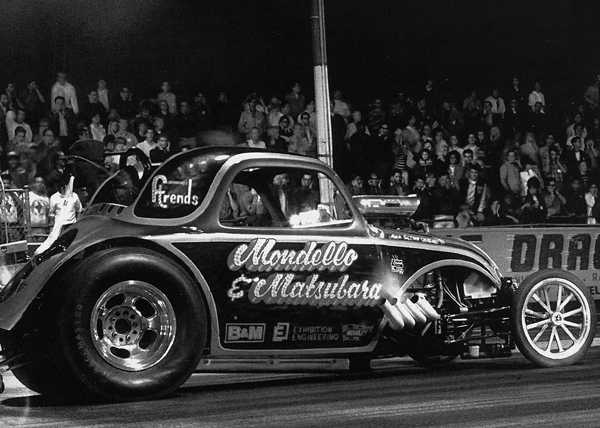 |
|
#1866 - Back in the 1960s,
folks out on the West Coast couldn’t seem to get
enough of those outrageous Fuel Altereds. The
epitome of the phenomenon was the Fuel Altered
National Tour, which lasted for four years after
its 1968 start. The cars were short and very,
very fast. Mondello and Matsubara’s blown 427
Chevy Fiat was the first Fuel Altered in the
7-second bracket at above 200mph.
“Out-of-control, guard-rail to guard-rail,
Christmas-tree-destroying runs, all four wheels
in the air, and trail-dragging wheelies weren’t
the exception to the rule, they were the rule.”
As expected, Wild Willie Borsch ran right up
front. Photo and Quote from
MATCH RACE MAYHEM, by Doug Boyce.
(Photo, Author’s Collection) |
|
A |
|
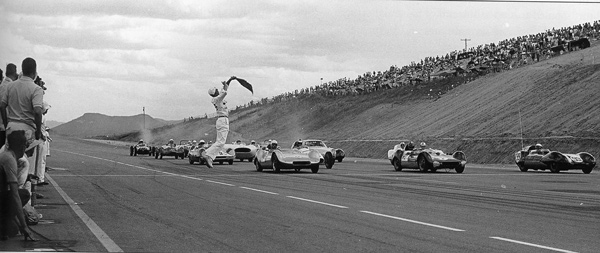 |
|
#1865 - Continental Divide
Raceway in Castle Rock, Colorado, operated its
10-turn, 2.7-mile road course from 1959 through
1983. There was an adjoining oval and a drag
strip. Here an enthusiastic starter (whatever
happened to them?!?) waves on an early 1960s
race with “a few Lotus cars, a couple of
specials, an Abarth, even a Formula Junior.”
From the height of the hill, spectators could
see the entire track. From a neat new book
LOST ROAD COURSES, by Martin Rudow,
(Photo, Castle Rock Museum) |
|
a |
|
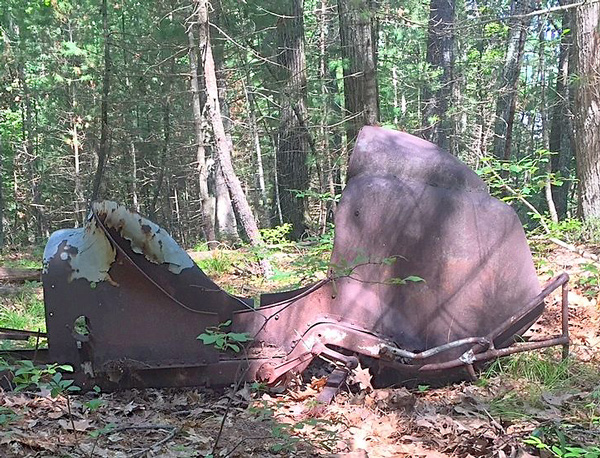 |
|
#1864 - This is the way many
beautifully restored race cars are initially
found. The car sits in the woods behind a house
in a small town north of Boston. Included in the
find are the Midget’s radiator, two V8-60
engines which have been garaged, the rear end
complete with wheels and slicks, and other
parts. Not found is the car’s history. We don’t
know who built or drove it or even if it was
ever finished and raced. One of the engines
comes with headers (that were once chromed but
the plating has largely fallen away) and an
aluminum Edmunds intake. That engine will be
restored and displayed at the North East Motor
Sports Museum. (Caption and Photo, North East
Motor Sports Museum) |
|
a |
|
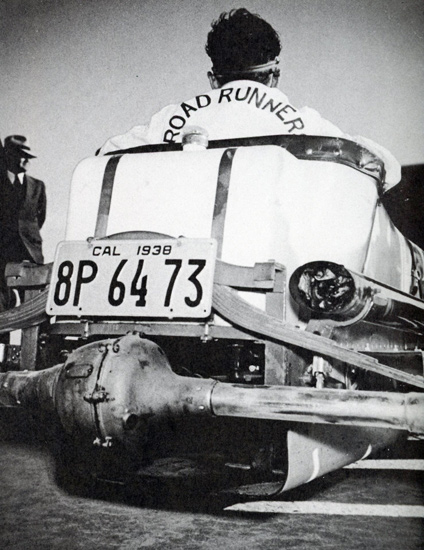 |
|
#1863 - They say that May 15, 1938,
nigh on 80 years ago, was the day that hot
rodding came of age. Most all of the Los Angeles
area car clubs had been merged into S.C.T.A.,
the Southern California Timing Association, and
this was the date of their first big meet. Three
hundred cars roared across the Muroc Dry Lake
that day. Apparently the oldest of the S.C.T.A.
competitors was a 40-year-old school teacher.
Describing the impact of that incredible day on
motorsports, William Carroll wrote, “It took
primitive Muroc Dry Lake, at every chill dawn a
barren, featureless slab, dusty at the course
and dirty wherever touched, to host the
beginning of what is remembered as one of the
truly great communal efforts of modern youth.”
From WHEN THE HOT RODS RAN – May 15, 1938,
by William Carroll |
|
a |
|
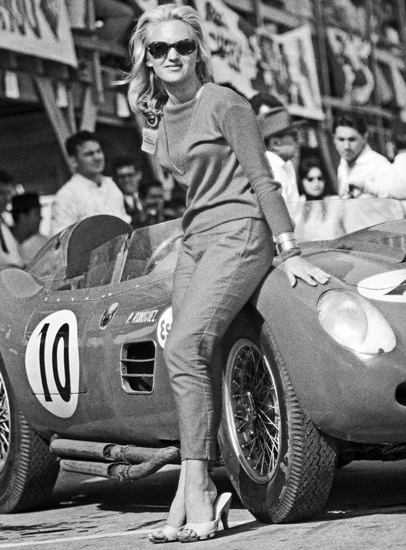 |
|
#1862 - She looks pretty cosmopolitan
– almost like Meryl Streep, but it wasn’t Meryl.
This was back in Havana, Cuba, at the start of
the 1958 Grand Prix. She was leaning on Wolfgang
von Tip’s Ferrari 315s. Lean on! He ran fourth.
Photo from
CUBA'S CAR CULTURE: Celebrating the Island’s
Automotive Love Affair, by Tom Cotter
and Bill Warner. (Photo Bill Warner Collection) |
|
a |
|
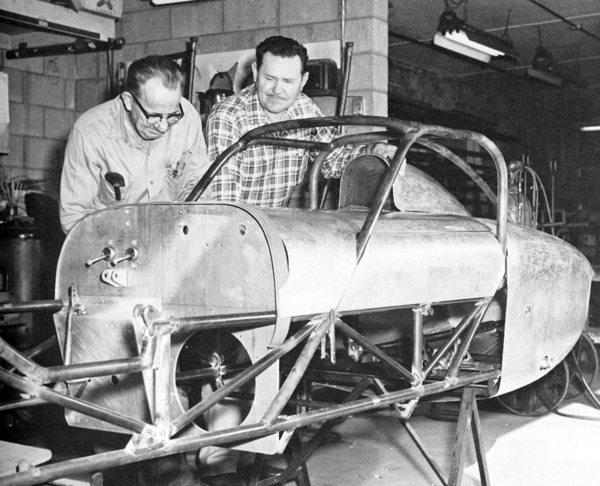 |
|
#1861 - "Left of Frank Kurtis is Harry
Pitford, a very close friend and chief welder.
This was, perhaps, the final race car to come
from the plant of Frank Kurtis. In 1962 he built
this modern type which may have been the only
Indy car ever constructed with a combination
roll bar and cage and thanks to the Kurtis
design this ‘cage’ was not ugly. Junior Johnson
of NASCAR fame was slated to drive. But after a
few laps on the Indy oval he found it wasn’t his
cup of tea. Colby Scroggins, a rookie, was then
picked to drive it. Colby was more than able to
keep up with the fast runners in the turns, but
had no power on the long straights. This was no
mystery as the stubborn owner insisted on using
a passenger car typed ignition with a wet
battery, rather than the tried and proven
magneto on the Offy engine. It didn’t work.
Disappointed and discouraged in having to deal
with such customers, Frank made his decision to
retire from his long and successful career of
race car building." Photo and caption from
THE KURTIS-KRAFT STORY by Ed Hitze. |
|
A |
|
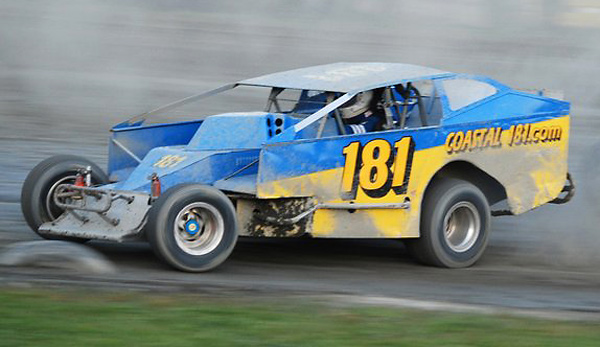 |
|
#1860 - He’s up before 5:00 each
morning to ensure that his commute from his home
in New Hampshire to the financial district in
Boston is under two hours. He often spends 80
hours a week at work at Fidelity Investments,
where he is a Vice President. But there’s a
screw loose somewhere. Every time he possibly
can – often just a couple times a year – he’s
slinging his Modified around dirt tracks in
Northern New England. They call him Blake
“Sideways” Shepard. We’re proud to have him
carry our colors. (Coastal 181 Collection) |
|
a |
|
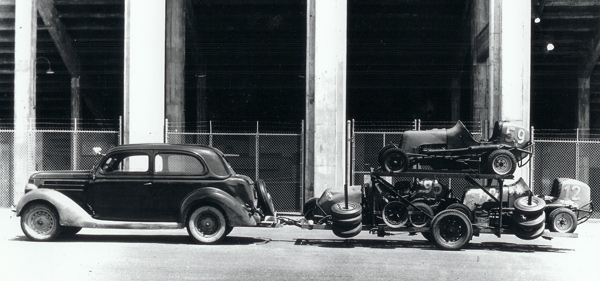 |
|
#1859 - Roscoe “Pappy”
Hough, a pioneering East Coast Midgeteer, sure
was of hearty stripe. Here is one of his
haulers, prepped for the 400-mile weekly trek
from Gasoline Alley in Patterson, New Jersey, to
the Buffalo Civic Stadium with a few of his
Midgets. One night he was pulled over by a
policeman who said the two-story trailer
couldn’t slow down in a country mile. He
demanded that Pappy take it back up to speed.
The policeman would follow and then flash his
lights telling Pappy when to try stopping. That
they did. The lights flashed, and Pappy jammed
on the brand new binders he had just installed,
plus he downshifted and yanked on the emergency
brake. The officer promptly piled into the back
of the trailer, smashing up his cruiser big
time. Ever the civic-minded citizen, Pappy towed
him back to town. Photo from
DAREDEVILS OF THE FRONTIER, by Keith
Herbst. (Photo, Bob Miour Collection) |
|
A |
|
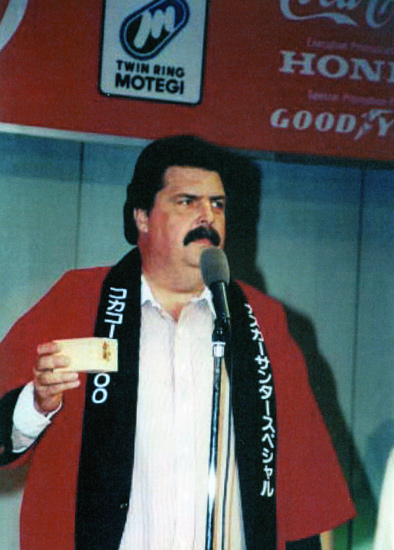 |
|
#1858 - "NASCAR president Mike Helton
prepares to offer a toast pf Japanese Sake
during a drivers party at Suzuka City, Japan in
1997." Quote and photo from
NASCAR’s Greatest Drivers & Personalities,
Volume 1, by Gerald Hodges. |
|
a |
|
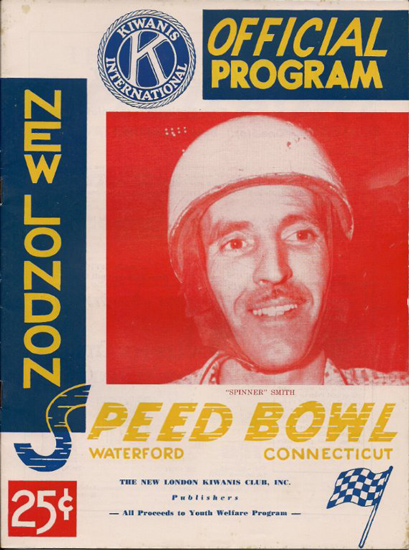 |
|
#1857 - Printed materials
played a much larger role in American racing
back in the 1950s than today. Colorful posters –
typically with large splashes of orange and red
– were commonly tacked onto telephone poles
pumping the local track. And, once folks got
there, the usual first step was to buy a
program. The graphics were rudimentary,
certainly carrying their period look. Check out
Spinner Smith. (Pete Zanardi Collection) |
|
a |
|
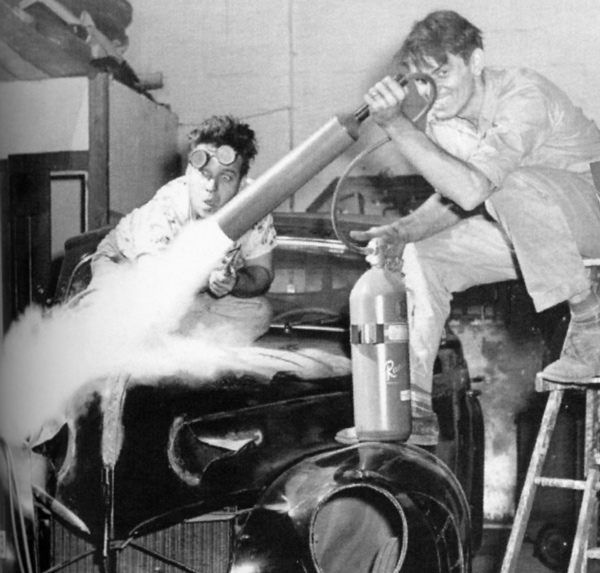 |
|
#1856 - The 1950s/’60s was a
wonderfully creative era in motorsports, but in
fairness, the enormous number of vintage coupes
and coaches cut up along the way is simply
immeasurable. One of the most notorious
characters in New England back then was Frank
Maratta, a great car builder and the promoter of
Connecticut Dragway. He had his humorously
dramatic side, as this publicity shot
demonstrates. Here "a blast of CO2 quenches his
torch before he can push back the borders of
automotive design any further." Photo and quote
from COOL CARS AND SQUARE ROLL BARS: Photos
and Recollections of Fifties Hot Rodding in New
England, edited by Bernie Shuman. (Ron San
Giovani Collection) |
|
A |
|
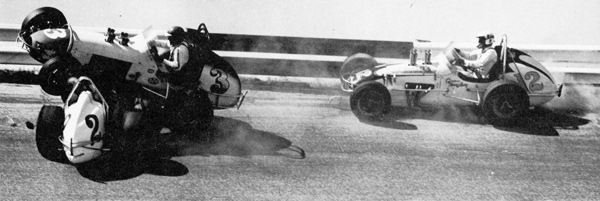 |
|
#1855 - My kingdom for a
cage! It was July 1968 on the high banks of
Salem Speedway. Bud Randall’s #12 spun, and Al
Smith threw his #2 Watson Ford sideways to miss
him, when along came Jerry Daniels #3. There was
little choice but to go through Smith’s cockpit.
“Smith suffered facial lacerations.” Photo and
quote from USAC SPRINT HISTORY 1956-1980,
Carl Hungness publisher (Armin Krueger Photo) |
|
A |
|
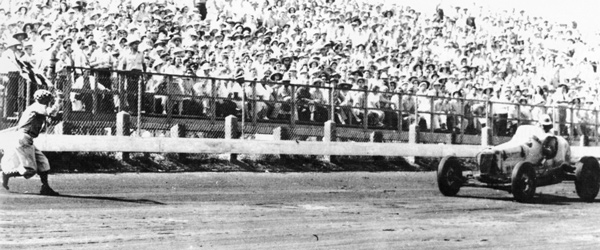 |
|
#1854 - It was a grand moment
on June 22, 1941. Duke Nolan motors the infamous
Poison Lil across the line for his second
consecutive 100-miler at Langhorne. His time was
a world record 1:04:39.88 lasting for 13 years.
Spencer Riggs figures that Nolan was looking
over to the infield at car owner Paul Weirick.
Maybe, but for sure he wasn’t looking at the
nattily attired starter, Doc Gerner. It’s hard
to imagine flagging a race from the outside of
the track, on the track. From
LANGHORNE: No Man’s Land, by L. Spencer
Riggs. (Walter Chernokal Photo, Courtesy
Racemaker Archives) |
|
A |
|
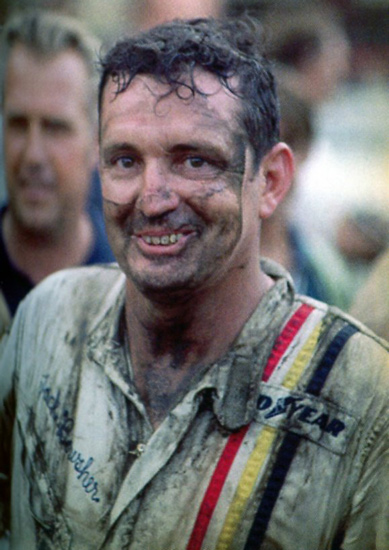 |
|
#1853 - It’s all in a season’s work.
Jack Bowsher had a terrific tour with his
self-owned USAC stock car in 1971. He won six,
racing at Tri-County, Eldora, New Bremen,
Wisconsin State Fair Park and Illinois State
Fairgrounds. From
UNITED STATES AUTO CLUB: Fifty Years Of Speed
And Glory, by Dick Wallen. (Photo, Dick
Wallen Collection) |
|
a |
|
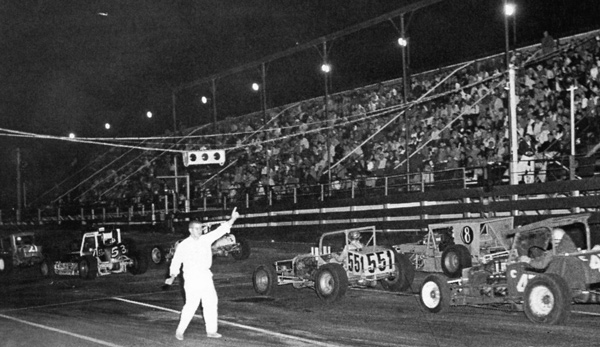 |
|
#1852 - Clyde Rowlee gives them one
more before the green at Oswego, NY, in
1964. The field includes Jim Shampine in the #8
ball, Jim Gresley in the #21, Roger Boas #53,
Leon Wieske #551, Bobby Baker #c47, and Bobby
Pierce #11. From THE PINE - The Authorized
Biography of Jim Shampine, the Greatest Open
Wheel Short Tracker of All Time, by Andy
Fusco with George Caruso, Jr. (NOTE – We are
reprinting this popular book right now so watch
the home page in about a week!) |
|
a |
|
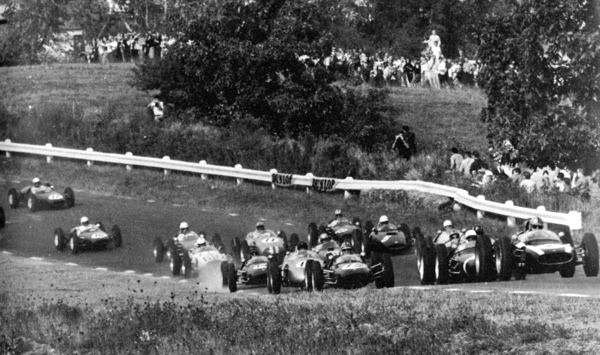 |
|
#1851 - Moments after the
start of the 1961 United States Grand Prix at
Watkins Glen, traffic conditions became a tad
congested. Jack Brabham was up front in a Cooper
with Stirling Moss right behind in Rob Walker’s
Lotus. Further back, Jim Clark’s Lotus, way low,
stirs up some dust in front of Walt Hansgen.
From WALT HANSGEN: His Life and the History
of Post-War American Road Racing, by Walt
Hansgen by Michael Argetsinger. (Ron Nelson
Photo) |
|
a |
|
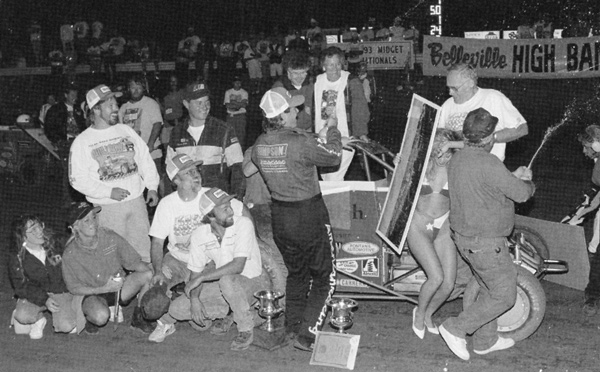 |
|
#1850 - Tony Stewart once
said he wished someday to be able to run the top
like Page Jones. Jones was so hot winning the
1993 Belleville Midget Nationals in the Kunz
Fontana Stealth that he had to cool everyone
off. Scantily attired celebrants take cover!
Photo from
THE HIGH BANKS: Belleville’s
Amazing Track and the Men Who Tried to Tame Her
1910-1997, by Beryl Ward, L.A. Ward, and Bob
Mays. (Mike Arthur Photo) |
|
A |
|
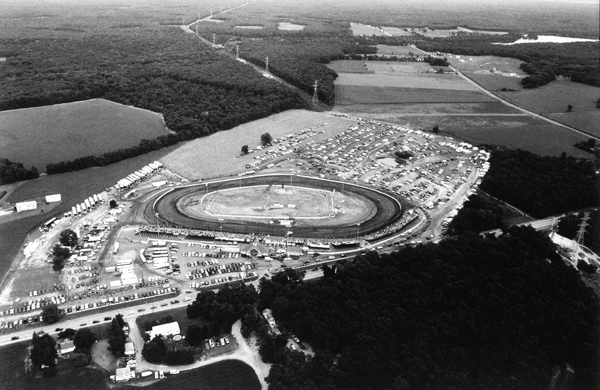 |
|
#1849 - An aerial view of New Jersey’s
New Egypt Speedway in 1998. Over the years it
has been a shape changer. From 1954 to 1958,
1960-1987, 1990-1992, and 1995-1996, it was a
1/5-mile asphalt known alternatively as Thunder
Bowl Speedway, Central Jersey Speedway, Ocean
County Speedway, and Fort Dix Speedway. In
1998-2000 it became a 1/3-mile dirt and in 2001
it was expanded to its current half-mile dirt
configuration. Photo from TOW
MONEY II –The History of the United Racing Club
from 1978 to 2006, by Buzz Rose and Jim
Chini. (Bill and Larry Wall Collection) |
|
a |
|
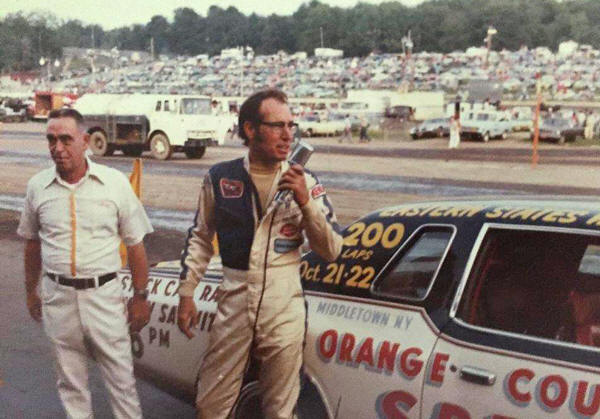 |
|
#1848 - Here's a classic from Orange
County in jam-packed Middletown, NY, sent to us
by Patrick Martin. That's his dad, Ray, on the
left. Ray usually had the mike, because he was
the respected announcer and publicist at "the
hard clay" for years. This day Buzzie Reutimann
must have been feeling especially talkative.
Perhaps he wanted to tell everybody about his
sideburns. (Patrick Martin Collection) |
|
a |
|
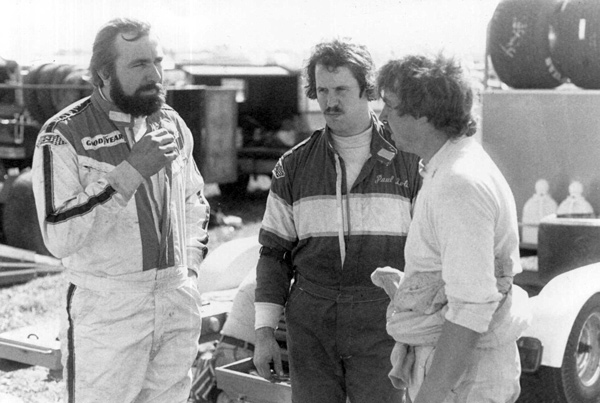 |
|
#1847 - Three daring disciples of the
church of the Eastern clay. L-R were Gary
Gollub, Paul Lotier, and Fred Rahmer. They
preached sensational sermons, be it in a
Sprinter or a hard top, on a big track or a
bullring. (Tobias Family Collection) |
|
a |
|
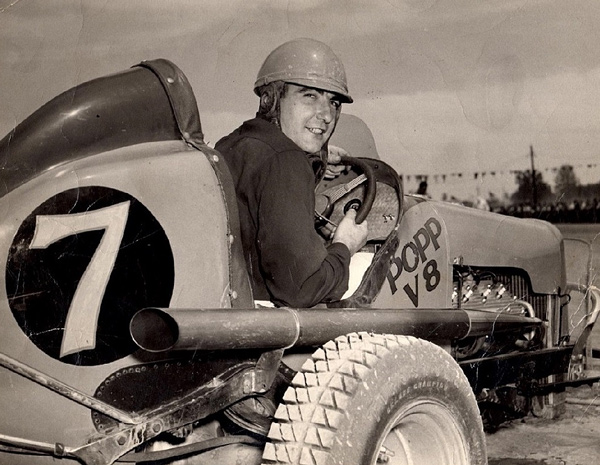 |
|
#1846 - Our friend Dean Wright sent
along this neat shot of his father, Ennie, with
a V-8 60 at Monroe County Speedway in 1948. The
track was a half-mile dirt oval at the
Rochester, NY, Fairgrounds, known for its wide,
smooth, and ultra-fast surface. It was a
favorite for fans and guys like Dutch Hoag, Bill
Wimble, Elmer Musclow, and Lee Osborne in full
coupe days, but also was visited numerous times
in the ’50s by the NASCAR Grand National
travelers. How cool to race there with a
cageless Midget! (Wright Family Collection) |
|
a |
|
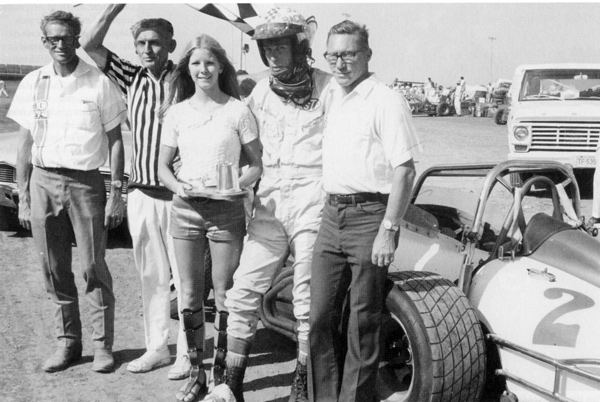 |
|
#1845 - “Jon Backlund had quite a day
on August 26, 1971 at Belleville. He crashed his
regular ride, the Jim Mahoney Chevy in
qualifying, then jumped into Harry Ivers’ car
for the first heat which he won, then back into
the Mahoney car for the third heat, finishing
fourth. Back to the Ivers car for the semi,
which he won, then into the Mahoney car for the
feature, winning again. For those keeping score,
that’s four races, two cars, and one BCRA title
– not a bad day’s work!” From
THE HIGH
BANKS: Belleville’s Amazing Track and the Men
Who Tried to Tame It, 1910-1997, by Beryl Ward, L.A.
Ward, and Bob Mays. (L.A. Ward Photo) [So, Jon,
never mind all that. What’s her name?! ] |
|
a |
|
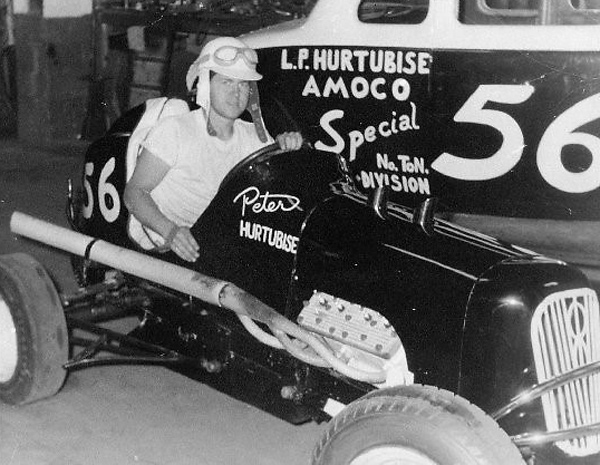 |
|
#1844 - Ford Easton, who recently
published a neat book
Stock Car Racing in the '50s: Pictures and
Memories from Western New York and Northwestern
Pennsylvania, sent along this very cool
shot of Jim Hurtubise’s brother, Peter. While
working at their uncle’s service station in
Tonawanda, NY, the 20-year-old decided to ditch
his hydroplane and come onto land. He ran both
Midgets and stock cars on the local circuit,
including events at the infamous Buffalo Civic
Stadium. For more on the Civic Stadium, see
Daredevils of the Frontier. (Photo,
Ford Easton Collection). |
|
a |
|
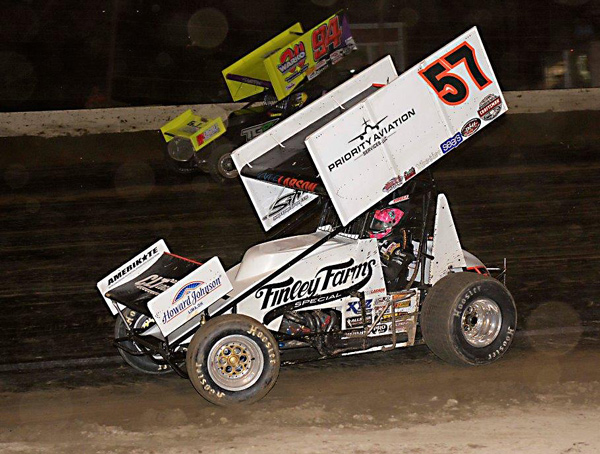 |
|
#1843 - Pure and simple, it was a
promoter's dream. One Tuesday back, July 4, Kyle
Larson stopped by Bob Miller's Thunder on the
Hill Series at Grandview, PA. It turned out to
be yet another win in Larson's astounding
Eastern Swing, and a totally packed house of
fans just loved it. But what made them really go
berserk was when local Ryan Smith in the Warko
Group #94 (above) appeared on the scene, making
serious moves to grab the lead. Then with five
to go he actually got by Larson on the outside
in turn two, only to clip the fence and flip
wildly in three. (Photo, Bob Miller Collection) |
|
a |
|
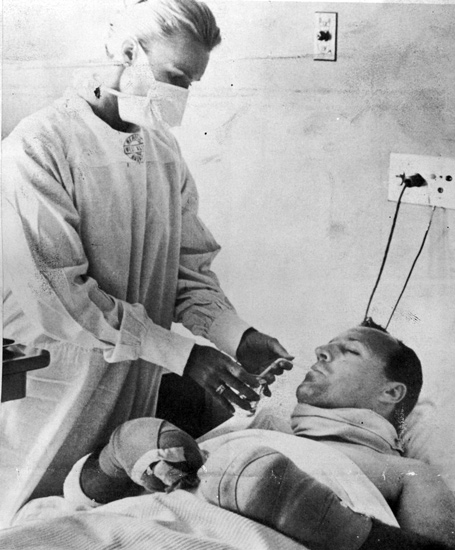 |
|
#1842 - In 1966 A.J. Foyt’s
own car was wiped out on the first lap of the
Indy 500. His response was to buy the
second-place finishing car, a Lotus Ford driven
by Jimmy Clark. It was then off to Milwaukee. In
a test session, the left rear suspension of the
car broke, and A.J. clobbered the wall. The car
was engulfed in flames, and manly A.J. reached
down to force himself out of the car, burning
his hands severely in the process. Here wife
Lucy helps him with a drink in the West Allis,
WI, Hospital. The cost of the ten-lap test:
$50,000. (Photo from Illustrated Speedway
News, June 14, 1966) |
|
a |
|
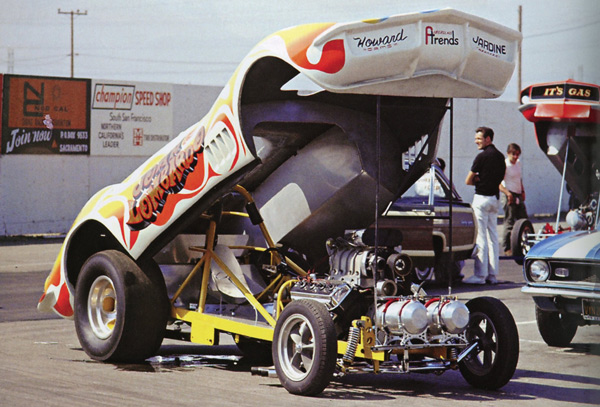 |
|
#1841 - Lil John Lombardo’s
1970s-era AA/GS Corvette had a dramatic
psychedelic wrapper, but, as the saying used to
go, “It ain’t how you look, it’s what you got
under the hood.” In Lombardo’s case, it was a
straightforward chassis and roll bar design.
From
MATCH RACE MAYHEM – Drag Racing’s Grudges,
Rivalries, and Big Money Showdowns, by
Doug Boyce. (James Handy Photo) |
|
a |
|
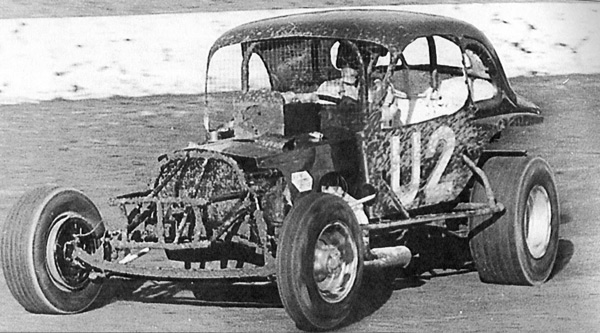 |
|
#1840 - A moment in time. High noon
with the Reading Stock Car Association. Gary
Butler hustles through the second turn at
Reading in the 1970s with a minimalist Ford
coupe atop a flyweight center-steer chassis,
powered by an injected big block, cushioned by a
good ol’ buggy spring and a suicide front end.
From Mike Feltenberger’s STRAPPED IN
magazine, July 2014. (Zellers Photo)
|
|
a |
|
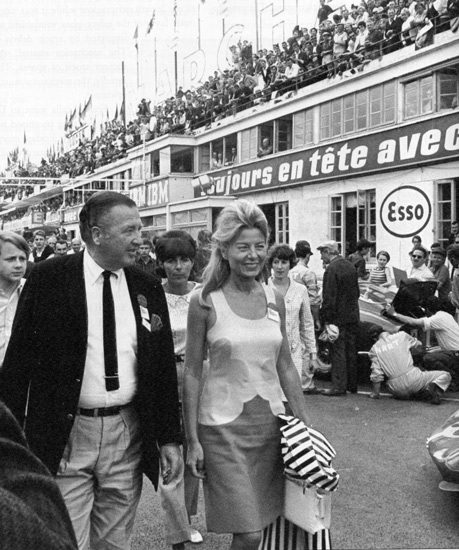 |
|
#1839 - “Henry Ford II and wife
Christina, with Ford’s son, Edsel, in tow.
Christina reportedly bet $1,000 that Ferrari
would win the 1967 Le Mans race. Her flippant
reply to questions about the bet was, ‘After
all, I am Italian.’ It did not endear her to the
Ford crew. Not that she would have spoken to
them anyway.” Photo and Quote from
KAR-KRAFT: Race Cars, Prototypes, and Muscle
Cars of Ford’s Specialty Vehicle Activity
Program, by Charlie Henry. (Photo
courtesy Ford Images) |
|
A |
|
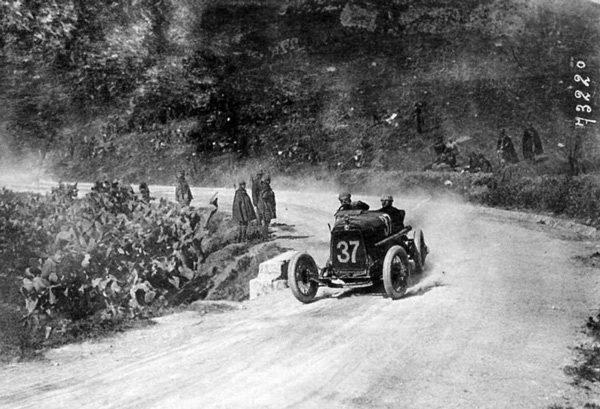 |
|
#1838 -
Here’s
a scene from the 1922 Targa Florio in the
mountains of Sicily. The oldest sports car
racing event, it started in 1906, and one of its
early competitors was Enzo Ferrari. Here he
horses an Alfa Romeo through a turn before a
not-so-huge crowd. Good thing. No one had given
a lot of thought to crowd control. Photo from
KAR-KRAFT: Race Cars, Prototypes, and Muscle
Cars of Ford’s Specialty Vehicle Activity
Program, by Charlie Henry. |
|
a |
|
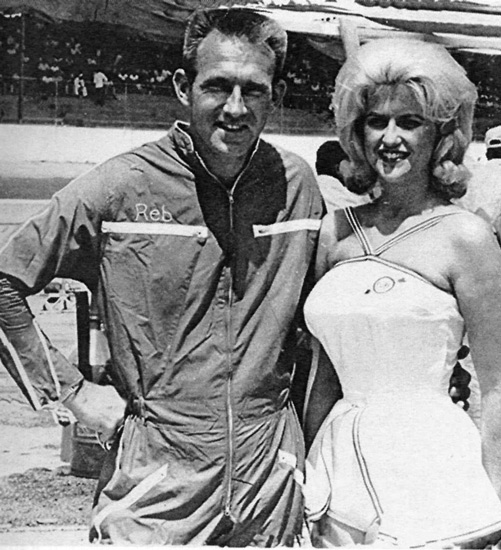 |
|
#1837 - Two non-stop characters, Reb
Wickersham and Linda Vaughn in the early 1960s.
Reb recalls, “While I was recuperating from my
accident at Darlington, I was on NASCAR
compensation of workers’ comp or whatever. They
were paying me $75 dollars a week, which was big
money in those days… A friend of mine says, ‘Why
don’t you get into boat racing?’… I went to
California and picked up one of those big ski
boats …and brought it back to Florida. It had a
Bill Stroppe engine in it, a big Merc in that
sucker, and I took it back and put straight
pipes on it. Went to a race down in Palm Beach
and was runnin’ about 125, 130. The boat was
only 17 foot long and weighed about 1,200 with
that big engine in the back of it. I was runnin’
this race on the intracoastal waterway and was
just kickin’ ass, nobody staying near me.
Somebody took a picture of me goin’ under the
bridge and my boat was out of the water by about
three feet. That picture hits the damn papers on
the West Coast of Florida and the next thing I
knew NASCAR called and says, ‘We’re cuttin’ off
your money right now ’cause you’re not hurt.’
That was the last of my worker’s comp.” Photo
and quote from
DECLARATIONS OF STOCK CAR INDEPENDENTS,
by Perry Allen Wood. (Photo Wickersham
Collection)
|
|
A |
|
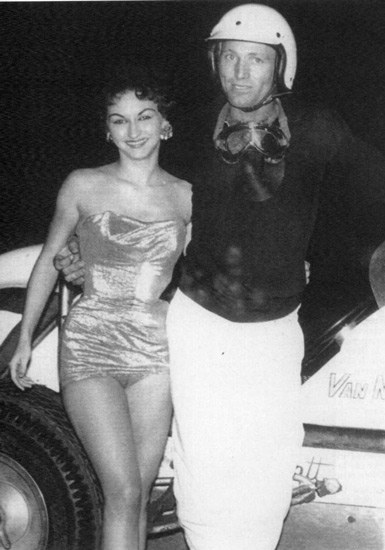 |
|
#1836 - Happy go lucky and cageless
with the California Racing Association, Reseda’s
Leon “Sonny” Pratt won the 30-lap Sprint Car
feature at Ascot Park on the summer solstice,
June 21, 1961. A week later he rode someone’s
wheel and flipped, landing hard and upside
down. He died on the way to Gardena Hospital.
(Photo from
RACERS AT REST, by Buzz Rose, Joe
Heisler, Fred Chaparro, and Jeff Sharpe, Sharpe
Collection) |
|
a |
|
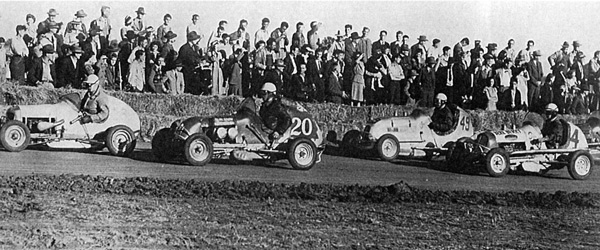 |
|
#1835 - The start – Chillicothe, MO,
1946 and Phil Catalina, George Binney, Frank
Bailey, Larry Bunch, and Jim Summers bring them
down. Better to be perched in one of those
topless Midgets or be standing behind one of
those hay bales? (From 80 YEARS OF MIDGET
RACING, presented by Allstar Midget Series) |
|
A |
|
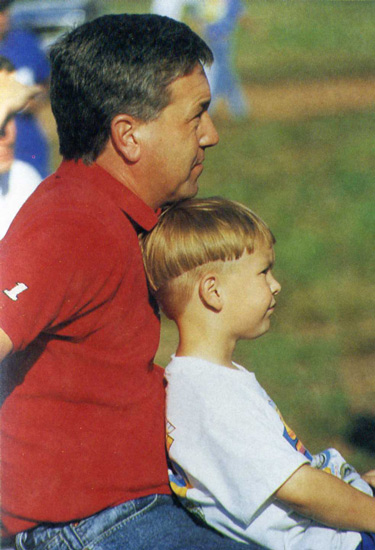 |
|
#1834 - Swindells in profile. Sammy and
Kevin. (Photo from Knoxville Nationals program,
1994) |
|
a |
|
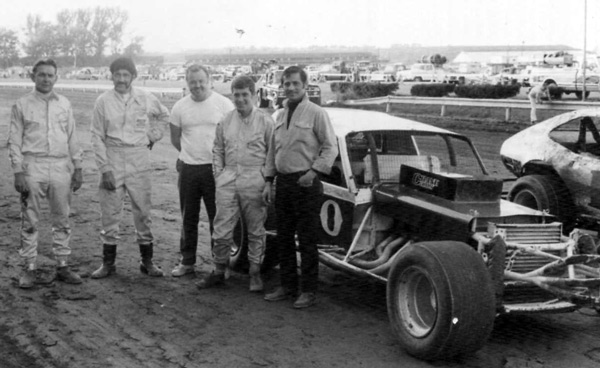 |
|
#1833 - Here’s
a shot from the front straight at the old
Syracuse Mile in September of 1973. It probably
belonged on some Post Office walls. Left to
right, aside Joe Leto’s mighty Gremlin Modified,
were Budd Olsen, Maynard “Cyclone” Forrette,
Jimmy Shampine, Lee Osborne, and Tommy Corellis.
(Coastal 181 Collection)
|
|
a |
|
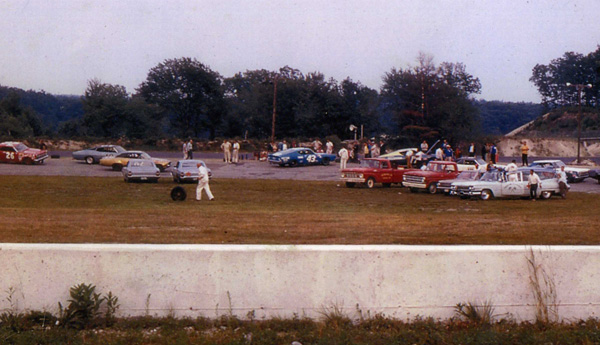 |
|
#1832 - Another place, another time.
It was July 10, 1969 when the weary NASCAR Grand
National highway men pulled in to the Thompson
300 at Thompson, CT, the 30th show of the
circuit. It all looks pretty primitive –
Thompson with its infamous sand banks and the
NASCAR field just a little less kitted-out than
today. But they were all there. Of the 31
starters, only Dick Watson, Ken Meisenhelder,
and Roy Halquist were from New
England. David Pearson won it with James Hylton
and John Sears sharing the podium a lap down.
(Photo from Bruce Nichols) |
|
a |
|
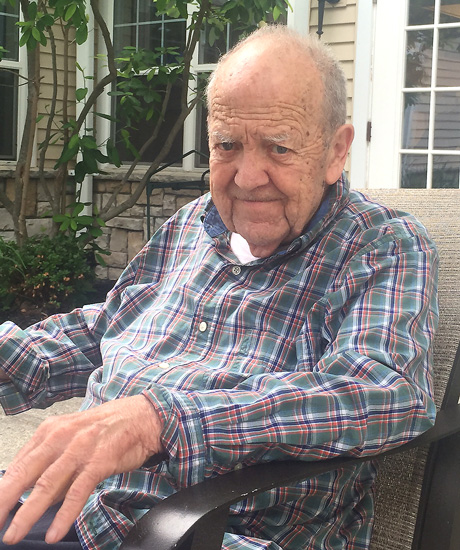 |
#1831 - Mark Juron and John
Christopher sent in this guest Photo of the Day.
A surprise birthday party will be held at
Albany-Saratoga Speedway in Malta, NY on June 30
to honor the unforgettable racing lensman, John
Grady, on his 87th. Here's what they have to
say:
Photographer John Grady from
Schenectady, NY, has recorded over 50,000 stock
car racing images, from the late 1950s to the
2000s. He began taking photos with Track
Photographer Irv Conran at Menands Speedway, NY,
in the late 1950s. Primarily, black and white
photos were taken for print and press. John was
one of the first to take color at night. Getting
the proper light and adjusting for the film of
the day was a challenge. John mastered that and
started selling photos and meeting press
obligations.
Utica-Rome Speedway, NY, in
1961, provided John with his first position as
Track Photographer where he befriended Joe
Lesik, track builder and promoter. He made the
weekly haul to Utica on Sunday nights to take
photos and manage a photo stand. He worked there
until the track was sold and Lesik built the
"new" Albany-Saratoga Speedway in Malta, NY, in
1965. Closer to home and with the endorsement of
Modified Champion Rene Charland, John became
Malta’s Track Photographer. John was the
photographer there for 15 years. He was noted
for the famous photo of then Modified champion
Rene Charland, whose car caught fire in May
1966. Eddie Flemke ran into the flames and saved
Rene. John often commented that it was the
bravest thing he ever witnessed in racing. He
went to Eddie afterwards and commented on it.
Eddie said, "He would have done the same for
me". John's response was, "Are you sure?"
He worked with various track owners and
promoters. Larry Mendelsohn and Spectacular
Promotions from Islip, NY, brought Grand
National racing to Albany-Saratoga in the early
1970s. John was there from the transition from
asphalt to dirt, and worked with promoter C.J.
Richards during the transition. John and his
wife Sondra and son Chris ran the novelty stand
and photos, during this period, as well.
He was the Track Photographer at Fonda Speedway,
NY, in 1979 for one year, and then it was onto
Howard Commander's, Lebanon Valley Speedway.
John worked at Lebanon Valley for 15 years and
sold thousands of photos "off the wall" with no
booth, just tables. He was noted for selling
photo grab bags. Three photos for one dollar.
With the help of announcers Dan Martin and John
Stanley, he sold thousands of these to race
fans, primarily kids.
Eventually he
returned to Fonda Speedway to work with son
Chris, who ran the novelty stand, selling photos
old and new. He worked there with Ralph Compani
and Ric Lucia for another 15 years, primarily
freelance.
John was a friend to many in
the racing community. His sense of humor and
story-telling from racing history made many
laugh. He loved giving photos away and also
making a "few bucks" with racing. He commented
that he loved racing and never had to pay to
enter a track!
A NYSSCA Hall of Fame
member in 2004, writer for the Daily Gazette for
ten years with his weekly Stock Car Column, and
photos in all racing publications are just a few
of his accomplishments. As an elementary school
teacher, at Niskayuna School District from
1963-1987, John was also entertaining.
John's 87th birthday is June 30th. It will be
held at Albany-Saratoga Speedway. His son Chris
and Historian Bob Novak will have thousands of
his photos on display at the track. Race fans
are encouraged to look at photos and say hi and
Happy Birthday to John, who has been struggling
with dementia the past few years. With the help
of Andrea Johnson, Ronnie Johnson's mom, he was
able to stay home until recently. He is now in
Brookdale, Dementia Care Facility, in Niskayuna,
NY. John's wish was to "get his photos out
there, they are no good sitting in boxes, in the
garage," so fans are invited to visit with John
and look at so many wonderful racing shots.
Photos are for sale, and all proceeds will go to
the Dementia Society. |
|
a |
|
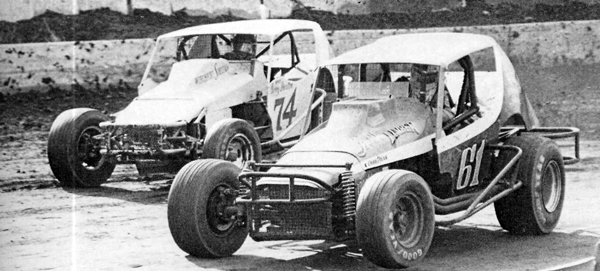 |
|
#1830 - After a few rocky
years at the beginning of his career, Scotia,
New York’s C.D. Coville undertook the long
weekly tow to Reading, PA, at the dawn of the
’79 season. After four weeks, he apparently grew
weary of the miles, but he was leading in
points. He’s certainly on the gas in this shot,
beneath Reading veteran Bobby Braxton (who would
end up with 119 RSCA top tens). When C.D.
decided to stay put in Upstate, he had become a
different driver. He was now “Super CD.” Photo
from READING FAIRGROUNDS – Modified Memories,
Vince Vicari, Editor. |
|
A |
|
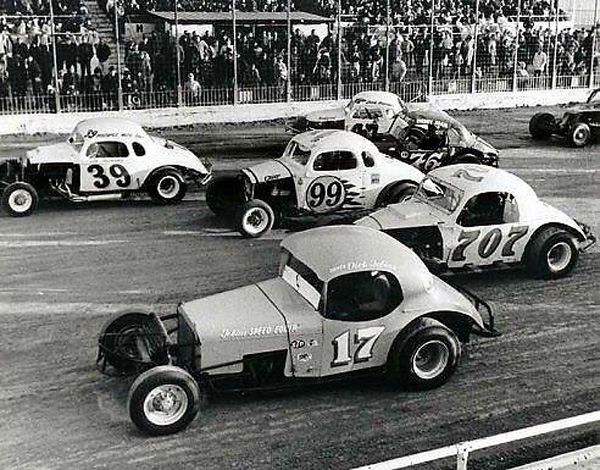 |
|
#1829 - Reading Stock Car
Association, 1968. Could there ever be another
one? (Tobias Family Collection) |
|
a |
|
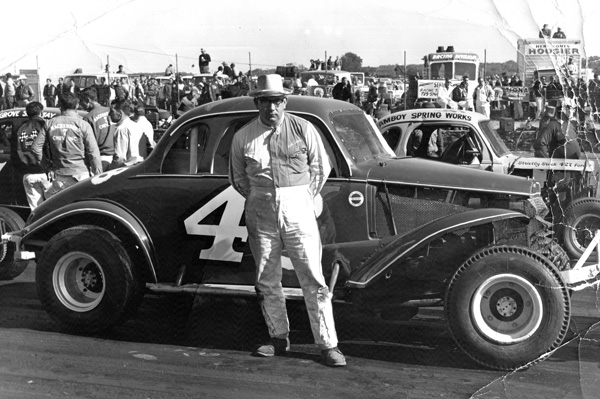 |
|
#1828 - That’s Dick Tobias
looking you right in the eye from the front
stretch at Langhorne, PA, in 1964. Toby was
especially focused when he ventured to the
circular mile, as getting to Indy was always in
the back of his mind. He had some great rides at
the ‘Horne, including this Sterling Lerch coupe.
It was powered by a engine from a Pontiac
Catalina that had been defective from the
factory and was donated to the team. It was
rebuilt and sent to Daytona where Smokey Yunick
installed injection and dyno’ed it to perfect
pitch. Even with this weapon, Toby was unable
ever to match his fast time and second-place
finish a couple of years earlier. That had been
in John Regester’s bug-like #6, powered by a
peashooter 283 Chevy. Our book on Toby and his
star-crossed family will be out in the fall.
(Tobias Family Collection) |
|
a |
|
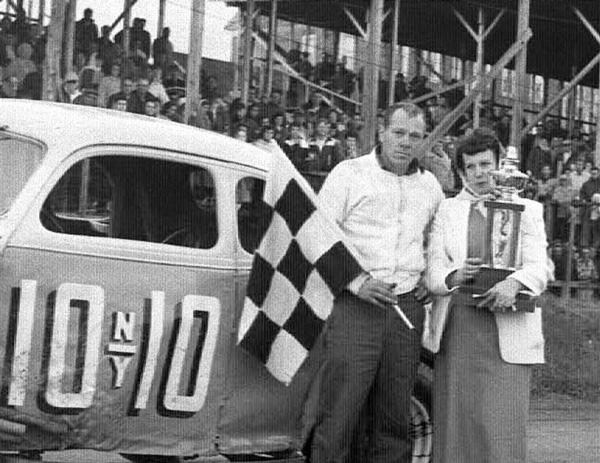 |
|
#1827 - Early on in the 1957
season, fun-loving, big loving Don Hendenberg,
"the bear who walked like a man," looked forward
to another possible championship at his home
track, Fonda, New York. But a tree got in the
way of his Volkswagen bug one morning, and he
died. For whatever reason, Fonda management
turned down the suggestion for a benefit race.
It ended up taking place far to the east. On a
Sunday night a whole gaggle of upstate New York
runners towed all the way to Bennington,
Vermont's State Line Speedway, owned and
operated by Pete Corey's uncle. The solemn
100-lap memorial was taken by Cliff Kotary, "the
Copper City Cowboy” from out by Rome, near
Syracuse. He drove using his left foot on the go
pedal as his right foot had been temporarily
rendered immobile by a gunshot wound. (Coastal
181 Collection) |
|
a |
|
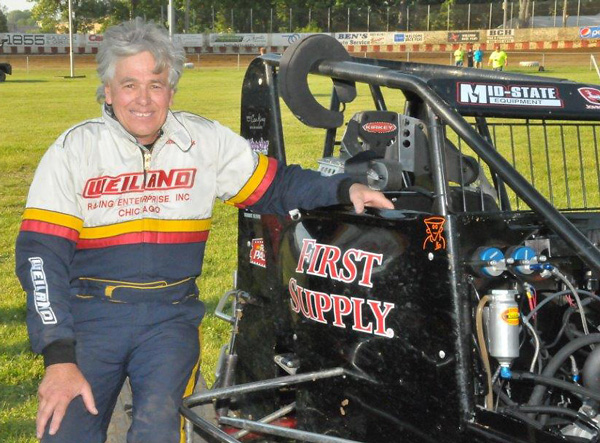 |
|
#1826 - It could have easily
been from 1970, but it ain't. It's last Sunday
(06-11-17). The unstoppable KO was caught
suiting up yet again for an evening's action at
Sun Prairie. Kevin Olson's new book
CAGES ARE FOR MONKEYS is, no contest,
our best-selling book to date in 2017. (Photo by
Father Dale Grubba) |
|
a |
|
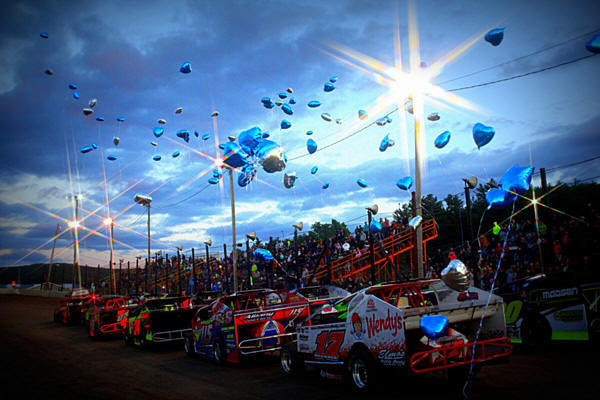 |
|
#1825 - Five years ago up-and-coming
racer JC Flach perished at his family property
in Coeymans Hollow, New York, when a tree fell
on him. He was the 2008 New York State Stock Car
Association rookie of the year and was extremely
popular, as is his family, so active at Lebanon
Valley Speedway for years. A week ago the track
held its fifth memorial event. (Photo by our Man
from Amsterdam, Dave Dalesandro) |
|
A |
|
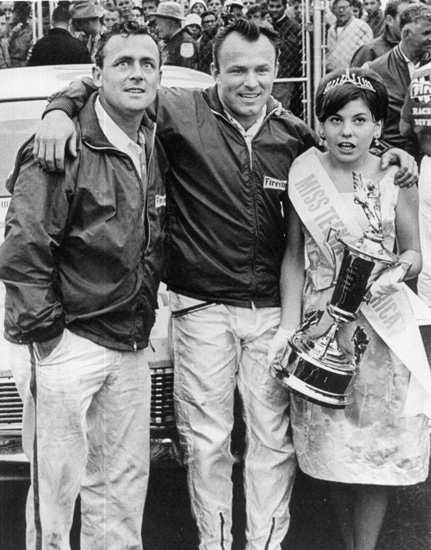 |
|
#1824 - In Victory Lane with Fred Lorenzen and
co-crew chief Jack Sullivan at the 1965 Daytona
500, Miss Teenage America seemed to be asking,
“What in the world just happened?” So was
Freddy. “It all came too fast, too quick. I got
into racing too early and quit too early. I was
good for another five or six years. I was at my
prime, but I’d won about everything there was to
win and I had plenty of money. I was sick with
stomach ulcers, and I was tired of traveling and
living out of a suitcase. Most of all the spark
was gone; the candle was out; the King (Fireball
Roberts) was dead.” Quote and Photo from
HOLMAN MOODY: The Legendary Race Team,
by Tom Cotter and Al Pearce. (Don Hunter Photo) |
|
a |
|
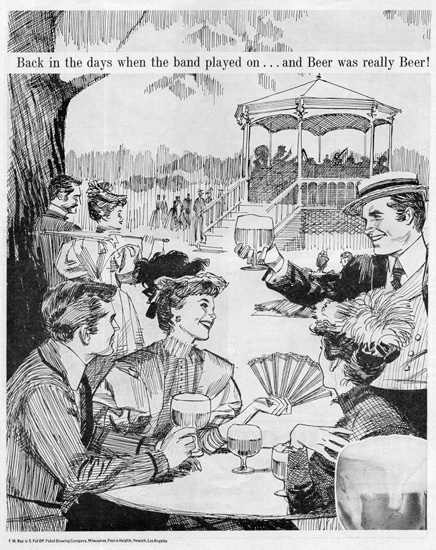 |
#1823 - Accomplished
Portland, Oregon, native Len Sutton had a very
happy day on the Milwaukee mile on August 25,
1960, winning the 200-mile USAC Champ Car event.
Everyone must have figured that the fans were
going to have a happy day, too. After all, this
was the time of the oft-repeated line, “I’m from
Milwaukee where the beer comes from!” The day’s
racing program was literally saturated by
advertisements for hops. This one is kind of
neat, but also curious. The advertiser, Pabst,
only saw fit to mention its name in microscopic
print in the lower left.
|
|
A |
|
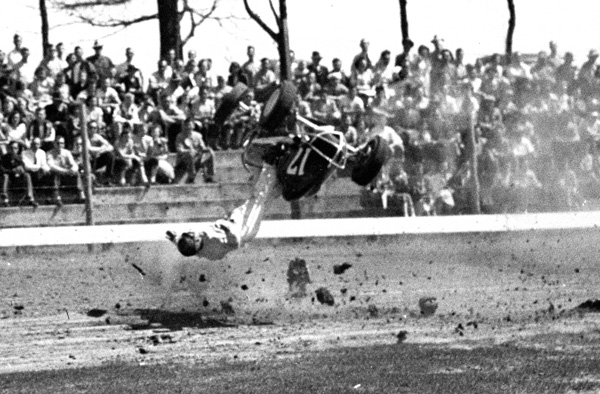 |
#1822 - Midget racing has
not been for the faint of heart over the years,
as this 1950 shot of Al Pavasil at Sun Prairie’s
Angell Park demonstrates. There is a lot of
evidence about that these days at Coastal 181.
We are finishing up an incredibly thorough
photographic and statistical history of Midget
racing in the Wisconsin, 1930s - 1961, written
by Loren Olson. Long live Angell Park! (Armin
Krueger photo, Greenfield Gallery Collection)
|
|
A |
|
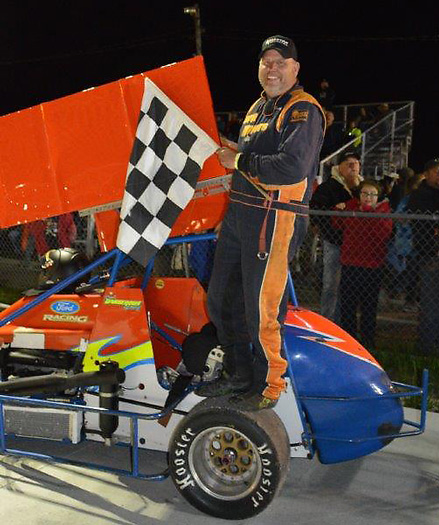 |
|
#1821 - Richard and Vanessa Jordan,
the energy force behind the wonderfully revived
Wiscasset (Maine) Speedway, are doing all the
right things. Great shows; great crowds.
Speaking of shows, popular veteran Midget
driver, Paul "Dangerous" Scally put one on a
couple of weeks ago. He was running really well
in his full NEMA car, but it broke in the main.
So he decided to "go for it" when he chugged out
in his NEMA Lite – and right to the front he
went. With two to go, he was praying "nuthin'
would break" and when he pulled into Victory
Lane – for his first time – "the adrenaline
carried me right up on that tire!" Asked what
this "Dangerous" moniker is all about, Paul
laughs, explaining that he was pinned with it
one night by a competitor and he decided to keep
it. "It's not all that bad to be called
“Dangerous" when you are starting on the inside
of a fast outside row!" (Crystal Snape Photo) |
|
a |
|
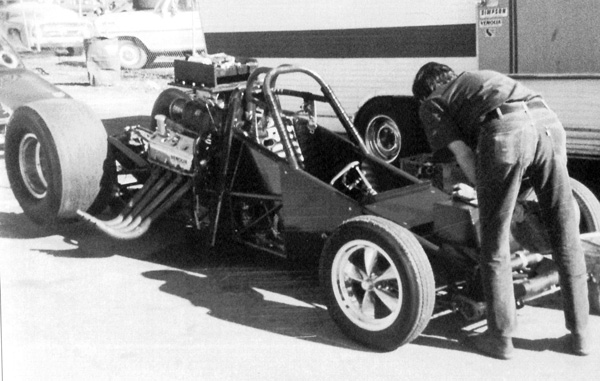 |
|
#1820 - "Jim Dunn’s Woody
Gilmore-designed rear-engine Plymouth Barracuda
was considered the only successful rear-engine
Funny Car of its time. Jim won the NHRA
Supernationals in 1972, running the high gear
drive only with a 6.44ET." Quote and Photo from
DRAG RACING FUNNY CARS of the 1970s, Photo
Archive, by Lou Hart and Wallace A.
Wyss. (Photo by Steve and Kathy Dull) |
|
a |
|
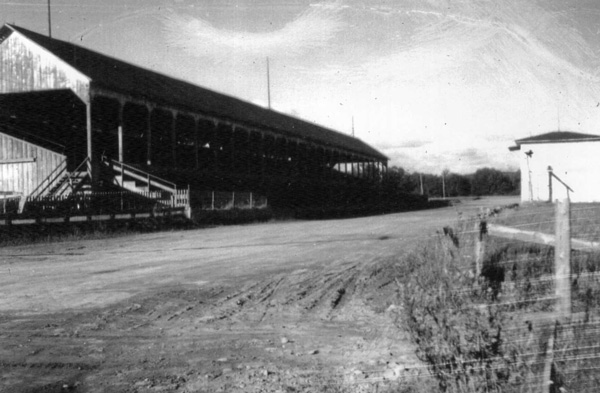 |
#1819 - This shot, labeled
August 12, 1957, was taken at the Otsego County
Fairgrounds in Morris, NY. From 1949 through
1972 racing was held on the dusty, half-mile
paperclip-type oval under the alternative
banners of Mid-State and Morris Speedways.
Occasional reunions are still held there. We
would sometimes tow out at the turn of the ’70s,
and it was a long 300-mile trip back to
Massachusetts on a Friday night. The first time
out it was immediately obvious – especially on
that high-speed backstretch – that the lighting
was not really sufficient. Concerned about what
to do, I turned to the local hot shoe, Dick
Hansen. He looked at me like I was kind of a
stroker. “Well, just do the usual thing,” he
said casually. “Count the light poles and then
turn left.” (Coastal 181 Collection,
photographer unknown)
|
|
a |
|
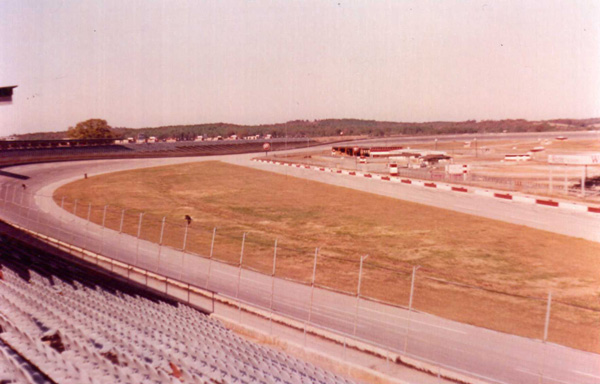 |
|
#1817 - Here’s a shot from
1982 depicting the enormity of Talladega
Speedway. What didn’t look that big, however,
was the catch fence. Good thing it went on
steroids over the years. And we bet Carl Edwards
would agree. (Mike McClelland Photo) |
|
a |
|
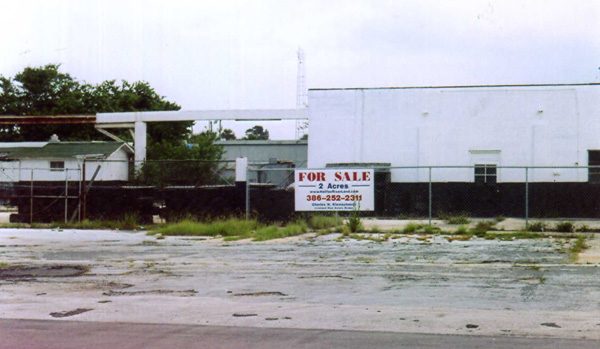 |
|
#1816 - If walls could
talk….Smokey Yunick’s shop, June 2005. (Mike
McClelland Photo) |
|
a |
|
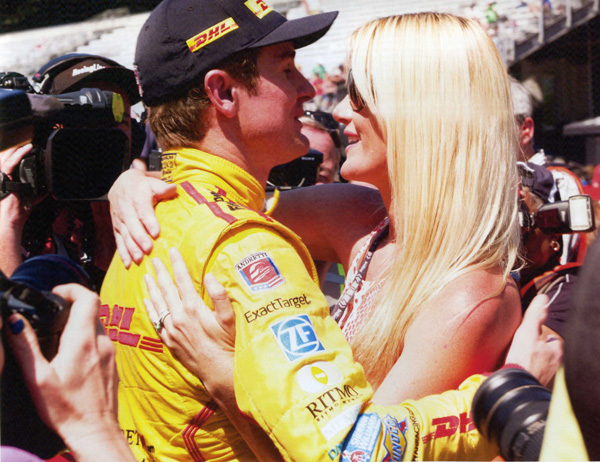 |
|
#1815 - Afternoon delight!
Fort Lauderdale’s Ryan Hunter-Reay swept the
2014 Indy 500 in the Andretti Autosport Dallara
DW12. Here he greets his wife Beccy Gordon
(Robby Gordon’s sister) in Victory Lane. From
THE RACE – Inside the Indy 500, by
James McGuane. |
|
a |
|
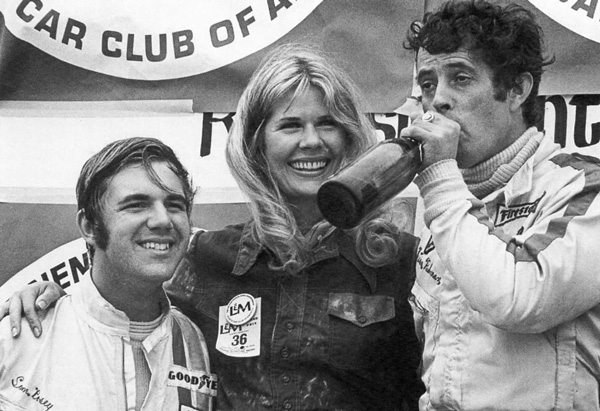 |
|
#1814 - It was quite the
crew in Victory Lane at the 1972 L&M Continental
5000 Grand Prix at Riverside, CA. L to R: Sam
Posey, Loretta “Hot Lips” Swift, and Brian
Redman. It is understandable that winner
Redman’s eyes were sending out kind of a mixed
signal as he raised the glass. But why was Posey
looking so pleased? You’d think he’d be a tad
unhappy: Earlier Redman had passed Posey under a
yellow flag. But Redman claimed he never saw the
caution, and so the SCCA just fined him $100 –
and he headed back to the UK with $17,800 in his
pocket. From
RIVERSIDE: Palace of Speed, by Dick
Wallen (Frank Mormillo Photo) |
|
a |
|
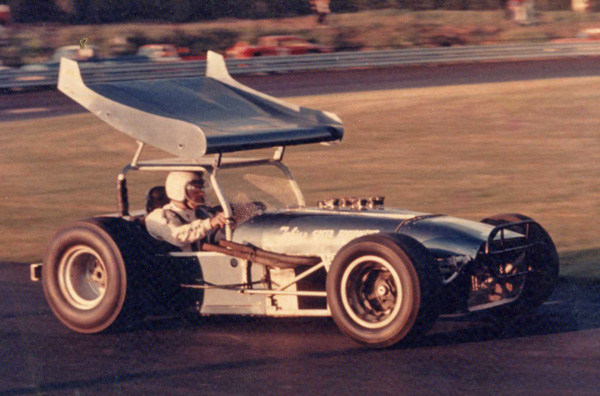 |
|
#1813 - Quite possibly, Dick Tobias
never slept at all. It was always something. In
1967, aside from running his speed shop in
Lebanon, PA, he was gunning for the Reading
Modified championship on both Friday and Sunday
nights. In between, he decided to try the
pavement at nearby Hershey Stadium that was
bringing in Supermodifieds on Saturdays.
Probably because he often said he would like to
get to Indy his own way – by racing in, he
picked up a former Troy Ruttman roadster,
shorted it up, and topped it with a wing. He won
the most features there that season and would
likely have won the championship, had it not
been for a violent mid-season flip. He broke his
arm, but that wasn’t enough to keep him out of
Victory Lane the next week. (Tobias Family
Collection) |
|
a |
|
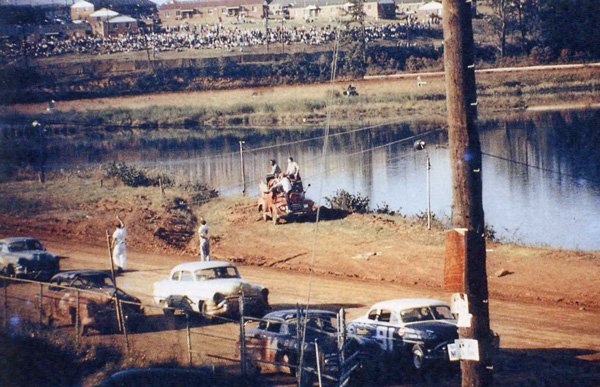 |
|
#1812 - It certainly was not
landscaped to Mar-a-Lago standard, but Lakewood
Speedway in Atlanta was one of the most infamous
tracks in the South. This shot was taken on
November 1, 1953 at the one-mile dirt facility
while the NASCAR Grand National cars lined up
for their season finale. The speedy Flock boys,
Tim and Fonty, started up front with their
Hudson Hornets, but in the end it was Buck Baker
with the trophy of the day. It took Herb Thomas
a 14th-place finish to capture the seasonal
title and pull in a princely $28,090.58 for a
summer’s work. Photo from NASCAR: The
Complete History, by Greg Fielden. |
|
a |
|
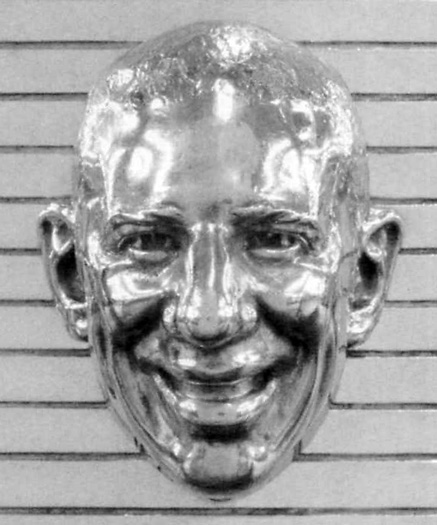 |
|
#1811 - “If anyone in modern
Indy car racing could be described as a
self-made man, it would be Tony Kanaan. In the
beginning no driver had less in terms of
financial resources, and no diver worked harder
to reach the highest levels of the sport….In
2013 the stars finally aligned for Kanaan. In a
race that can only be described as historically
competitive – 68 lead changes among 14 drivers –
Kanaan prevailed as the race finished under
caution. Finally the hard-luck man could turn
his machine toward Victory Circle.” From
Indy 500 Program, 100th Running, May 26,
2016. |
|
a |
|
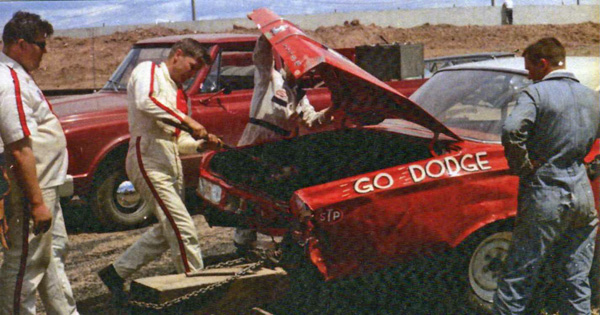 |
|
#1810 - Wisconsin racer
Bobby “Mr. B” Bennett ran USAC, IMCA and local
Late Model shows in the Midwest back in the day.
He’s shown repairing his Dodge at Wisconsin
International Raceway with a sledgehammer. No
question he was the type to do whatever was
necessary. “He suffered a major setback in
December 1968. A licensed pilot, he was flying
his plane while a group of people were fox
hunting on land near his home in Greenville. The
plane went straight down from an altitude of
about 500 feet and crashed into a field. ‘We had
25 guys hunting fox at the time,’ recalled
Bennett. ‘I was spotting for them. I’d see the
fox and dive bomb them so the guys would see
where the fox would be. The doctors think I may
have blacked out prior to the crash.’ Bennett
suffered 210 different fractures in his pelvis,
chest, legs, and arms in the crash. ‘I was back
racing the next April,’ said Bennett. ‘They’d
carry me from one car into the race car. I had a
block on the accelerator I’d use because my
ankle was shattered. In fact, I won my first
race after the crash. I beat Milo Van Oudenhoven
for the win.’” From LIFE IN THE FAST LANE: A
History of Stock Car Racing in Northeast
Wisconsin from 1950-1980, by Joe Verdegan |
|
a |
|
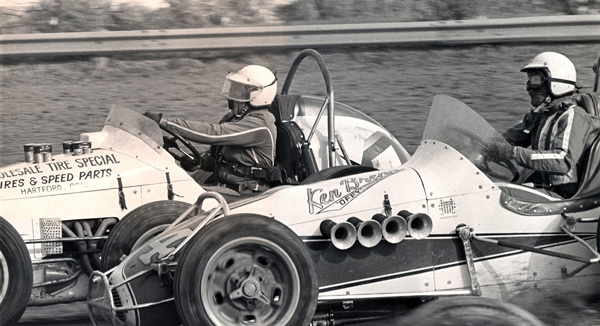 |
|
#1809 - What at period it
was in URC racing back in 1964. Whether it was a
Chevy or an Offy, the big boys were elbows up,
no cage between them and the stars. On the
outside was tough guy Bill Brown in the
Jorgensen #0 and Dave Lundy downstairs in a Ken
Brenn machine. From
SWAMP YANKEE: The Racing Life of Jim Jorgensen,
by Walt Scadden. (Neal Cunningham Collection) |
|
A |
|
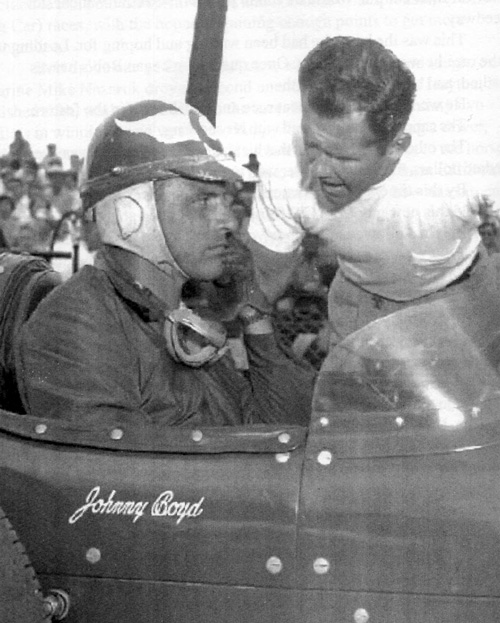 |
|
#1808 - Johnny Boyd (in car)
and Bob Sweikert had been buddies since the two
Californians competed on the West Coast circuits
in the 1940s. As they both migrated east to
Midwest competition and Indy, they looked out
for each other. It was Boyd who arranged
Sweikert’s first ride at Salem, IN, in 1952, and
a win was just the catalyst Sweikert’s career
would need. Just three years later he won Indy
in the Zink/Kurtis #6 roadster. But it was all
short-lived. On June 17, 1956, Bob looked
forward to coming back to Salem, his favorite
track. But coming off four in his heat race, he
ran side-by-side with another former Californian
competitor, Ed Elisian, and they touched.
Sweikert flew outside the track, landed about
100 feet below, on fire. It was not survivable.
From
EARLY SPEED KINGS: Twenty-four of America’s
Greatest Open Wheel and Sprint Car Drivers,
by Gerald Hodges |
|
a |
|
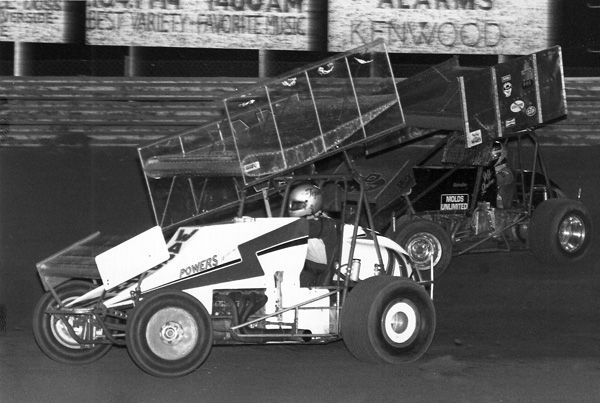 |
|
#1807 - “A rare USAC winged
show at Haubstadt (Indiana) in 1983, with Tom
Tepee ahead of Jeff Gordon. This was a period of
experimentation at all levels of racing, and
Tepee was trying out a Lexan wing. Vision for
other drivers was good as they could see through
it, but Lexan was heavy, tended to crack, break
and leave a mess on the track at times. As you
know, aluminum won out.” Quote and Photo from
DID YOU SEE THAT? Unforgettable
Moments in Midwest Open-Wheel Racing,
by Joyce Standridge. (Allen Horcher Photo) |
|
a |
|
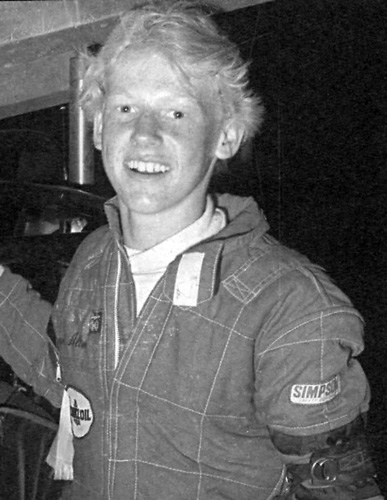 |
#1806 - “Sport Allen’s first
sprint car win came in 1984 at age 13. No
underage citations were issued as his dad was a
St. Pete (Florida) police officer. He’s shown
here in 1985 after becoming the youngest driver
ever to qualify for the Little 500.” He was
fourth at New Smyrna last Saturday, May 6, 2017,
in a 360 winged sprint. Quote and Photo from
FLORIDA MOTORSPORTS RETROSPECTIVE PICTORIAL, Vol
2, by Eddie Roche.
|
|
A |
|
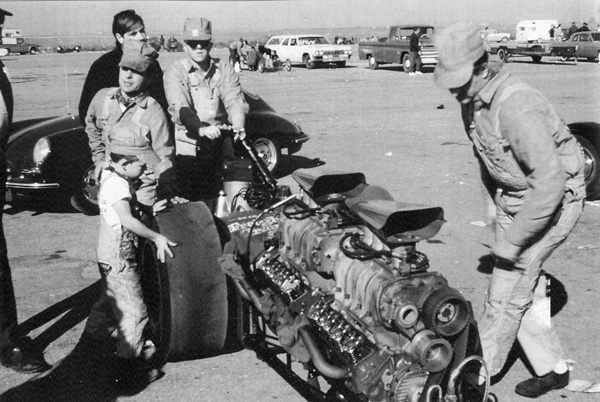 |
#1805 - Were these guys
ready or what? That’s John Peter’s team at the
March meet in 1965 at Bakersfield, CA. They are
tending to their legendary and thunderous
twin-powered Chevy Top Gas dragster, “the
Freight Train.” Apparently, the rail-men once
encountered the outlaw-branded crew of “Billy
the Kid” Scott on a starting line, and a major
shoot-out broke out called “the Great Train
Robbery,” and the cap guns were blazing. Photo
from SLINGSHOT DRAGSTERS OF THE 1960S Photo
Archive, by Lou Hart. (James Handy Photo)
|
|
a |
|
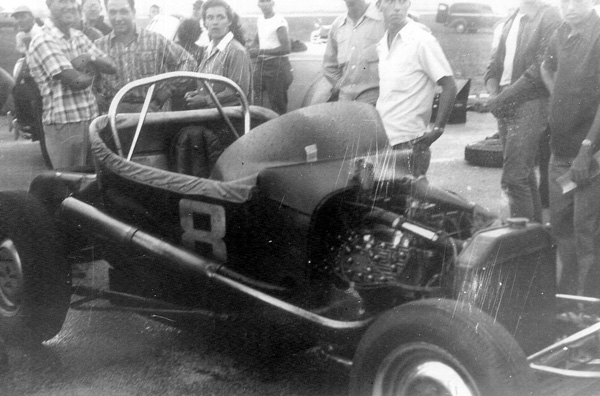 |
|
#1804 - The late ’40s-era
Roadster racing was a national phenomenon, and
this spiffy unit was apparently a big part of
it. Can you imagine competing in it on a mile
track? That was the case on this day when an
event was held at Florida’s Pompano Beach
Speedway. Here’s what Miami race buff Brian
Sharp has to say: “This was Andy Granatelli’s
car. I believe it is Duane Carter on the left,
Granatelli in the middle, and the lady is
Carter’s wife, Azra. I think this is the old Yam
Oka Roadster out of California. I think Jim
Rathmann drove it when he was in Chicago and he
may well have driven it this day. He lived down
here and had a speed shop here until he retired
from driving.” (Photo Brian Sharp Collection) |
|
a |
|
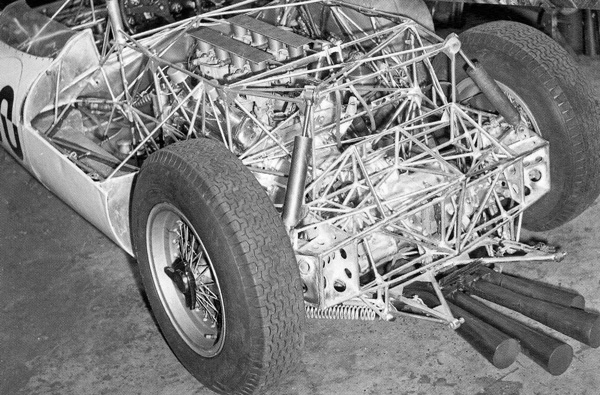 |
|
#1803 - In 1963 Carroll
Shelby, Briggs Cunningham, and Al Momo
collaborated on popping a Weber-ized 289 Cobra
into a just a little exotic “birdcage” Maserati.
Here’s how the exposed hind end looked, replete
with toothpicks. From
FORD TOTAL PEFORMANCE: Ford’s Legendary
High-Performance Street and Race Cars,
by Martyn Schorr. |
|
a |
|
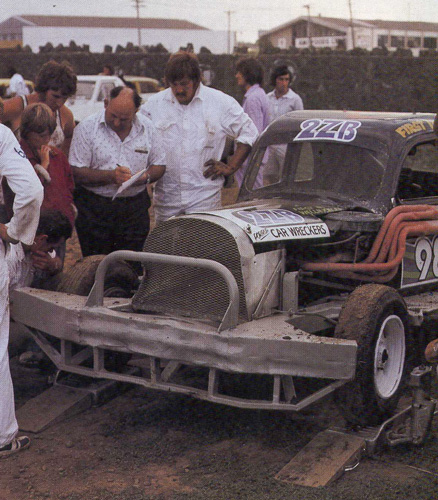 |
|
#1802 - This shot is from a
booklet called Stock Car Racing published in
1979 in New Zealand. This is the explanatory
caption. (Note the last sentence). “Race control
officials inspect each car to make sure seat
belts are secure and drivers have fire
extinguishers and safety gear. Each car must be
in safe condition and obey the rules for its
class. It has to have a weight ticket, too,
saying that it’s not too heavy.” From Stock
Car Racing, by Verne Newcombe, Mary Tagg,
and Robin Morrison. (With thanks to A.K. Bowie,
Auckland, NZ for the booklet) |
|
a |
|
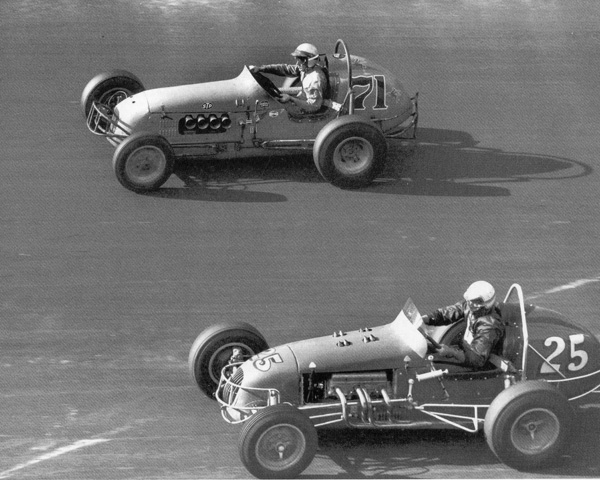 |
|
#1801 - A study in styles at
Winchester. “Johnny White gave Dizz Wilson his
first, and only, IMCA championship in 1962. It
would prove to be the last time an Offy would be
on the top of the podium. Here, White is
sweeping around the top of Winchester with
Gordon Wooley (C. Wilson Chevy 25) gliding in
the low groove”. Quote and Photo from
BIG CAR THUNDER : Sprint Cars on America’s Fair
Circuits, Volume 1, by Bob Mays. (Armin
Krueger Photo) |
|
A |
|
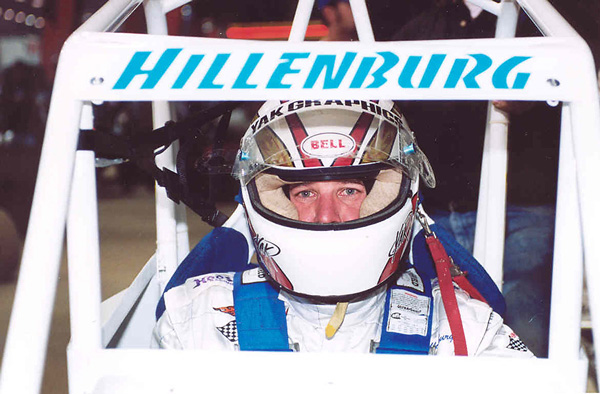 |
#1800 - Broken Arrow, Oklahoma’s Andy
Hillenburg had a world-class career in Sprint
Cars before retiring at age 35. He also won the
1994 Chili Bowl, a wild shootout with P.J. and
Page Jones, called the greatest race ever by
many who were lucky enough to see it. He was
driving the John Godfrey/Keith Kunz midget. Six
or seven years ago, Andy and his wife DeAnn were
at Port City Raceway in Tulsa watching their
boys Drew and Hayden in their Mini-Sprints. So
taken by the skills displayed by a 14-year-old
named Christopher Bell, Andy called Kunz and
said he had to keep an eye on this kid. That’s
just what Keith did. And this year, Christopher
became the second Oklahoman to win the Chili
Bowl, also in a Keith Kunz machine. (Photo –
Chili Bowl Collection)
|
|
a |
|
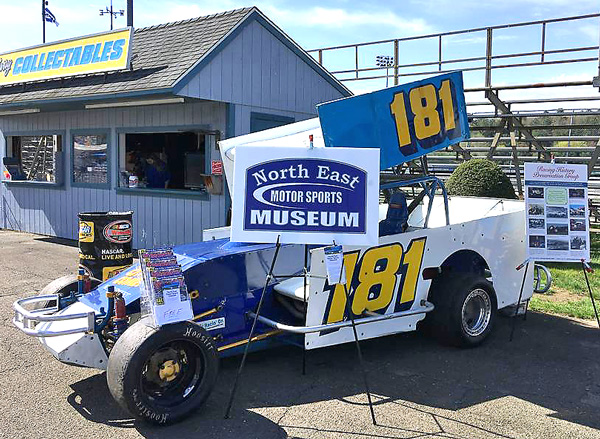 |
|
#1799 - We took “Jean,” our
late ’80s-era open comp dirt car, to the North
East Motor Sports Museum booth at the Spring
Sizzler at Stafford, CT, last weekend. Once
again by noon time the grandstands were packed.
So is the Museum (www.nemsmuseum.com),
with cars and all manner of memorabilia flowing
in on a daily basis in anticipation of the
opening barely over a month away. (Mark Hann
Photo ) |
|
A |
|
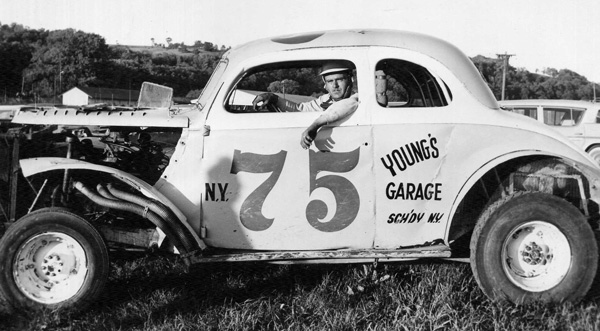 |
|
#1798 - Irv Taylor,
the great upstate New York wheelman back in the
day, passed away last week. He personified his
racy times. His deal was to turn a buck with a
race car and move on. Free agent; no binding
contract; no hard feelings. He drove for 22
different owners. Around the turn of the 1960s,
he landed a highly prized ride in Henry Caputo’s
283-fired ’37 coupe. They started out on the
tri-oval at Daytona (can you imagine?) and later
went to Middletown, NY. Irv started flipping. He
said, “The lights went out when I finally
stopped. I was okay and I got to thinking that
death ain’t that bad. Then a track light came
into focus, and I realized I had landed in a
gully and was covered with mud. We banged the
roof out, but Henry was really pissed. That’s
okay. I had other stuff to drive.” (R. S. Bergh
Photo) |
|
a |
|
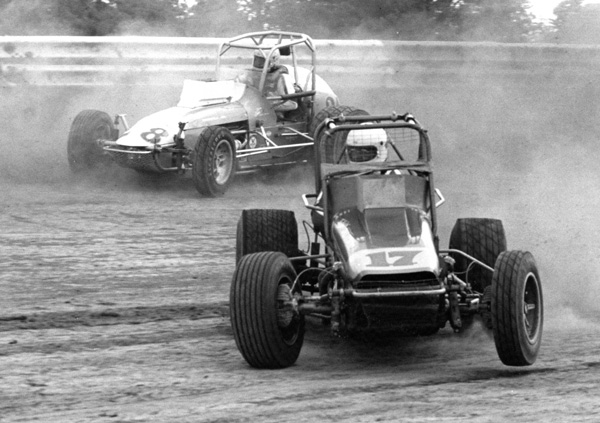 |
|
#1797 - May 6, 1978, Terre
Haute, IN, the Tony Hulman Classic, USAC Sprint
Cars. There was a bit of any empty feeling that
day, so soon after eight USAC officials had
perished in a plane crash coming back to
Indianapolis from Trenton. This shot late in the
race shows leader Dick Tobias in his blue and
yellow #17 just ahead of “Duke” Cook (did you
know his name is Dennis?) stormin’ upstairs.
Toby nipped him at the line for the win, but it
could oh-so-easily have been otherwise. Toby
broke motoring under the checkered and couldn’t
even get past the first turn. (Jack Gladback
Photo, Tobias Family Collection) |
|
a |
|
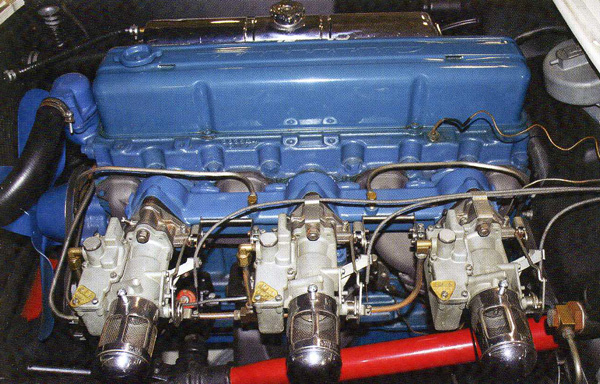 |
#1796 - “In 1953 Chevrolet
introduced America’s first fiberglass-bodied,
production line-built, two-seat sports car, the
Corvette. Since Chevrolet had yet to produce its
first modern V-8 engine, power for the Corvette
came from the old reliable Blue Flame ‘stove
bolt’ incline OHV six-cylinder that powered
passenger cars. The only concession to
performance came from a special intake manifold
mounting three side-daft carburetors. Further
hampering the Corvette’s performance was the
fact that the only available transmission was
the 2-speed Powerglide automatic.” Quote and
Photo from
DETROIT MUSCLE: Factory Lightweights and
Purpose-Built Muscle Cars, by Charles
Morris. (Photo Charles Morris Collection)
|
|
A |
|
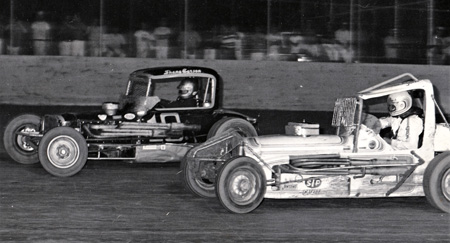
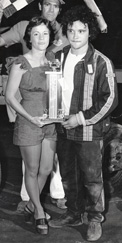 |
|
#1795 - It was a grand time in 1975 at
the Tulsa, OK, Speedway. Crowds of six to eight
thousand packed the place weekly. One of the
coolest divisions was the six-cylinder
Modifieds, and one of the emerging stars was the
irrepressible Shane Carson. That’s Shane making
haste on the outside in the first photo. In the
second, having won the dash, he is greeted by
trophy girl Deede Wade, niece of Kansas Sprint
Car great Grady Wade. Shane was in contention
for the title that season, but his runs were so
impressive that Vern Nance came along and popped
him into a Sprinter. And that was the beginning
of one great career. (Shane Carson Collection) |
|
A |
|
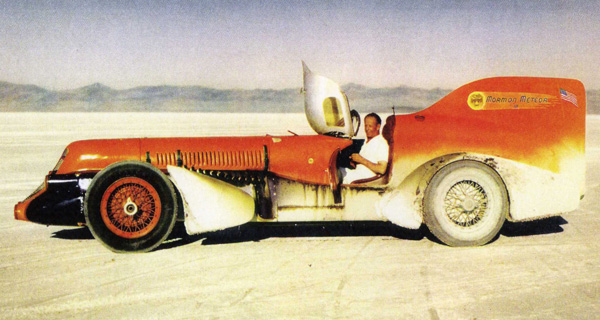 |
|
#1794 - It was July 1940 on the
Bonneville Salt Flats, and that was AB Jenkins,
the racing mayor of Salt Lake City. He had just
completed an amazing 24-hour run in the 700
horsepower Mormon Meteor 111, covering 3868
miles. The non-stop trial of speed and endurance
was sponsored by a most race-friendly Gilmore
Oil Company. Jenkins, averaging 161 mph, broke
21 world and 63 American records. From
ROAR WITH GILMORE: The Story of America’s Most
Unusual Oil Company, by Charles Seims
and Alan Darr. (Alan Darr Collection) |
|
a |
|
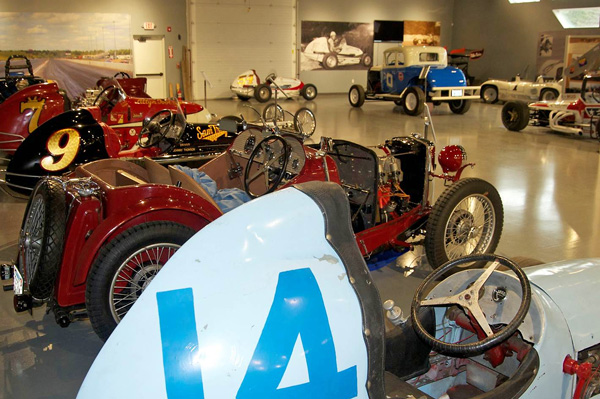 |
#1793 - Here’s at how the floor at the
new North East Motor Sports Museum on the
grounds of New Hampshire Motor Speedway is
shaping up. Cars in the photo include Reino
Tulonen’s Midget (#14), Peter Ross’s 1932 road
racing MG, the stretch Midget owned by Ray
Boissoneau and driven by Johnny Thomson, Skip
Matczak’s Big Car, the King & Marshall dragster,
Ray Boissoneau’s Leader Card Offy-powered
Midget, an early square-top that won at Bryar,
Sam Posey’s Can Am car, Ollie Silva’s Super
(tucked deep in the corner), and a Beech Ridge
Supermodified. The Museum will be open for an
initial viewing for members on June 10 and 11. A
general opening will follow shortly thereafter.
(North East Motor Sports Museum Photo)
|
|
a |
|
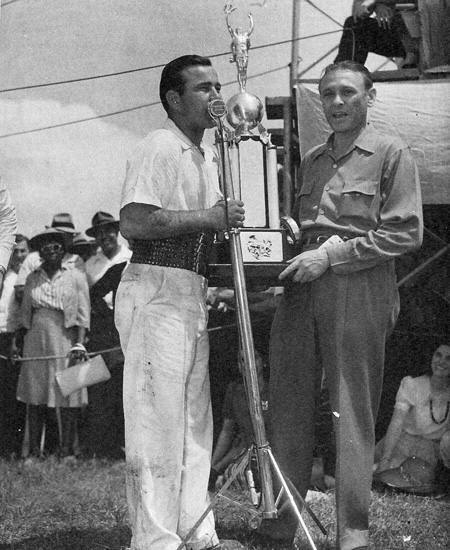 |
|
#1792 - Here’s Joie Chitwood on the
mike accepting the 1940 AAA Eastern Sprint Car
Championship from promoter Sam Nunis. They say
Chitwood was one of the all-time gassers. Evel
Knievel put it this way: “The first time I saw
Joie Chitwood perform in my hometown, Butte,
Montana, the thing that impressed my 15-year-old
mind the most was his intoxicating spirit and
incredible showmanship. It was then I knew this
business was for me.” Quote and Photo from
SAFE AT ANY SPEED: The Great Double Career of
Joie Chitwood, by Jim Russell and Ed
Watson. (LC Roberts Photo) |
|
a |
|
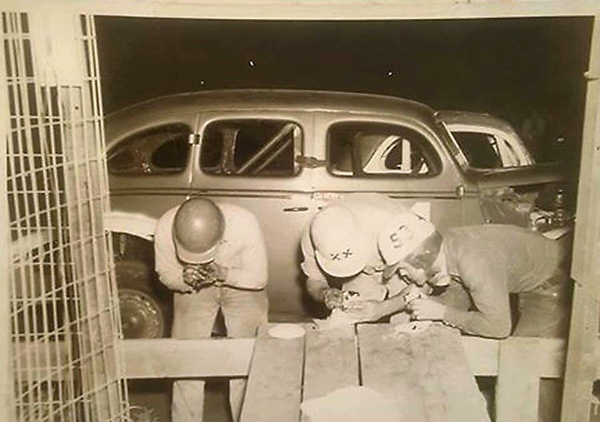 |
|
#1791 - Starter’s stand, Rhythm Inn
Speedway, Miller’s Falls, MA, August 24, 1951.
It really was another day. A special attraction
was the pie race. Race a couple laps, dismount
and dispatch a couple slices, and run a couple
more. But, some things never change. Those guys
on the right, “Sneaky Pete” Fournier (53) and
Bill Flebut (XX) had best be careful. That’s
Rene “The Champ” Charland separated just a bit
to the left, as if ready to make a quick
retreat. The Champ was always the scamp. He was
known to slide his cigar into the sandwich of
the poor soul who happened to sit next to him at
lunch…..(Ed Duncan Collection) |
|
a |
|
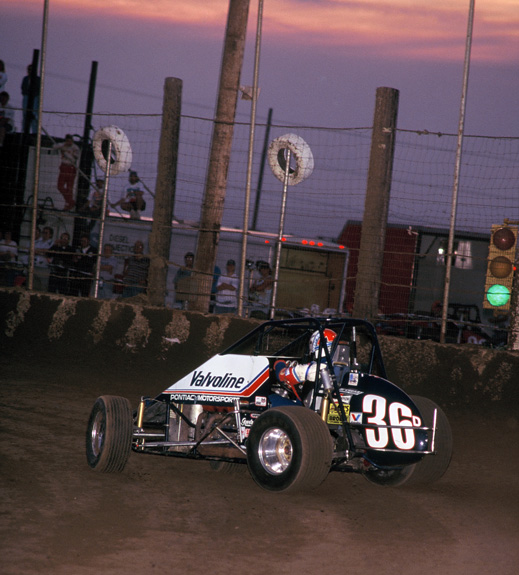 |
#1790 - Dave Darland first
ventured to Kokomo, Indiana, with a Sprint Car
on a Sunday in September 1982. He remembers his
heart was pounding, as it should have been for a
kid who had just turned 16 a week before. He
became a true master of the tricky, flat little
quarter, as shown in this shot from 1995. That
turned out to be the year that Dave started
running Midgets as well as Sprints. Since then
the track has been reconfigured into one racy,
high-banked place, and you can only imagine how
many laps he has there now. It’s still his
favorite track. From
THE PEOPLE’S CHAMP: A Racing Life, by
Bones Bourcier. (Randy Jones Photo)
|
|
a |
|
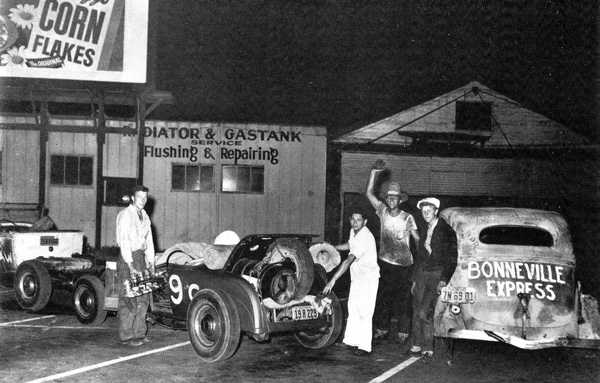 |
#1789 - "Many great racing
drivers and car builders began their competitive
wrenching and steering-wheel turning day as hot
rodders. Pay particular attention to the tall
cat-in-the-hat on the right with the big smile
and his hand in the air. Dirty T-shirt and ’34
Ford coupe notwithstanding, he’s none other than
the All American Racer Dan Gurney. From humble
beginnings comes great speed." From
ISKY: Ed Iskenderian and the History of Hot
Rodding, by Matt Stone. (Gurney Family
Archives)
|
|
a |
|
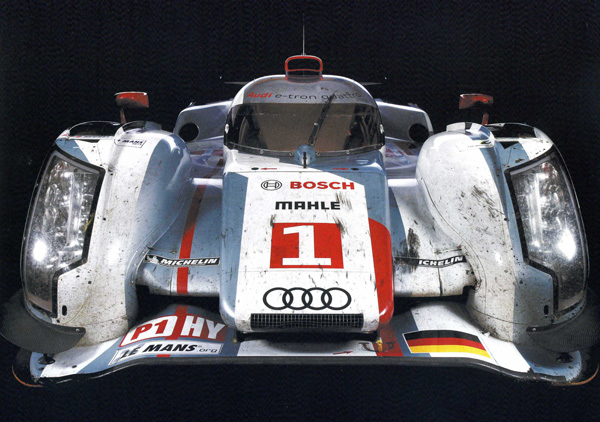 |
|
#1788 - Winner – Le Mans,
2011. Audi R18 carbon fiber monocoque. 3.7-liter
aluminum V-6, single turbo-charger, 540
horsepower. Twin front-mounted electric motors,
100 horsepower. From ART OF THE LE MANS RACE
CAR, by Stuart Coaling. (James Mann Photo) |
|
A |
|
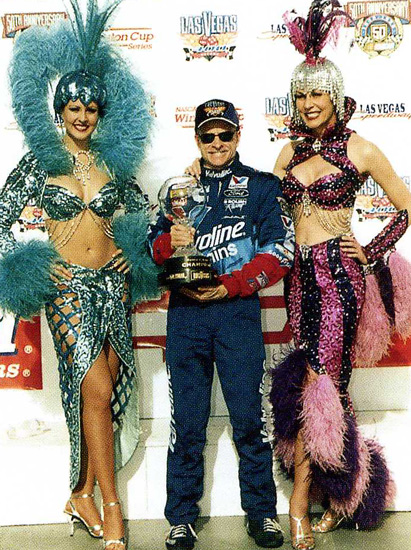 |
|
#1787 Mark Martin had his share of good
days in NASCAR, and unquestionably this was one
of them. On March 1, 1998, he took the inaugural
Winston Cup event at Las Vegas by motoring his
Taurus past Geoff Bodine with 23 laps remaining.
Awaiting in victory lane were three glitzy
trophies and $313,900. From NASCAR: The
Complete Story, by Greg Fielden. |
|
a |
|
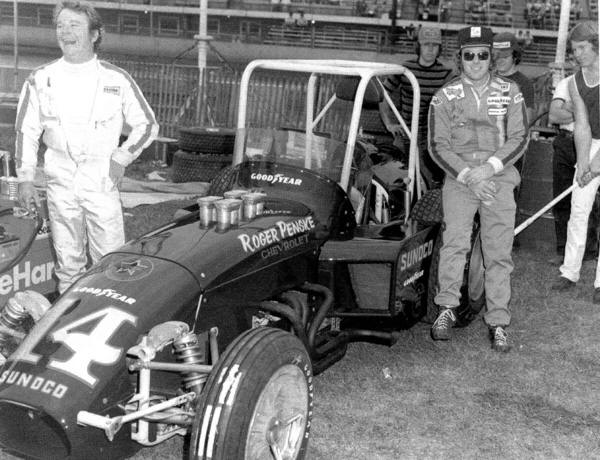 |
|
#1786 - "In 1973, Roger
Penske’s star driver was dirt expert Gary
Bettenhausen so he added an unconventional dirt
car with side-mounted radiators and independent
front suspension to the fleet. Jimmy Caruthers
(left) sure thinks it’s pretty funny. The next
year at Syracuse, Bettenhausen just about bought
the farm when this thing tried to jump over a
concession stand in turn two." Quote and Photo
from
COMPETITION PORTRAITS: The Dirt Championship
Cars, by Bob Mays.
(Armin Krueger Photo) |
|
a |
|
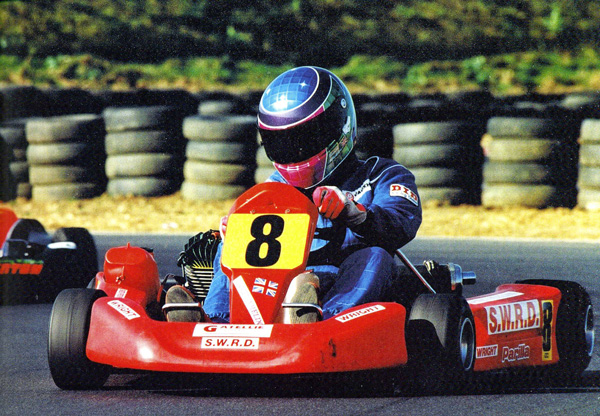 |
|
#1785 - There’s so much talk these
days about the haves and the haves not in
racing, but the disparity in competitors’
equipment is hardly just here and hardly just
new. Take for example this tale of the late Dan
Wheldon. By just eight years old Wheldon was
already an extraordinary Kart driver, and,
happily for him, his dad, Clive, was doing what
he had to do to “shoe the horse.” Clive recalls,
“We were just starting racing over in Europe,
and there was an English guy in charge of tires
at Bridgestone. If you weren’t well-known, you
got the crappy tires in the heats. Dan would be
right out front, leading, then all of a sudden
he’d drop back because the tires were going off.
The guy from Bridgestone came to me and said,
‘You’re in the plumbing game, aren’t you? I’d
like a bathroom.’ I said, ‘I’ll tell you what
I’d like…I’d like some of those tires.’ So, I
did a deal for the pre-final and final for
yellow spot tires. We put those on, and we’d
already qualified 10th or something, but all of
a sudden while we were near the back, they came
in. Dan came through the field, with some
unbelievable overtaking. Pantano was leading and
we passed him with five or six to go and won. It
was an absolutely amazing race to watch. In the
final, it was pretty close from the pole for the
first couple of laps, but then Dan started to
pull away from Pantano and won. My Bridgestone
guy came from South West England and I had to go
and do his bloody bathroom suite, and we got the
tires.” From
LIONHEART: Remembering Dan Wheldon, by
Andy Hallbery and Jeff Olson. |
|
A |
|
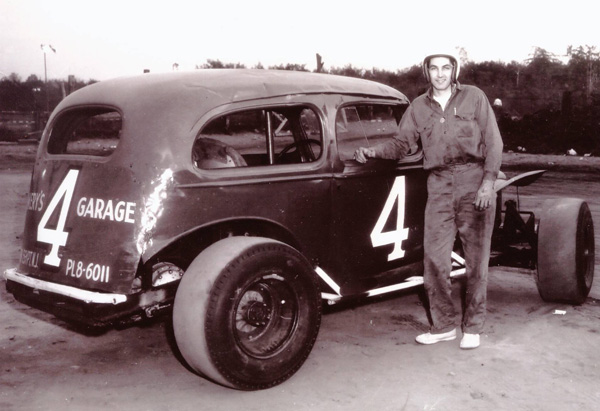 |
|
#1784 - "Though history will record
New Jersey’s Bob Rossell primarily as a disciple
of the church of the clay, he cut his teeth (and
his lip) on the pavement of Old Bridge
[Speedway.[ ‘What a place! ‘See this scar? I was
still learning and I snapped a radius rod and
drilled the fence right at the starter’s stand.
Along comes Danny Gallulo and bam! Got my lip
sewed up , but it seemed to happen again
whenever I was on the track with Danny. I had a
#4 up there in the sixties. It had a compression
leak I didn’t know about. In the heat, I threw a
radiator hose and smashed the boards. In the
feature, the same thing happened, and I went
backin’ on out right through the same hole’."
Quote and Photo from
PAVED TRACK, DIRT TRACK: Racing at Old Bridge
Stadium and Nazareth Raceway, by Lew
Boyd. (Ace Lane Photo) |
|
a |
|
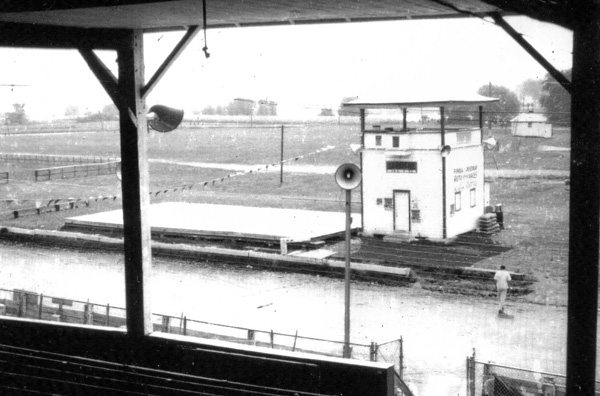 |
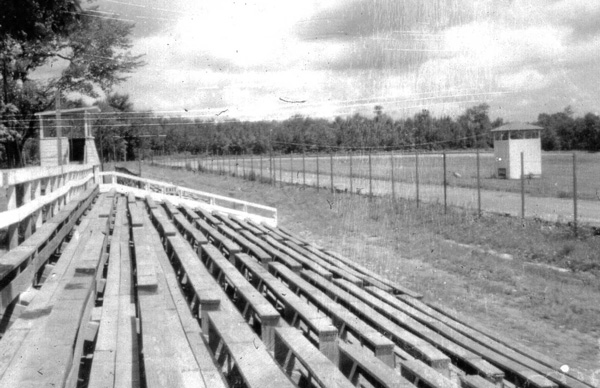 |
|
#1783 - Two more from Upstate New
York, among of the country’s most lively racing
areas in 1957. Six decades later, one track
motors on; the other is long gone. The top photo
is the Montgomery County Fairgrounds alongside
the Mohawk River, also known as Fonda Speedway.
The track opened with an early NASCAR sanction
under promoters Jim Gage and Ed Feuz in 1953 and
became an instant success. By 1955 it was known
as the Track of Champions and played to huge,
sellout crowds. Fueled by their good fortune,
Gage and Feuz decided to do it again. They built
the half-miler (lower image) in nearby Richfield
Springs for Sunday programs. It was very much in
the image of Fonda, as can be seen by the
comparable announcers’ towers built in the
infield next to the start finish line. The one
obvious difference is that there were no lights
at Richfield, and that is likely the reason it
lasted only one season. Few dirt tracks have
ever been able to survive with afternoon racing.
While Fonda at the time was known for its tacky,
racy surface, Richfield blew away in a cloud of
dust. (Coastal 181 Collection, photographer
unknown) |
|
a |
|
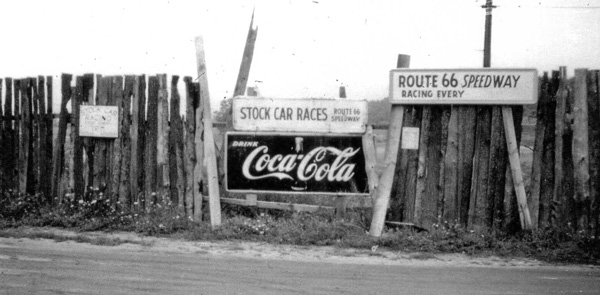 |
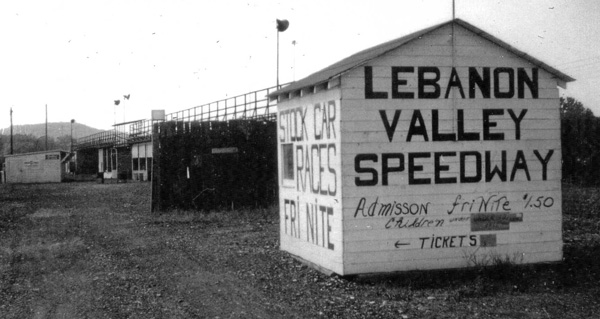 |
|
#1782 - According to Alan Brown’s
survey, over time, stunningly, New York state
has had 337 oval tracks, while by 2003 just 49
were operational. It’s interesting to postulate
why the 15% were successful. The two photos were
reportedly taken on August 9, 1957 at different
tracks near Albany. Route 66 (also known as
Hollywood Bowl) did not make it, but Lebanon
Valley still lights up big-time each weekend and
is nationally recognized. In any case, today’s
physical plants certainly convey a far less
primitive and gritty image than back in the day.
(Coastal 181 Collection, photographer unknown) |
|
A |
|
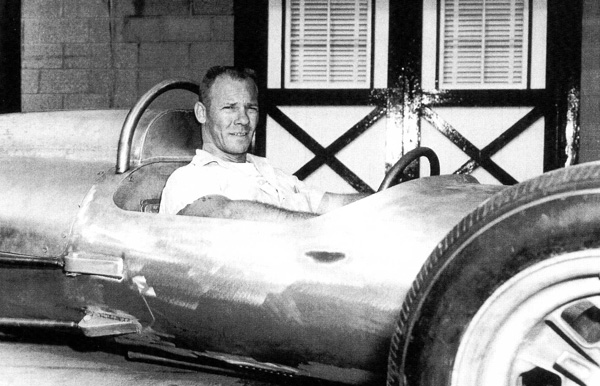 |
|
#1781 - Two weeks after a pleasing
sixth-place finish at Indy, Ronnie Duman’s wife
and children watched as he perished at the 1968
Rex Mays Classic in Milwaukee. “According to two
drivers, Wilbur (Bay) Darnell and Norman Brown,
this is the way it appeared to happen. Brown,
who was trapped in his car while flames roared
around him, apparently triggered the tragedy
when a part from his car had flown off causing
him to skid and ram the south wall. Duman
appeared to have struck Brown’s car and bounced
off the concrete retaining wall. One of Duman’s
tires sailed over the 12-foot wire fence into
the stands hitting a couple of fans. In all six
spectators were injured as nearly 40,000 fans
looked on in horror. Darnell’s car then skidded
into Brown’s car and also broke into flames.
‘Gas rolled into my cockpit,’ recalled Darnell
who was hospitalized with second- and
third-degree burns to the hands and knees, ‘and
I was all on fire.’ Duman’s car was the only one
not touched by the fire as the firefighters were
able to reach him before the flames. The
37-year-old was killed when his head struck the
wall when he overturned.” Quote and photo from
RACERS AT REST, by Buzz Rose, Joe
Heisler, Fred Chaparro, and Jeff Sharpe. (Sharpe
Collection Photo) |
|
a |
|
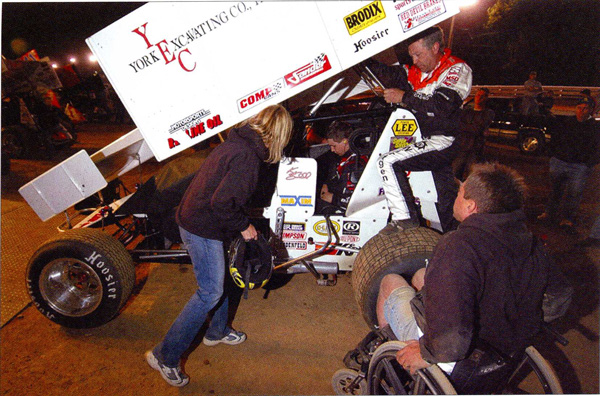 |
|
#1780 - Ten years ago…. The Family
Swindell at work. Kevin buckles up in Guy
Forbrook’s Sprinter, while Dad Sammy sets the
wing, and Mom Amy provides the head gear. From
SPRINT RACING 2006 (Paul Oxman
Calendar), Jack Kromer Photo. |
|
A |
|
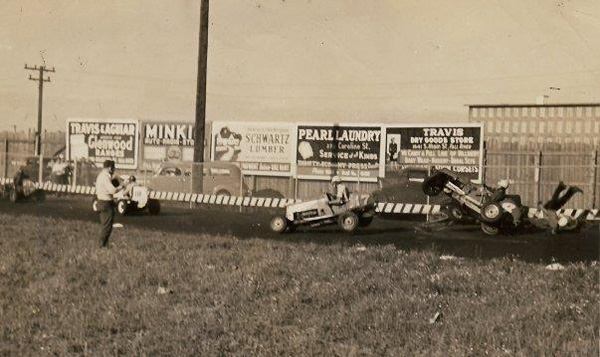 |
|
#1779 - Take a close look at this shot
taken at Tiverton, Rhode Island, on Sunday
afternoon, August 17, 1941. Pappy Hough won the
feature, but along the way the Midgeteers were
definitely playing hardball. That was Pete Dean
in the #17 and John Bogash in the #42. John
“Butch” Hoffman, who was taking his leave from
his car, likely needed more than a Band-Aid.
(Pete Zanardi Collection) |
|
a |
|
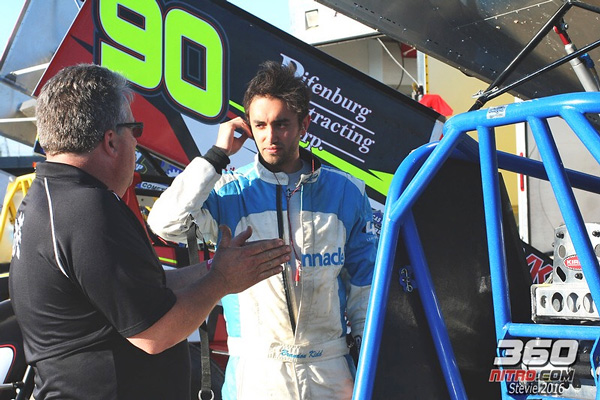 |
|
#1778 - Upstate New York’s Brandon
Kidd likes his challenges. The Syracuse
University grad jumped into Karts at 11, asphalt
and dirt Late Models at 16, did a stint in ARCA
with Bobby Gerhart Racing, and currently runs a
Sprinter with ESS. Here he confers with Doug
Emery, his “coach” and car owner. Brandon is
also an investment advisor with Pinnacle
Investments LLC. When he ends up conferring with
other racers during the week, “My advice to them
is hopefully they don’t throw all their money
into race cars and save a little for when they
hang up their helmets.” Tough call! (Kidd Family
Collection - Photo by Steve
Berthiaume at
360Nitro.com) |
|
a |
|
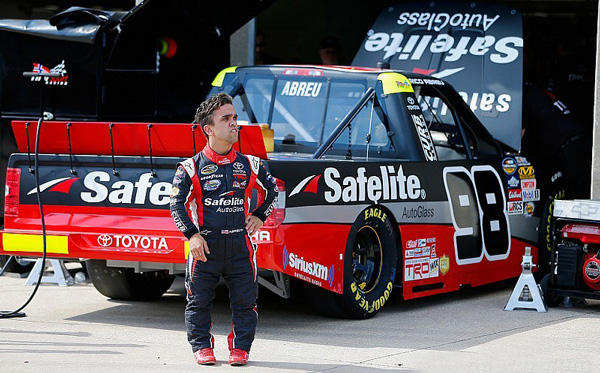 |
#1777 - Thankfully for the short
tracks, Rico Abreu is back from the
superspeedways full time for ’17. Here’s what he
had to say back in September of ’12: “Right now
I just want to keep racing. I want to run 90
shows a year and win a bunch of them. I do love
Sprint Cars, but I guess Indy Car racing and
Sprint Cup have to be a superior goal for any
racer. I’d like to get there, but I’d never
attempt to buy my way in. No way. And no way
would I want to be there just because I am a
little person. I would want to go in just like
Kyle Larson – because people could see I was
just that good.” Quote, as told to Coastal 181,
Photo
motorsport.com.
|
|
a |
|
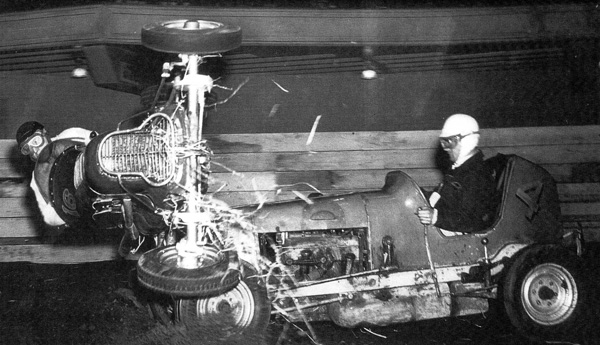 |
#1776 - The look of terror.
Joe Gersich hangs on for dear life, while Cal
Trottman grabs the binders at the Chicago
Amphitheatre in 1947. Indoor racing for Midgets
has continued for decades at many venues around
the country, none of which has been as
meteorically successful as the Chili Bowl, run
each January in Tulsa. From FEARLESS:
Dangerous Days in American Open Wheel Racing,
by Gene Crucean. (Ted Wilson Photo)
Answer to the question on yesterday’s Photo of
the Day: Jeff Gordon! From
Jeff Gordon: His Dream, Drive, and Destiny,
by Joe Garner. (Photo, Mary Ellen Matthews/NBC) |
|
A |
|
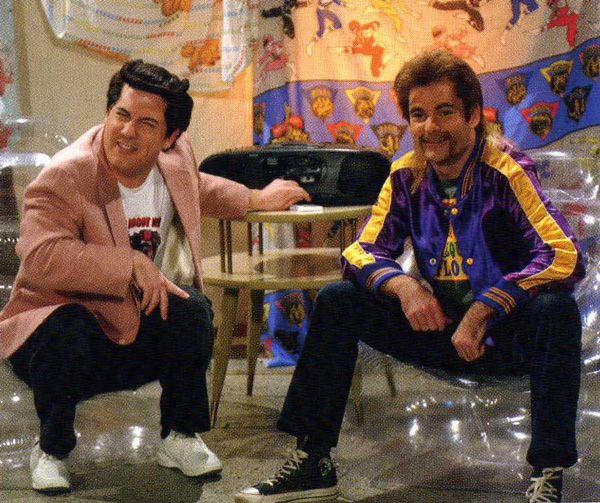 |
|
#1775 - Chris Parnell is on
the left at a skit on “Saturday Night Live” in
2003. Question for you: Who is the guy on the
right? Clue – he is visible more than ever today
on television. (Answer and photo credit in
tomorrow’s Photo of the Day.) |
|
A |
|
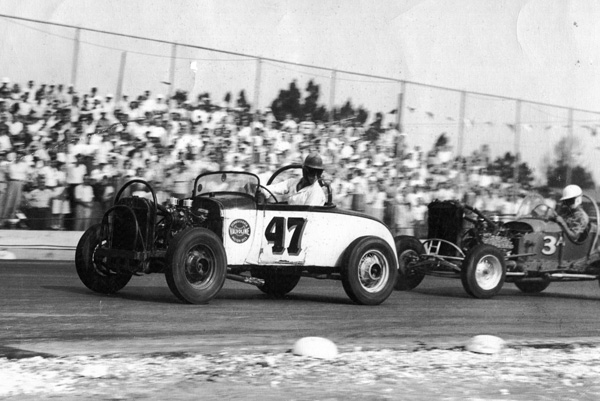 |
|
#1774 - In Photo
#1758 we ran a shot of Rags
Carter in an early roadster at Opa Locka
Optimist Speedway in Miami in the 1940s. Here’s
another of him down there, this time in a
spiffier #47 with Dur Howe in hot pursuit. In
the later ‘50s, Howe became one of the earliest
of the Miamians to wander north to the New
Jersey/PA area to seek the relatively fatter
purses in Modified racing. Carter would follow
in the ‘60s. We are currently finishing up a
book with Alan Carter Jr., JUST CALL ME RAGS.
(Carter Family Collection) |
|
A |
|
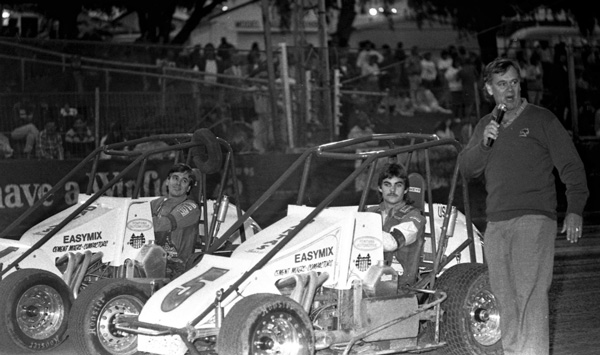 |
|
#1773 - It was December 1986, three
centuries ago in racing time. Two most different
personalities, Jeff Gordon (#5) and Kevin Olson
– the American team, lined up to take on the
Aussies in Perth, Australia. It was quite a trip
to say the least. If you’re up for a belly
laugh, you can read all about it and other
adventures in KO’s book, CAGES ARE FOR
MONKEYS. For a completely different view on
life, you could pick up another very popular
title this year,
JEFF GORDON: His Dream, Drive, and Destiny.
Photo from
CAGES ARE FOR MONKEYS: Unleashed with Kevin
Olson, Racing’s Zaniest Hall of Famer,
by Kevin Olson and Lew Boyd. (Peter Roebuck
Photo, Anthony Loxley Collection) |
|
a |
|
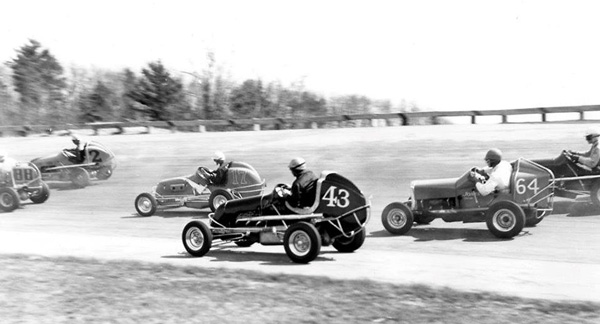 |
|
#1772 - Racing journalist Pete Zanardi
sent along this neat shot of the Midgets on the
5/8 oval in Thompson, CT, known as "the Ascot of
the East" back in1947. The drivers were Billy
Tibbert in the #2, Joe Sostilio in the Koopman
#17, Sammy Bruno in the Palliano Undertaker
Special #43, and Dynamite Duggan in the #64.
Their chairs were so upright that they looked
seated near Heaven and just didn't look that
fast. Most of them were not even running up in
the momentum groove. However, racing historian
R.A. Silvia says that right around this time
they were clocked down the backstretch at
117mph. Yikes. (Pete Zanardi Collection) |
|
A |
|
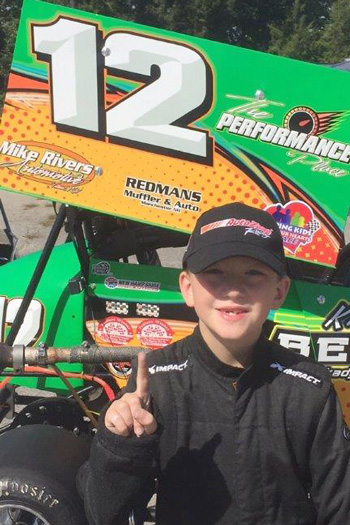 |
|
#1771 - Keep an eye on this
kid from Goffstown, New Hampshire. At age nine,
Kadyn Berry’s first year at Rt. 106 Racepark, in
Sprint Karts he was 2016 overall points champ,
rookie of the year, car show winner, and most
popular driver. It's gotta be those genes again.
He is a FIFTH generation racer. (Berry Family
Collection) |
|
A |
|
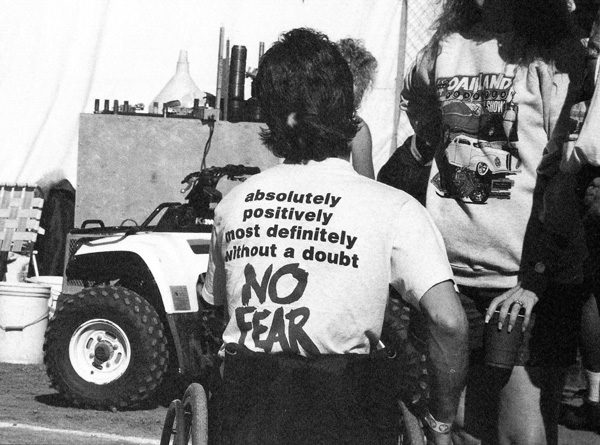 |
|
#1770 - This shot was taken
in the pits of Ventura, CA, in the 1990s.
Wouldn’t you like to know the story behind it?
From
THUNDER ROAD: A Photographic Journey of Open
Wheel Racing, Carnivals, and the Iconic Highways
They Travel, Circa 1990s, by Tom Loutz
(Tom Loutz Photo) |
|
A |
|
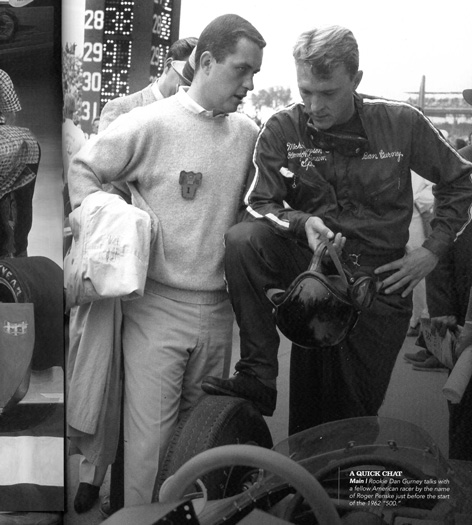 |
|
#1769 - Dan Gurney, an Indy
500 rookie, is about to don his helmet for the
start of the 1962 running. He listens to another
emerging American racer, Roger Penske. Even that
early in their meteoric careers, neither of the
two had the look of a strong-armed dirt tracker
from the fair circuit. (Photo from INDY 500
OFFICIAL PROGRAM, May 29, 2016) |
|
A |
|
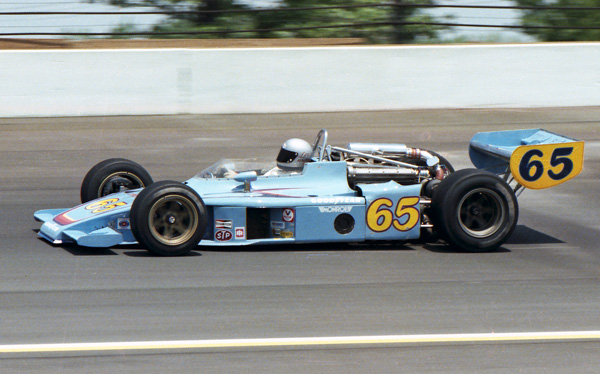 |
|
#1768 - "Lee Kunzman is one of Indy’s 'what
if' stories. What if he hadn’t had to sit out a
year, healing from injuries, after a violent
1970 Sprint Car wreck in
Missouri? He’d passed
his
Indianapolis rookie test;
team owners were interested. And what if he
hadn’t had a second savage crash in ’73, in an
Indy Car at
Ontario, after cementing
his comeback with nine top-ten finishes? Lee’s
fine 500 record includes two seventh place runs
(1973, ’77) in four 500 starts." Quote from
THE STINGER: 273 Drivers Speeding Toward Hope,
by Bones Bourcier
and John Andretti (John
Mahoney Photo) |
|
a |
|
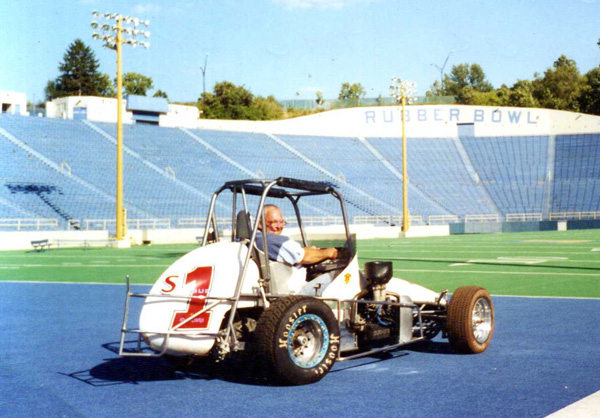 |
|
#1767 - Here’s the
stadium used by the University of Akron’s
football team. It didn’t always look quite like
this. From the Great Depression through the
1950s, it was the site of the Akron Rubber Bowl,
a gritty – and frightful – oval famous for wild
open-wheel racing. It still has its loyal motor
head devotees, such as our not-to-be-named
friend pictured above with his Midget. “I can
say for certain I was the last race car driver
to drive there. I unloaded, tore up some turf,
and left before the cops came.” (Coastal 181
Collection) |
|
a |
|
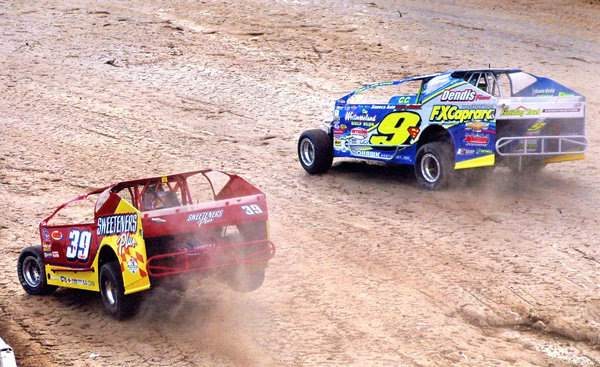 |
|
#1766 - Photographer Chris
Burgess had quite a vantage point way up over
the stands for Super DIRT Week last fall. The
dirt-over-pavement at Oswego Speedway was pretty
racy until if began breaking up. This image
shows Timmy McCreadie and Matt Sheppard dueling
for the lead. Note that emerging hole in the
lower right, exposing some asphalt. Then note
Timmy’s right rear. Not the right look for a
DIRT mod entering a turn! Lots of equipment and
hearts were broken, but the fans were there, and
officials contemplate a much more ergonomic
surface in ’17. (Chris Burgess Photo) |
|
A |
|
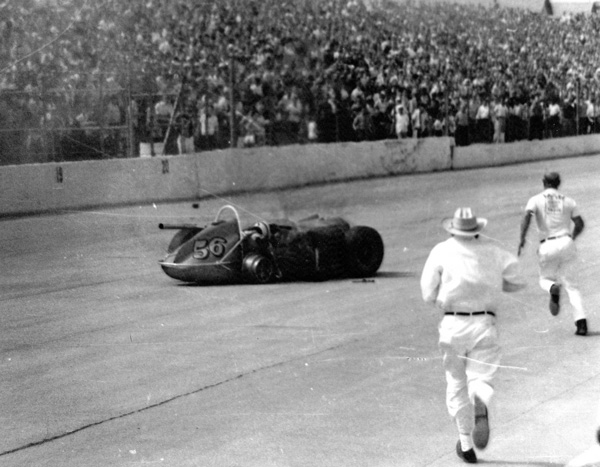 |
|
#1765 - Indy 1964 was sad enough
before this famously painful scene the following
week at
Milwaukee. Coming out of
four, Roger Ward, Jim Hurtubise, and A.J. Foyt
were running one-two-three in strict formation.
Suddenly a bearing in Ward’s rear end spun. He
threw his hand in the air, but slowed so
quickly, there was no way to avoid contact. Both
Foyt and Herk jumped on the binders, but they
touched and Herk headed for the wall. His right
rear tire came off and hit him on the chest,
breaking ribs and puncturing a lung, and
knocking Herk out. But the horrible part was
when the front axle pushed back and the crushing
metal caused so much pressure inside the fuel
tank that it popped the filler cap off. Methanol
spewed into the driver’s compartment. Buster
Warke, in the hat, was one of the first on the
scene. Herk would live, and every race fan in
the world knows how his Olympian determination
to race again eventually outpaced his suffering.
(Cal Lane Collection) |
|
A |
|
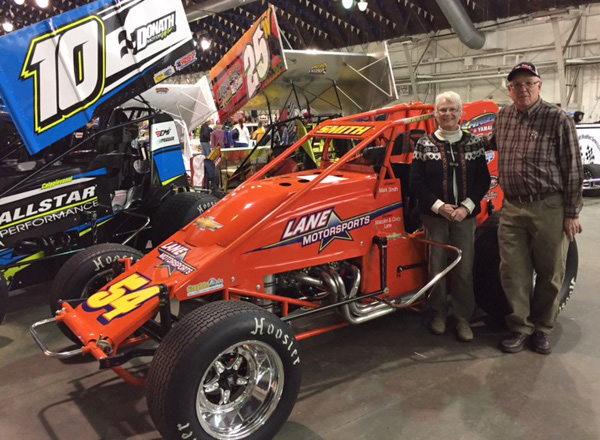 |
#1764 - A very competent
former Sprint Car driver himself, Mal Lane of
Dundee, NY, here with his wife Cindy at last
weekend's Gater Motorsports Expo at the Syracuse
Fairgrounds, seemed to be bitten again with the
racing bug. Here is a drop-dead beautiful Silver
Crown car he's just put together – 1396 pounds
of fun delivered by a 775hp 356. He's also now
got a bad case of spring fever. A thousand
people asked when he and Mark Smith, the
Pennsylvanian wheelman, would be debuting the
Maxim. They just can't wait for April 2 and the
Sumar Classic at Terre Haute. (Coastal 181
Photo)
|
|
A |
|
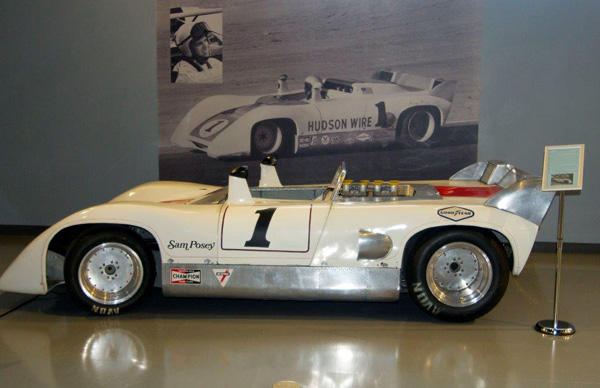 |
|
#1763 - This
image was taken in 1968 at Ray Caldwell's shop
in
Massachusetts. Two
nearly identical Can-Am Series road racing cars
were built in New England,
and this one is the lone survivor. It was
designed for and driven by New England's own
racing and TV star, Sam Posey, and now sits in
the North
East
Motor
Sports
Museum
in
Loudon, NH.
(www.nemsmuseum.com).
The Museum will be opening in July, but a gala
event will be taking place in just over three
weeks.
On Saturday April 8th, from 1:00 pm to 5:00 pm
at Midway Buick/GMC located at 155 Rte. 108
Somersworth, NH, there will be a "Casino Museum"
event that will include blackjack tables, a
money wheel, Let it Ride, and Texas Holdem
Poker, along with other games. Midway is
owned by Bob Demers, a highly respected SCCA
road racer and instructor and a Museum devotee.
There will be prizes of all types, ranging from
race car equipment to restaurant gift
certificates and even a chance to become a
member of a pit crew for a night. In addition,
the museum will be giving away memberships,
books from Coastal 181 and access to many
upcoming racing events.
Also taking place on the same day, SCCA racers
will be bringing their cars to the dealership
for pre-season inspection and will have racecars
on display along with driver meet and greets.
The
North
East
Motor
Sports
Museum is located next to
the south entrance of New Hampshire Motor
Speedway and will be the only museum of its type
in the Northeast. The grand opening is slated to
take place in July during the NASCAR race
weekend. (Photo, Dick Berggren,
North
East
Motor Sports
Museum)
|
|
|
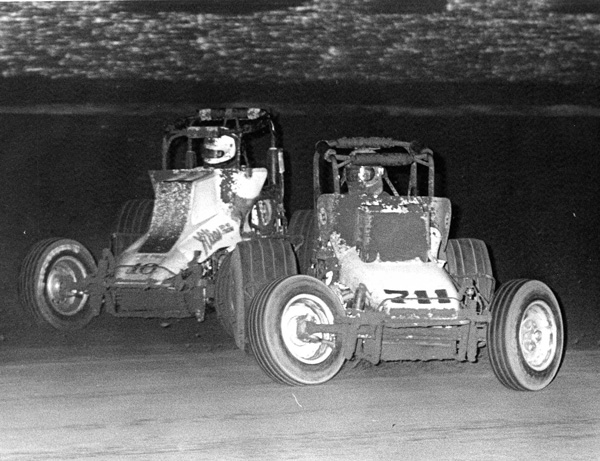 |
|
#1762 - It would be so
easy to become totally retrospective about
racing, especially when you get to thinking
about CRA out there at Ascot. Bob East in the
#10 and Clark Templeman in the #711 show why.
(Barbara Jo Garson Photo, Coastal 181
Collection) |
|
A |
|
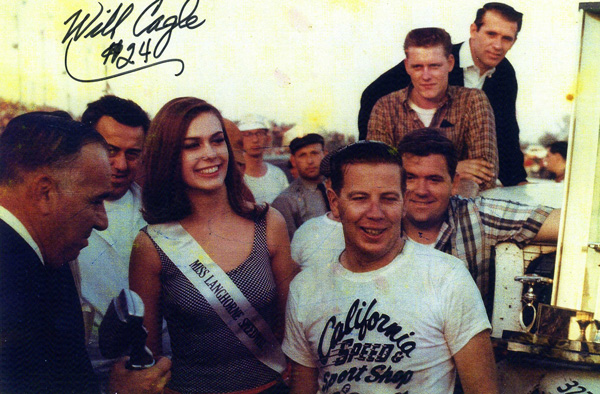 |
#1761 - In 1966 Will
Cagle was on his way from being “The Tampa
Terror” to becoming “Wily Will.” He shocked them
all at Langhorne. Even though the grand circle
was then paved, Will showed up with his dirt
car. It was outfitted with different springs and
shocks and shoed with some special rubber from
Marvin Rifchin of M & H Tire. Upfront was a 402
small block assembled by Buzzie Reutimann – and
upfront is just where Cagle finished. (Cagle
Family Collection)
|
|
A |
|
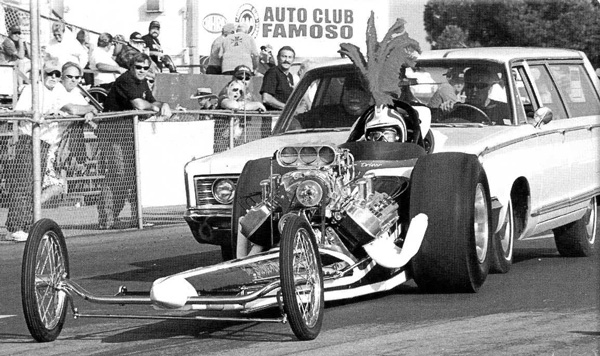 |
|
#1760 - “For George
‘Hutch’ Hutchenson, The Stone Age Man wasn’t
just a name on one of the 1960s most beautiful
dragsters but it was a whole persona. George had
a vivid dream in 1968, one in which he saw a
helmet, similar in style to that which a Roman
centurion would have worn, and affixed to the
helmet were 24 red plumes. Over the next couple
of weeks, George went to work building the
helmet, which became part of the Stone Age Man
persona. Thereafter, not a pass was made without
the helmet.” Quote and photo from
1001 DRAG RACING FACTS, by Doug Boyce,
(Dave Davis Collection) |
|
a |
|
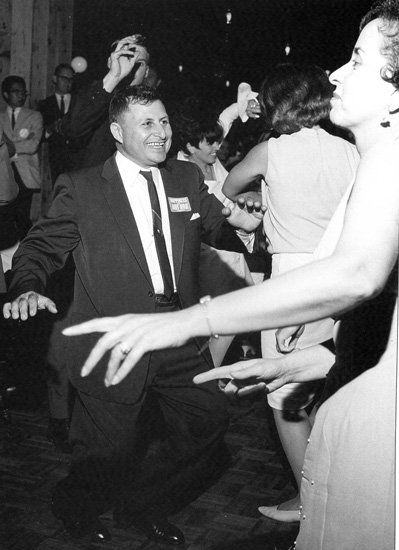 |
|
#1759 - SEMA president Ed Iskenderian
having fun at an early show banquet, cutting a
rug with his wife, Alice. “Previous to this, Ed
didn’t know how to dance and didn’t want to look
stupid if he ever got hauled onto a dance floor,
so he bit the macho bullet and took dancing
lessons.” Quote and photo from
ISKY: Ed Iskenderian and the History of Hot
Rodding, by Matt Stone. (Photo Courtesy
of TEN: The Enthusiast Network Archive) |
|
a |
|
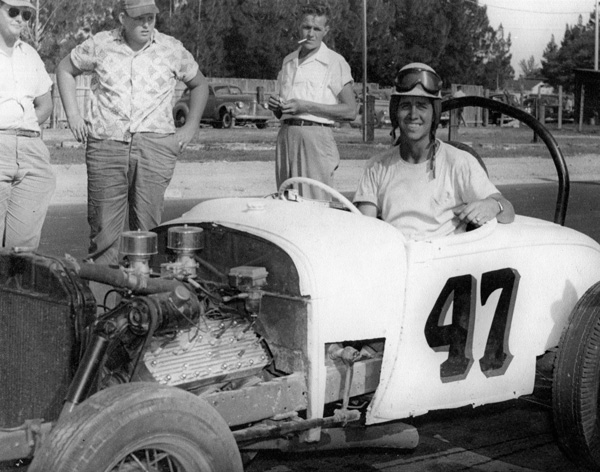 |
|
#1758 - That’s the late Alan “Rags”
Carter at the Opa-Locka Optimist Speedway just
North of Miami in the late 1940s. Rags had just
been driving for a year or so, but was already a
top dog at the funky third-mile track that
straddled on top of both an airport and a
baseball field. It was half paved, half dirt. On
Wednesdays they ran jalopies and on Friday
roadsters. Rags’ very first ride had been when a
driver didn’t show up for a roadster race.
Apparently, the guy had gotten cold feet.
Looking at Rags’ car, it’s hardly a wonder why.
(Alan Carter Jr. Collection) |
|
a |
|
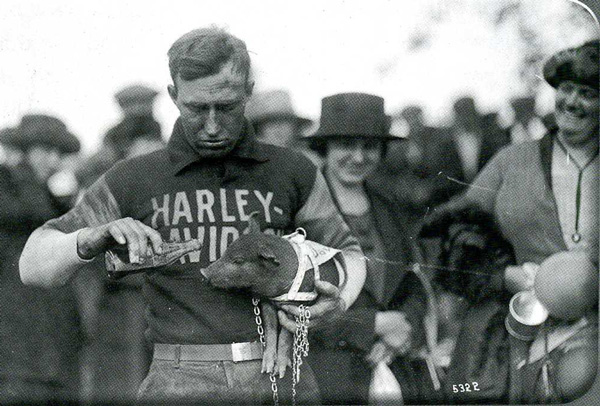 |
|
#1757 - "Although its origin is from
racing, the term Hog has become synonymous with
the Harley-Davidson motorcycle as well as the
Hartley Owners Group (H.O.G.) and the New York
Stock Exchange ticker symbol. The name was first
used in 1920 when the H-D factory team became
known as the Hog Boys. It wasn’t just their
farming background that garnered the nickname;
they actually brought live pigs to the events as
their mascot. After each of their frequent
victories, the winning rider put the hog on his
bike and took a victory lap." Quote and Photo
from
1001 HARLEY-DAVIDSON FACTS, by Tyler
Greenblatt. (Photo Courtesy of Harley-Davidson) |
|
A |
|
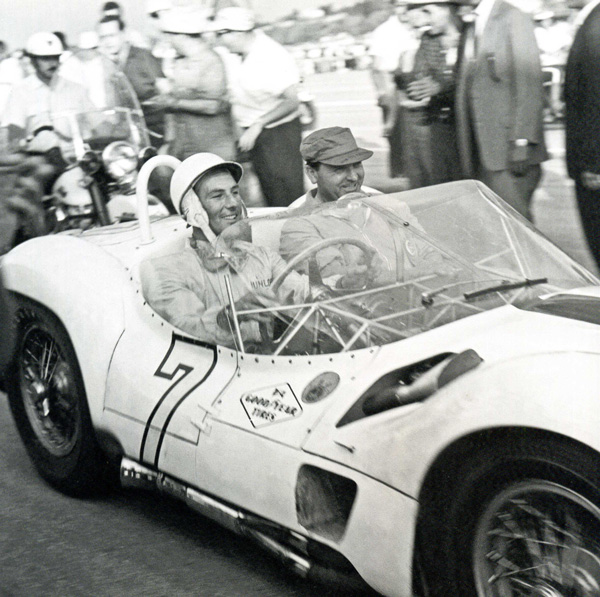 |
|
#1756 - Is this cool or what? A
jubilant Stirling Moss has just won the 1960
Grand Prix, and he takes Maserati Team chief
mechanic Guerino Bertocchi for a victory spin.
The location – Havana, Cuba. The event was
promoted by West Palm Beach’s Ken Coleman under
the close watch of Fidel Castro. From the just
released
CUBA’S CAR CULTURE: Celebrating the Island’s
Automotive Love Affair, by Tom Cotter
and Bill Warner (Bill Warner Collection) |
|
z |
|
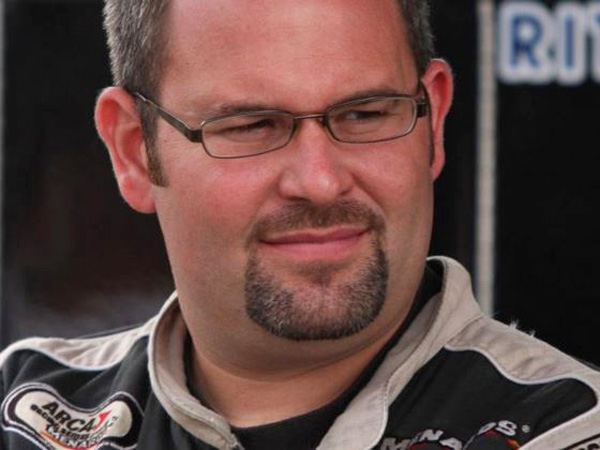 |
|
#1755 - This Photo of the Day and its
caption comes to us from our associate Joyce
Standridge. "Those reminders that we're not
playing with tinker toys are tough to take. When
the word filtered back that one of the three
pitsiders injured when Dale Blaney's sprint car
penetrated the fence at Volusia during Speed
Weeks was Kelly Kovski, a lot of Midwestern
racers were shocked. Some people know him from
his ARCA and late model driving and a lot more
from his long-term tenure at Hoosier Tire
Midwest. There aren't many in the business who
are more likable. Among Kelly's multiple serious
injuries are broken vertebrae, ribs and ruptured
spleen. More than two weeks after the wreck,
medical staff have not been successful in
removing him from the ventilator. It's going to
be a long, long recovery. A substantial group of
fans and friends have put together a benefit
auction for Kelly, his wife Amanda and their two
little girls, scheduled for April 2nd in
Springfield, Illinois. Racing folks are at their
best when a racer is at his lowest. Donations,
whether auction items or financial gifts, are
still being welcomed by Hoosier Tire Midwest
General Manager Terry Young. You can reach him
at
hoosieris1@aol.com. |
|
a |
|
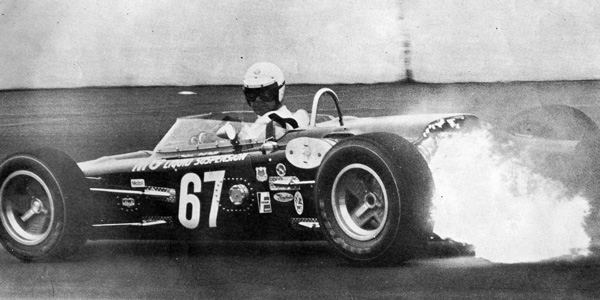 |
|
#1754 - Looking back at Indy. It was a
practice run in May 1966, and driver Bob Veith
could see things weren’t so cool. He slowed way
down, allowing the flames to fan away from the
cockpit. The fire trucks caught up with him, and
the fire was extinguished before the car even
stopped. (Illustrated Speedway News Collection,
Walter Chernokal Photo) |
|
a |
|
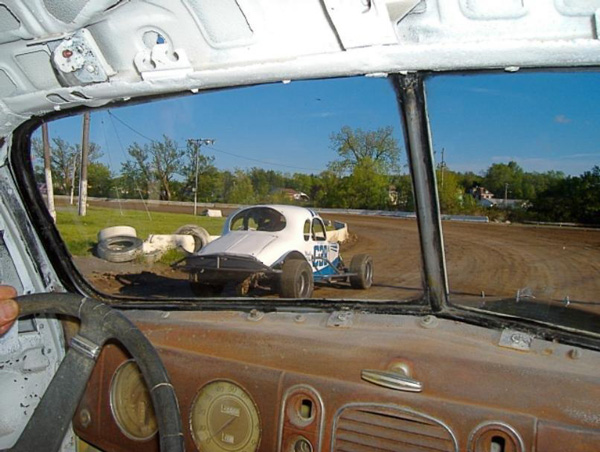 |
|
#1753 - Absence makes the
heart grow
Fonda. (Photo Mid State Stock Car
Association Collection) |
|
A |
|
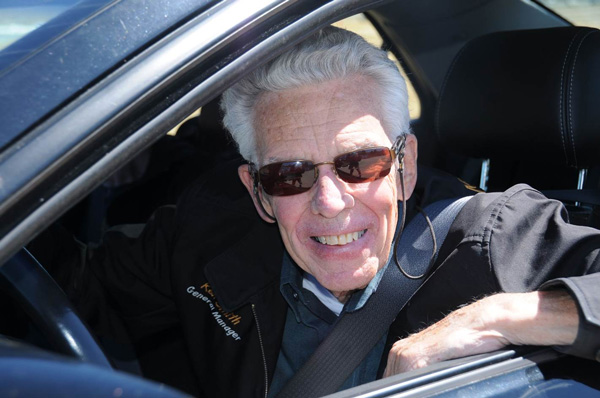 |
|
#1752 - The entirety of the
Supermodified community mourns the loss of good
guy Kendall Smith. A graduate of Bentley College
and long-time President/CEO of Pentucket Bank in
Haverhill, MA, Ken was highly honored for his
success in business and his participation in
local charities and community organizations.
But, the image of energy, he always was on the
go, doing things his own way. Case in point was
the remarkable co-founding and nurturing of the
New England SuperModified Racing Association
(NESMRA) and promotion of over 1,000 shows with
his partners Charlie Elliott and Russ Conway.
For people who really knew him, there was little
surprise when he showed up looking dutifully
like a banker with his black Caddy. It just
happened to have flames painted on the front
quarters. (Coastal 181 Collection) |
|
a |
|
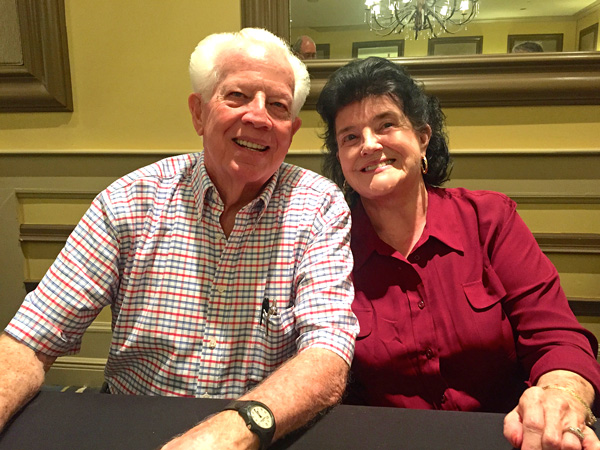 |
|
#1751 - It always seems that Will and
Barbara Cagle are together. Here they are at an
autograph table at the Living Legends of Auto
Racing auction night last week in Daytona Beach.
Asked about their close relationship, Barbara
smiles and says that it has been over 60 years –
and she tells a story from the fifties. Back at
Plant Field in Florida, Will was hustling
towards the front of the field in a black #24 as
he always did, while Jimmy Riddle kept jumping
the flag on restarts. The starter got irritated
and threw the black flag – for Will by mistake.
Will motored back to the pits, totally incensed.
After the race, the starter came over to discuss
the incident and, in Barbara’s words, “Will
socked him.” Down he went. And when a
reinforcement officer rushed over, he went down,
too. But soon the two were back on their feet,
starting to pound on Will, so Barbara jumped on
one of their backs. That move was to no avail,
so she grabbed one of their guns and, pointing
it enthusiastically, told them to lay off her
Will. At this point the fans had taken notice
and were applauding loudly. Barbara handed to
gun to one of them, and it was handed over row
to row, all the way to the top of the
grandstands, where it was tossed away. Needless
to say, there were legal repercussions, but
Barbara says there was no record since she and
Will were under 21. Just then at the Living
Legends table Billy, the Cagle’s quite normal
looking son appeared. Asked whether this story
could possibly be true, he just shook his head,
smiled, and said “absolutely.” (Photo by Dick
Berggren) |
|
a |
|
.jpg) |
|
#1750 - That Seymour Family of
Marlborough, MA, sure has its mark on open-wheel
history. The late family patriarch, "Boston
Louie" Seymour, was said to have towed a million
miles with his Sprinter and Silver Crown rides
for over 50 of the country's finest wheelmen.
His sons, Bobby and Mike, both formerly
top-shelf drivers themselves, continue the
racing tradition with their speed-part
activities. Now their nephew, Ben Mikitarian,
has jumped in the seat and sure is getting it
done. He's shown here, age 15, at New
Hampshire's Star Speedway on his way to winning
Lite Rookie of the Year in the NEMA Lites. He
looked really good on the ultra-fast banks of
the 5/8-mile Thompson (CT) Speedway in NEMA's
final race of the year. His mom, Celeste, said
that she was one proud mama, but could only
watch with one eye. (Mikitarian Family
Collection) |
|
a |
|
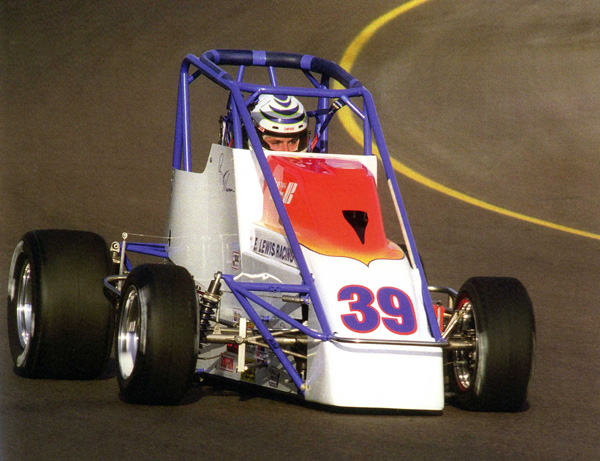 |
|
#1749 - It’s about the eyes.
(Ryan Newman going very fast at Phoenix in
2000). Photo from UNITED STATES AUTO CLUB –
Fifty Years of Speed and Glory, by Dick Wallen
(Mike Arthur Photo) |
|
a |
|
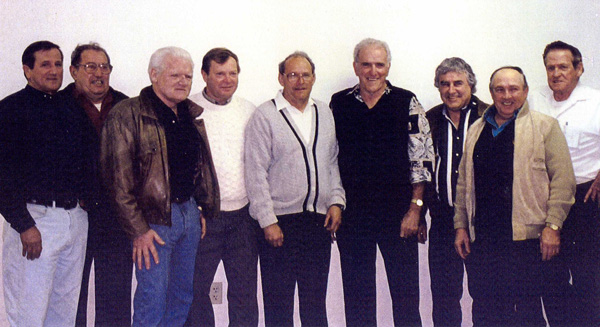 |
|
#1748 - What a time for racing the
1970s turned out to be. There was the nationwide
rollout of NASCAR superspeedways; the launch of
the World of Outlaws at Devil’s Bowl in
Mesquite, TX; the glory days of the Modifieds in
the Northeast – and on and on. This gaggle of
Modified masters sure could pound the pavement.
L-R, Jerry Dostie, Freddy Schultz, Dick
Armstrong, Bugsy Stevens, Bob Judkins, Leo
Cleary, Ted Marsh, Billy Harman, and Bill
Slater. (Coastal 181 Collection) |
|
A |
|
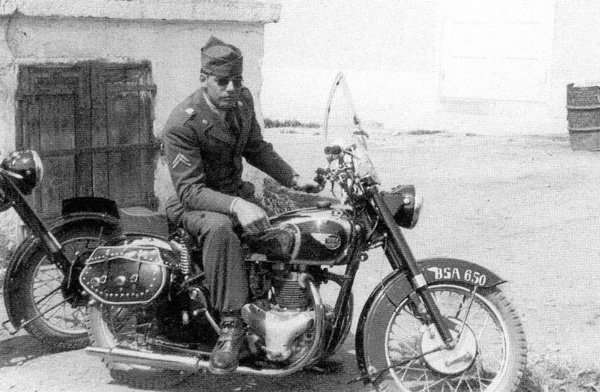 |
|
#1747 - Even back during World War
II, Ollie Silva had that look. His physique, his
chiseled good looks, and surely those sunglasses
predicted the dashing image he would convey for
three decades as one of the country’s top open
competition open-wheelers. It’s curious though,
how looks can deceive. In actuality, Ollie was
quiet, private, and unassuming. He once said
that all he needed in life was a good road car
to drive and some decent threads. (Russ Conway
Collection) |
|
a |
|
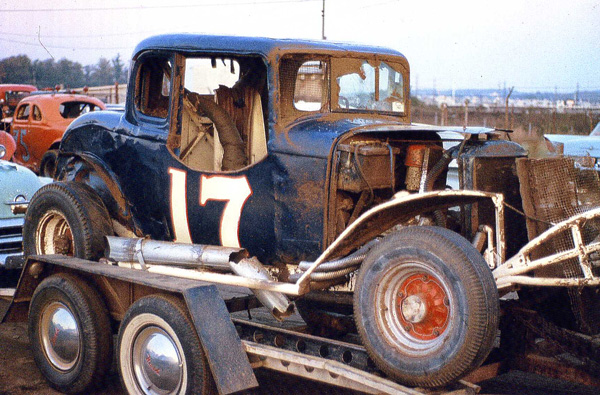 |
|
#1746 - Jim Donnelly, Senior Editor at
Hemmings and author of our Miller’s Time on Don
Miller, is working on a book about the Tobias
family for us. What a story they are! They have
dedicated so much to racing for so very long.
Here’s a way cool square top Toby showed up with
right at the beginning. How about that
windshield and the seat brace – and that exhaust
system! (Flex pipe never did work). (Coastal 181
Collection) |
|
A |
|
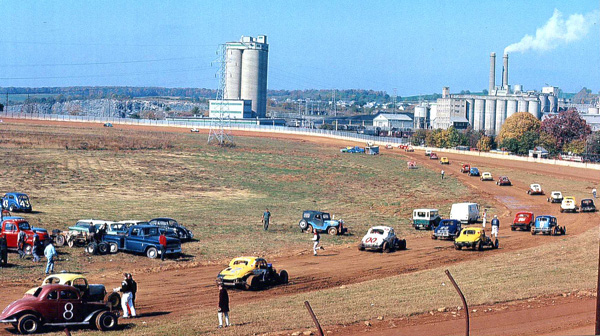 |
#1745 - It seemed highly
unlikely when in 1952 a dance and ballroom
operator from the Bronx moved to cement-dusted
Nazareth, PA, to run the half-mile race track at
the Fairgrounds. Jerry Fried demonstrated
incredible tenaciousness in guiding the facility
through good seasons and bad over the next three
decades. He had one especially lofty dream – to
be a key figure in what he felt would be an
explosion in the popularity of racing, “the
sport of the seventies.” He built the enormous 1
1/8th-mile track next to the half-mile,
intending over time to light it for night racing
– and even to cover it with a dome. There was
some amazing Modified and Sprint Car racing in
which most of the entries were going far faster
than their design speed. For whatever reasons,
though, he could not ride that wave of
superspeedways and television that so enriched
NASCAR. The big track closed first, and, just 11
months after he was forced to shutter the
half-mile, he quietly passed away. (Coastal 181
Collection)
|
|
A |
|
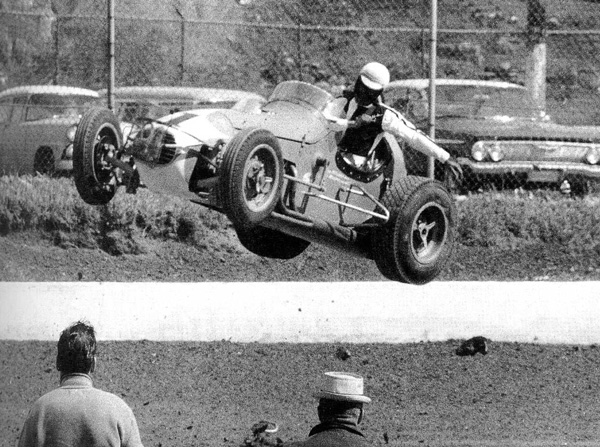 |
#1744 - It was not a good
situation at all for Roger McCluskey. He arrived
at Reading, PA, on March 29, 1964, as the
defending USAC champion and had not anticipated
departing in an ambulance. He pitched Wally
Meskowski’s Sprinter just past the starting
line, having qualified right up front, hit a rut
between one and two, and things got out of hand.
He ended up with two broken arms. It took a
while to recover, but he was up for hugging one
of J.C. Agajanian’s trophy girls in victory lane
at Ascot that fall. From
UNITED STATES AUTO CLUB – Fifty Years of Speed
and Glory, by Dick Wallen (Walter
Chernonakal Photo)
|
|
a |
|
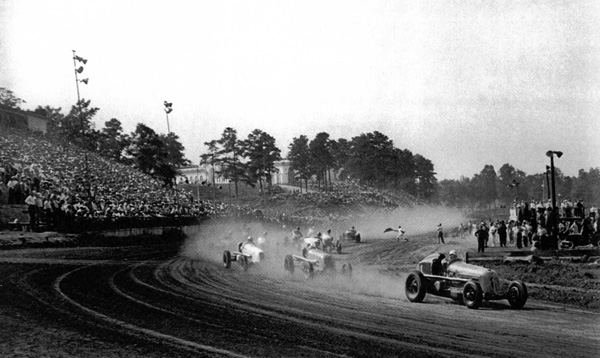 |
|
#1743 - It was a beautiful thing on
Labor Day of 1946 when Ted Horn roared into the
first turn at the one-mile Lakewood Park track,
leading the field into a 100-miler. Entering the
third turn on lap 98, however, things went
terribly wrong before the shocked crowd of
38,500. George Robson, Indy 500 winner that
year, was blinded by worsening red dust
conditions and rammed into a lapped car; a huge
wreck ensued, consuming all but three cars. The
race was cancelled immediately with Horn
declared winner. George Robson and George
Barringer were the clear losers, both fatally
injured. From
Racers at Rest, by Buzz Rose. (Jeff
Sharpe Collection) |
|
a |
|
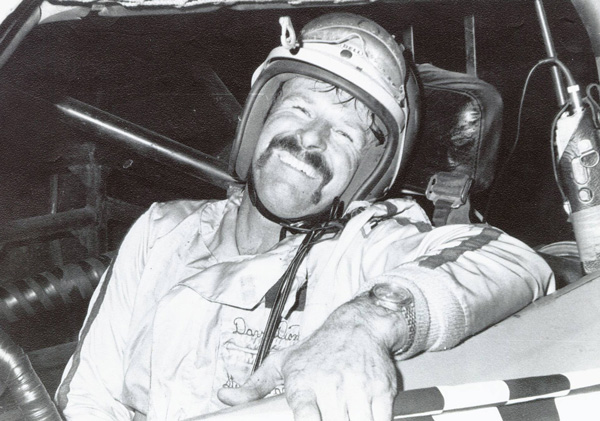 |
|
#1742 - If you’re headed to
Speedweeks next week, you’ve just got to stop in
on this one. It’s a function put on at the
Living Legends of Auto Racing Museum (Sunshine
Park Mall, 2400 S Ridgewood Ave, #36) in South
Daytona on Thursday (the 23d) from 10 to 2.
Known as “Coffee with Characters,” it’s all
about old-time racing storytelling – and the
last couple of years have brought some
incredible tales. Much of that is because of the
host, “Dynamite Dave” Dion. The photo above is
from a book on Dion we did with Dave Moody some
years back called
LIFE WIDE OPEN. The caption is: “I may
look ecstatic after winning the ’75 Oxford 250,
but don’t believe it. The truth is, I’m in pain!
My leg cramped up from the heat, and I couldn’t
straighten it to get out of the car.” It’s
always sumthin’ with Dave. He’s the biggest
character of all. For more info on the event,
ring Dave’s chimes at 603-320-3095. Bill Balser
photo from
LIFE WIDE OPEN, by Dave Dion with Dave
Moody. |
|
A |
|
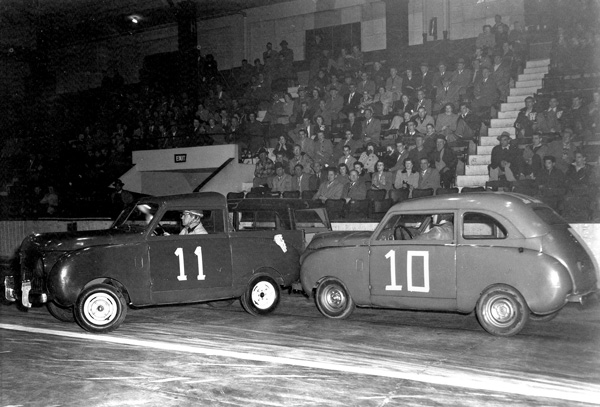 |
|
#1741 - In New England in February a
young man’s heart turns…..INDOORS. So, here we
are again at the turn of the ‘50s at Rhode
Island Auditorium. The show was Crosley city,
presenting all flavors – a passenger car, a
pickup, and a wagon. The bespectacled guy in the
pickup, Ray Hill, was an exceptionally brave –
star-crossed – racer. During the war, he was
given a 4F for diabetes, and by this time,
winter of ’52-53, his health was deteriorating.
Perhaps that’s why he opted to go to the
sprawling Thompson, CT, oval the next fall in a
car unsuited for the high speed. He crashed and
– most dramatically – flew out of the car and
perished. Another photo from R.A. Silvia’s
fabulous files. |
|
a |
|
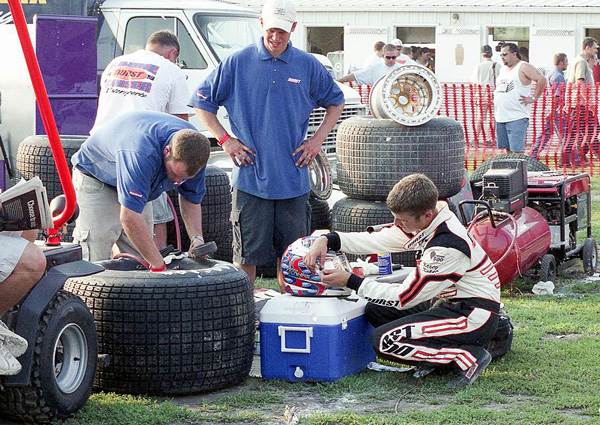 |
|
#1740 - Like most of us from snowy New
England yesterday, our friend John DaDalt was
busy digging through piles - in his case very
cool racing photos he has taken over the years.
Here's one from Iowa in 2001.
Twenty-one-year-old Kasey Kahne was seeking a
win in the Knoxville Nationals, but, alas, it
was not to happen. Dover, Missouri's
fast-talkin', fast drivin' Danny Lasoski, twice
his age, snatched the pole and went wire-to-wire
in the 30-lap main. Kasey did not make the show.
(John DaDalt Photo) |
|
Z |
|
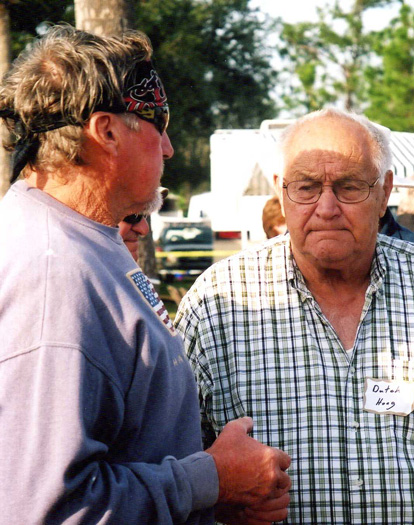 |
|
#1739 - This shot was taken a while
back at the fabulous Modified Reunion held each
year at New Smyrna during Speedweeks. The late
Dutch Hoag, right, was concerned about the knee
replacement he faced the following week. Bentley
Warren had just been through the procedure and
was assuring Dutch that was no problem. “Gosh,”
he said. I was chasin’ the nurses down the hall
in half an hour.” Dutch didn’t look that
convinced. (Coastal 181 Collection) |
|
A |
|
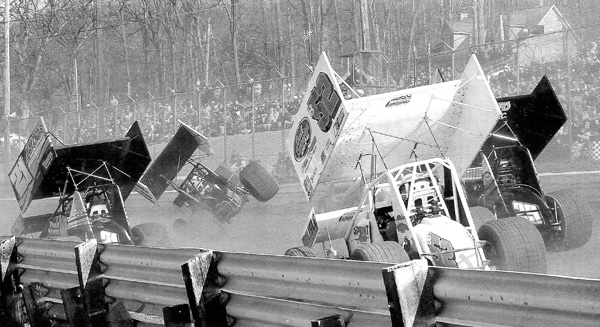 |
|
#1738 - Every rookie driver
has heard a gray beard say it: “Always focus on
three cars ahead of you.” Here’s why. Suddenly,
coming down for the green at the Lincoln, PA,
opener three winters past, Derek Sell’s #20s
bicycled. The field scattered immediately. From
Mike Feltenberger’s STRAPPED IN. (Kirk
Rissmiller Photo) |
|
a |
|
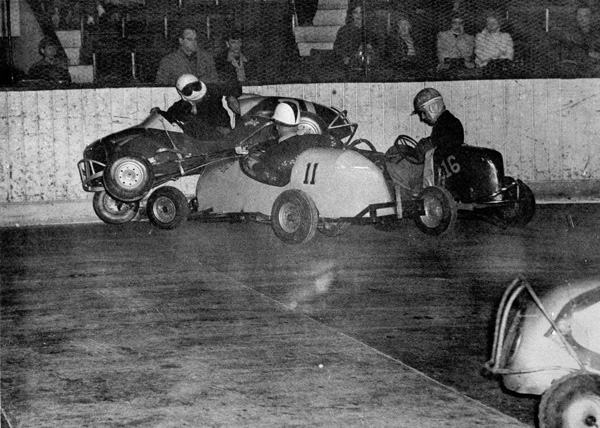 |
|
#1737 - Things could get a
little spirited indoors back in the day. This
was a March 1951 show at the Rhode Island
Auditorium in Providence. According to New
England’s esteemed historian RA Silvia, Mickey
Gill had been pretty much cruisin’ along in the
low groove when future Hall of Famer Hop
Harrington was buzzing around upstairs.
Apparently Hop kept coming down on Mickey and
rapping him. The last time was the last time.
When Hop got close, Mickey leaned over, grabbed
his steering wheel, gave it a yank – and Hop was
into the wall. Unfortunately, Mickey reported,
“I didn’t let go in time, so I went for the
ride, too.” (Harold White Photo, RA Silvia
Collection) |
|
a |
|
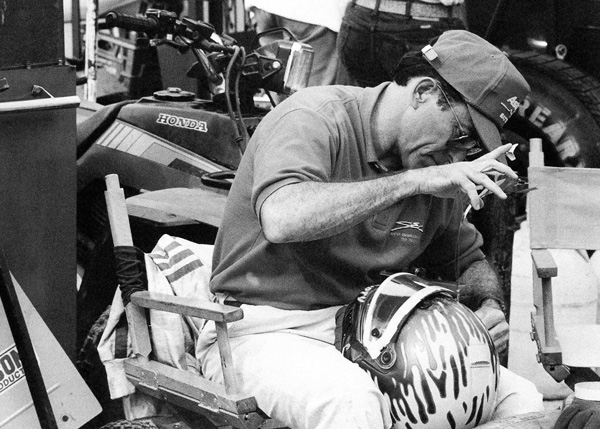 |
|
#1736 - Johnny Parsons Jr. is from
California – an L.A. policeman before starting
an impressive open-wheel career, including 12
Indy 500 starts. He knew about tearoffs – he was
on the hammer whether in a Midget, Sprinter, or
Silver Crown car. Photo from
THUNDER ROAD: A Photographic Journey of Open
Wheel Racing, Carnivals, and the Iconic Highways
they Travel, by Tom Toutz |
|
A |
|
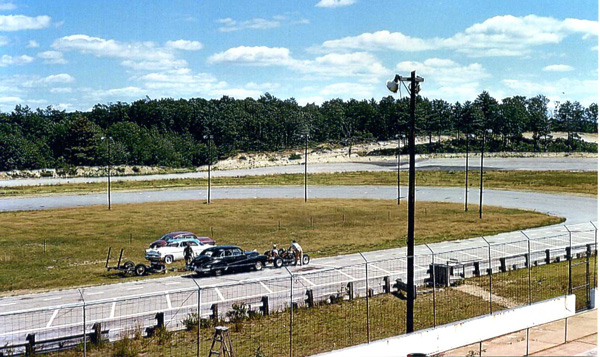 |
|
-#1735 - It may not
have been as technologically – and financially –
advanced as what is happening in Daytona today,
but testing has been a part of racing since our
world was young. Case in point is this scene
from Thompson, CT, back in the 1950s. Close
enough to perfect for me. (Coastal 181
Collection) |
|
a |
|
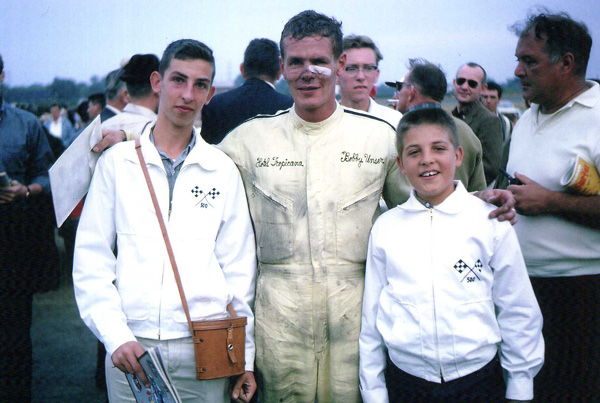 |
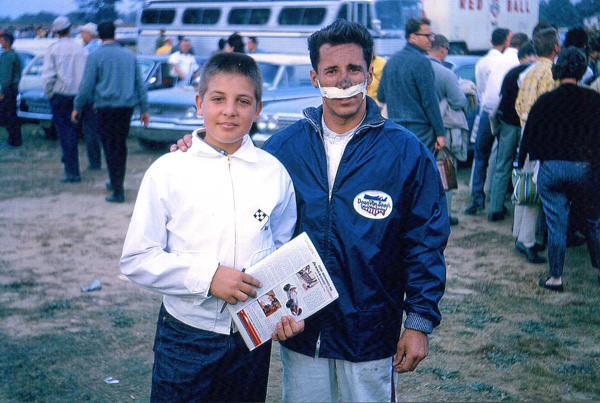 |
|
#1734 - We were at the Chili Bowl with
our books, especially Kevin Olson’s
CAGES ARE FOR MONKEYS. Needless to
say, we were watching carefully when he ran his
alphabet feature on Saturday – and what a trip
that he won it. When we told him he looked
great, he said we couldn’t see what had been
really great. Character that he is, he was
wearing his old time open-face helmet. He said,
“I was going down the backstretch and I got hit
right on the nose with a rock or a mud ball. It
was really cool – just like the old days.” Here
are images of a young Bobby Unser and Mario
Andretti. Wonder what they’d say. (Coastal 181
Collection) |
|
A |
|
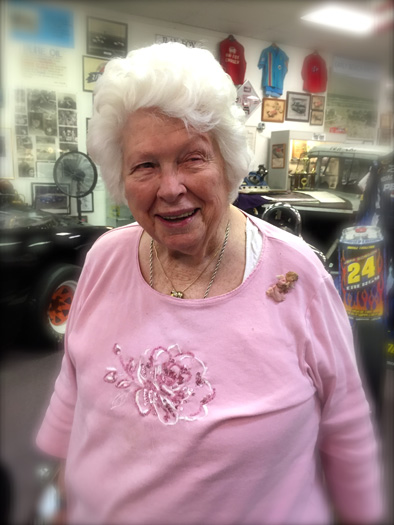 |
|
#1733 - Longest serving
Juanita “Lightnin’” Epton saw her first race in
1945. Now at age 96, she has worked at Daytona
Speedway’s ticket office for its entire 58-year
existence. As such, she is the track’s
longest-serving employee. “I was there before
Bill Junior,” she proudly says. Former track
president Joie Chitwood in a newspaper interview
said, “She’s a spitfire.” With a warm smile and
great caring for the track’s customers for so
many years, many instead call her “a legend.”
Her late husband gave Juanita the nickname
because, as she says, he “…never knew when or
where I’d strike.” (Photo and caption by Dick
Berggren) |
|
a |
|
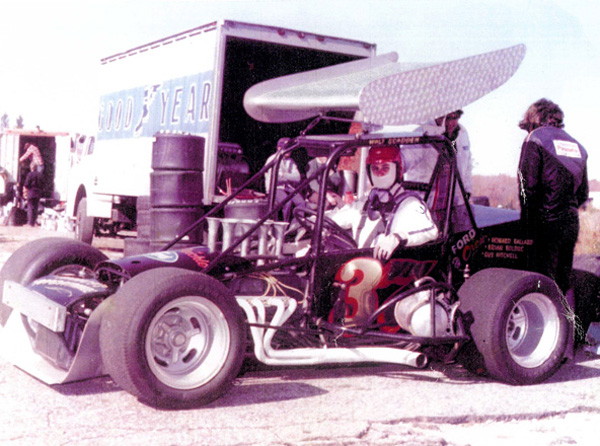 |
#1732 - Here’s good guy Walt Scadden
in his first Supermodified at Thompson, CT. Walt
recalls that with a 289 Ford it was “slightly
underpowered.” The wheelbase looks short enough
that a front bumper was able to serve as a nerf
bar. I bet Walt had to pay attention to keep it
straight on those long straightaways. (Scadden
Collection)
|
|
a |
|
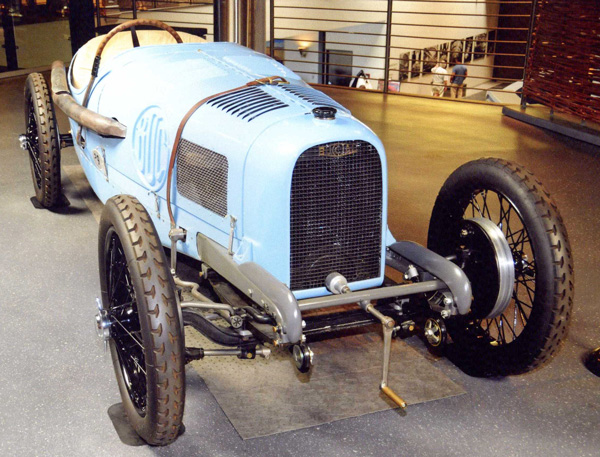 |
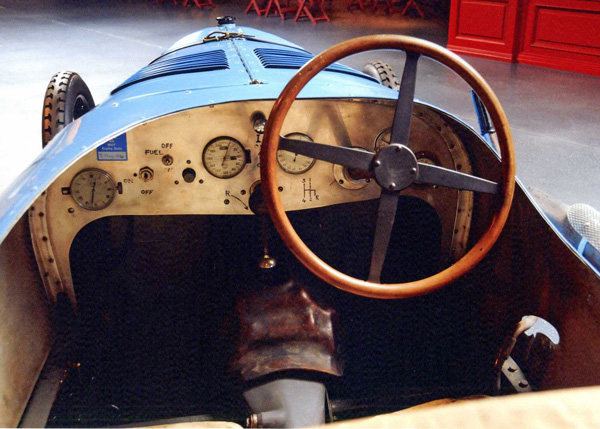 |
|
#1731 - It is hard to
believe that something so beautiful could make
someone feel so racy. Here is one of Peter
Mullen's Bugattis at the amazing "Art of the
Bugatti" show at the Petersen Museum in Los
Angeles. (Dick Berggren Photos) |
|
A |
|
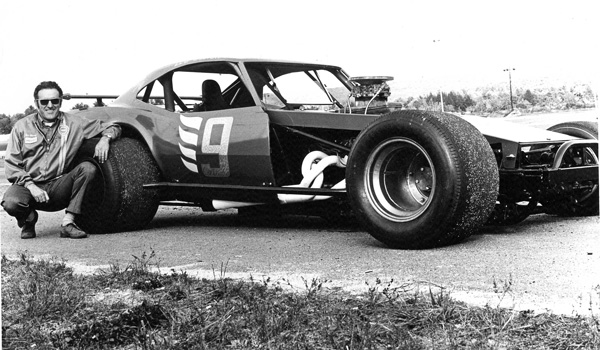 |
#1730 -
Remembering LEO CLEARY, a racing legend.
(North East Motor Sports
Museum)
https://www.youtube.com/watch?v=X0s28Uab_AM
- YouTube video excerpts
from
Norwood
Arena: The Movie |
|
a |
|
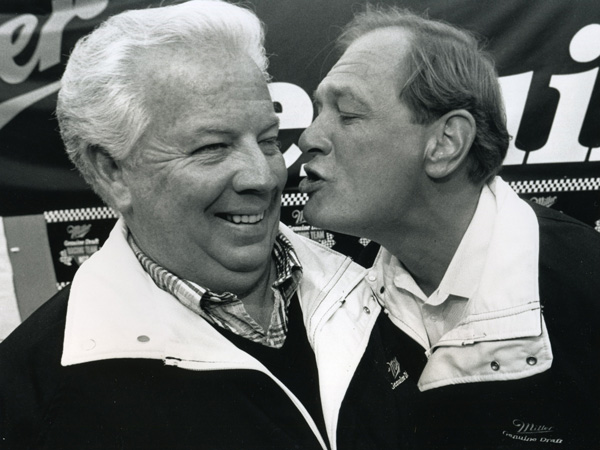 |
|
#1729 - We were going
through our photo collection at Coastal 181
getting ready to induct Will Cagle into the
Living Legends of Auto Racing during their
Awards Night in Daytona the Wednesday before the
Daytona 500. This surprising image popped up.
Will is shown here with the late – and rather
impish – New York journalist and lawyer Andy
Fusco. Will, on the other hand, was quite
reserved through all his years of incredible
successes. Somehow Andy’s advances must have
worked. Nobody could believe it when Will
allowed Andy to jump into the mighty #24
Modified and hot lap it at Weedsport, NY.
(Coastal 181 Collection) |
|
a |
|
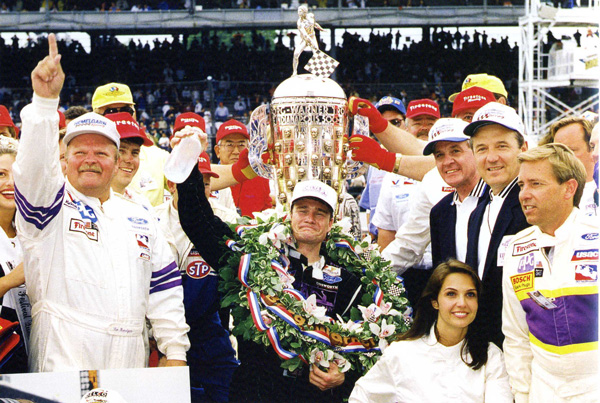 |
|
#1728 - Pain and pleasure:
He had just won the 1996 Indy 500, and everyone
was grinning except Buddy Lazier. What was the
problem? Just two months earlier he had entered
the Dura Lube 200 at Phoenix, but never made the
show. He crashed in warm-ups with Lyn St. James
and definitely was the loser. At Indy he still
suffered from the 16 fractures in his back.
(FROM
AUTOCOURSE: Official History of the Indianapolis
500, Second Edition, by Donald Davidson
and Rick Shaffer) |
|
A |
|
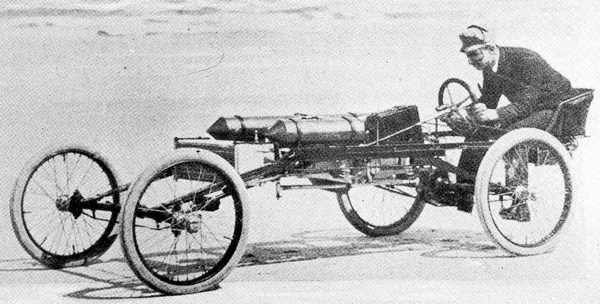 |
|
#1727 - The Olds “Pirate”
was the very first car to make an unofficial
timed run on the sands of Florida – at Ormond
Beach in April of 1902. The driver was the
designer, Ransom E. Olds. Quite remarkably he
cruised own the beach, powered by a 5-cu. in.,
1-cylinder engine, at 57 mph. (Photo from
FORD: The Dust and Glory – A Racing History,
by Leo Levine |
|
a |
|
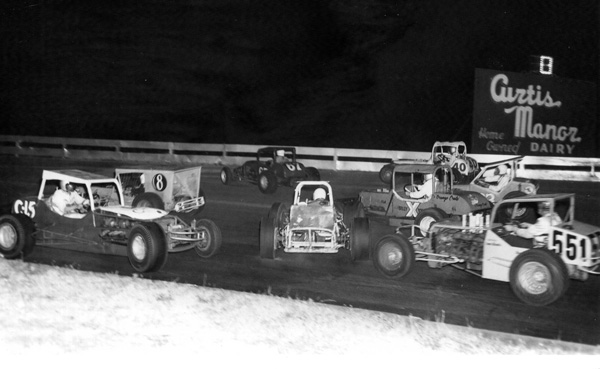 |
|
#1726 - It sure looked like
the afternoon commute on Route 4 in Orlando, but
it was actually a Saturday night at Oswego, NY.
The participants were Mark Letcher (c-15), Jim
“The Pine” Shampine (8-ball), “Rapid Ralph”
Denson (67), “Irish Jack” Murphy (6-backwards),
Billy Yuma (X), Neil “Terrible” Tooley (23),
“Stormin’ Norman” Makereth (40), and Leon
“Cowboy” Weiske (551). (Coastal 181 Collection) |
|
a |
|
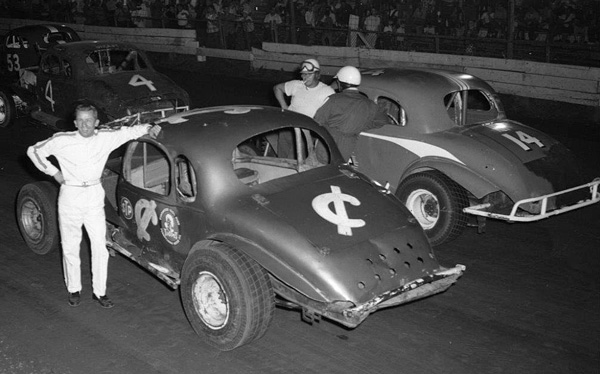 |
|
#1725 - Here’s a shot of Ed
Flemke, “Modified Racing’s Fastest Professor,”
in 1966 in an unusual dirt track appearance – at
New York’s Fonda Speedway. Bones Bourcier, who
wrote Flemke’s biography (STEADY
EDDIE), says, “He always, ALWAYS used
the cliché, ‘Dirt is for planting potatoes.’ But
he certainly never looked down on it; he always
kept more or less abreast of what was happening,
who was winning, new chassis developments, and
so on. He did drive for Sharkey and others on
the dirt at Stafford, Connecticut, but only
because there were no Friday-night blacktop
options in that season or so between the end of
the Eastern Bandits and the opening of
Albany-Saratoga in New York.” (Coastal 181
Collection) |
|
a |
|
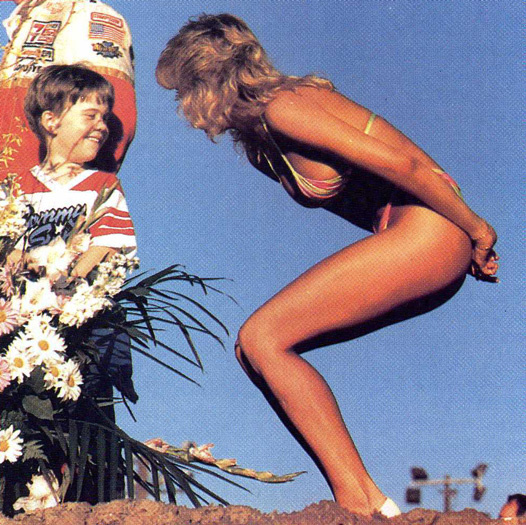 |
|
#1724 - It was a score when
the Agajanians hired Leslie Bremer to be their
trophy girl at Ascot. The intolerably beautiful
model/actress from Thousand Oaks, CA, was a hit
with all generations. (Open Wheel Magazine, Mike
Myers Photo) |
|
a |
|
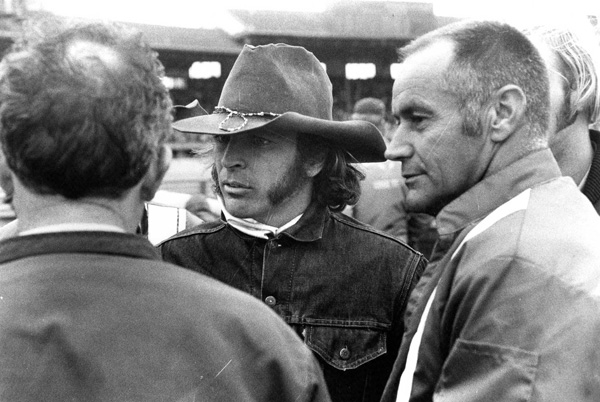 |
|
#1723 - Dick Berggren
captured this moment at the old Trenton, NJ,
Speedway back in the ‘70s. Jan Opperman (L) and
Dutch Hoag were alike in their Olympian talents,
but oh so different in their packaging. (North
East Motor Sports Museum Photo) |
|
A |
|
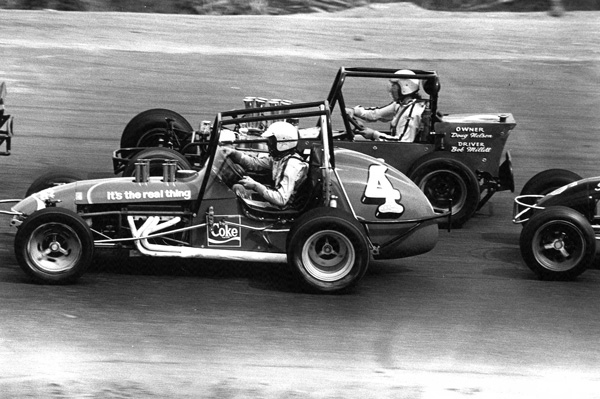 |
|
#1722 - In #1720 we ran a
shot of Massachusetts’ Scotty Martel making his
way very quickly around Flemington, NJ, in his
Super. Here’s his dad, Jim, a New England Auto
Racing Hall of Famer, exercising Skip Matczak’s
Sprinter at a 1971 NESMRA race at Star Speedway
in Epping, NH. Skip, also a Hall of Famer,
commented, “The car was a Ron Ward chassis which
Bentley Warren drove to many wins at Bryar Motor
Sports Park. We also won a couple of times with
it at Pocono. It was a great car. The cage was a
bolt-on as USAC did not allow cages when we ran
with them. Tassi Vatis noticed us as we ran
pretty well on pavement and, after a call from
Paul Young, he invited us to lunch, where he
asked Bentley to come to Indy that year. Bentley
then suggested I hire Jim Martel as his
replacement. It was a good choice as we won
together including on dirt at Claremont.” (North
East Motor Sports Museum Photo) |
|
A |
|
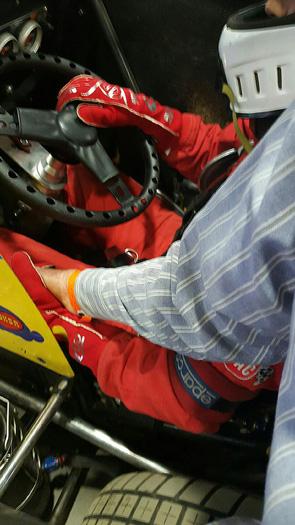 |
|
#1721 - Legendary Sprint Car
champion, Jimmy Oskie, is a familiar – and
welcome – sight for emerging wheelmen and
wheelwomen in California. He shares racing
strategy, visualization, and centering
techniques – even at the intensely
pressure-packed starting grid of the Chili Bowl.
This is Ashley Hazelton, a top notch West Coast
USAC runner, ready to be pushed off for one of
the alphabet qualifiers. That’s Jimmy’s arm in
the striped shirt reaching in to hold her hand
as they share a calming prayer. |
|
A |
|
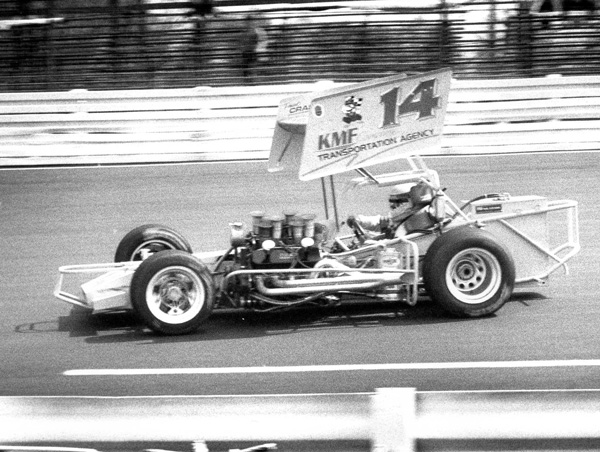 |
|
#1720 - The Martel Family of
Ipswich, MA, has been immersed in Supermodified
racing for decades. Here’s a cool image of
second-generation Scott Martel at speed at
Flemington, NJ. Scott says, “That sure brings
back some great memories. I believe this was the
first-ever race on the newly paved Flemington
Speedway. ISMA heats were the first to roll out
that day, and I won the first one from the pole.
If I remember correctly, I led the feature for a
while and finished second to Bentley Warren with
my right rear badly blistered. It was one very
interesting place for a guy who grew up at small
bullrings like Star and Hudson up in New
Hampshire. I wish it was still there. It was
FAST, square, and fun.” (Jim Donnelly Photo) |
|
a |
|
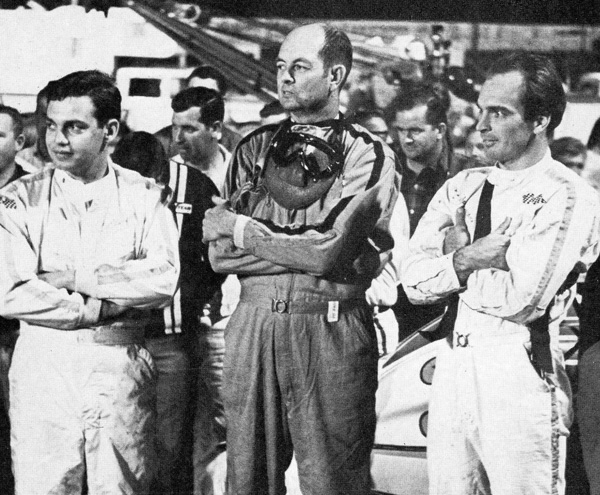 |
|
#1719 - Three of the stars
of American open wheel racing met up at the
Western at Manzanita in 1968. L to R, Lee
Kunzman, Gordon Wooley, and a carefully combed
Jan Opperman. All three were huge winners along
the way in their Sprints, but all three also
suffered serious injury. (Open Wheel Magazine,
Jim Chini Photo) |
|
A |
|
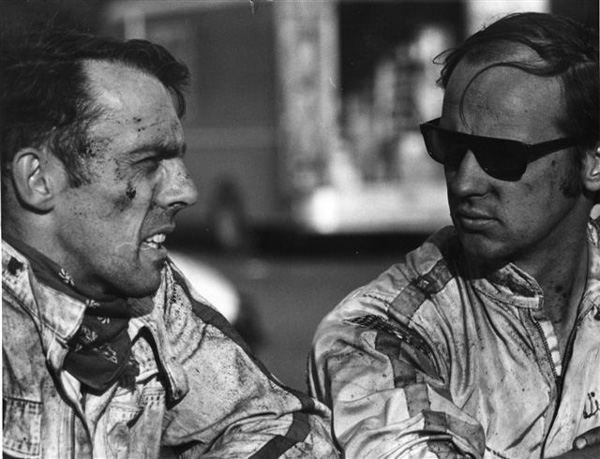 |
|
#1718 - Actually they look
pretty sane, but they weren't. New York Hall of
Famer Dick Hansen (L) and NEAR Hall of Famer
Dick Berggren share tall stories after a show at
the gritty old Lakeville, MA, Speedway in the
1970s. (Coastal 181 Collection) |
|
a |
|
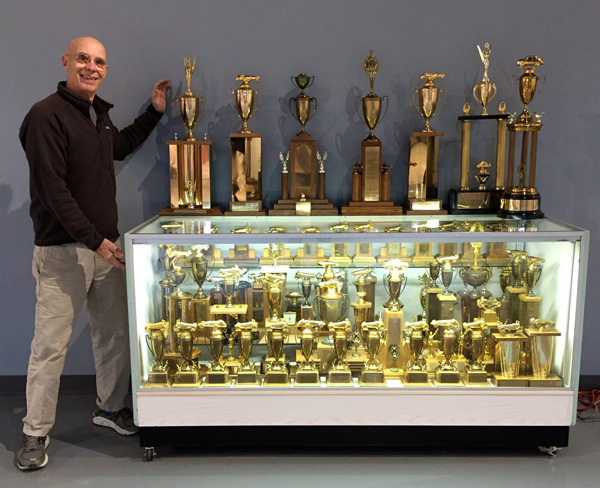 |
|
#1717 - Every auto racing
museum relies on volunteers to make things work
well. Museum volunteer Rick Nelson smiles on
completing the cleaning and polishing of a
trophy case and the trophies to fill it at the
North East Motor Sports Museum. Hard to believe
but all these trophies and more were won by one
driver, Dave Sanderson, who was a top drag racer
in the 1950s and ’60s. Sanderson designed, built
and raced a unique car whose Pontiac engine was
an integral part of the chassis, thus saving
weight. As brave a race car driver as he was,
Sanderson feared water and never learned to
swim. Sadly, he lost his life when he fell out
of a boat. (Caption and Photo, North East Motor
Sports Museum) |
|
a |
|
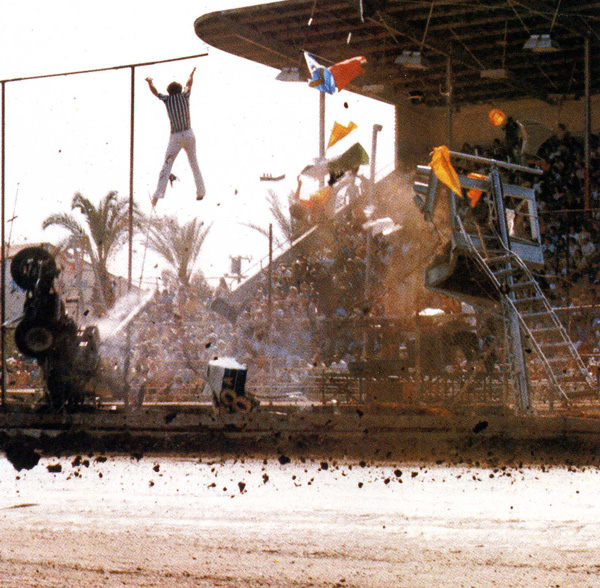 |
|
#1716 - It was some
kind of show in front of the full stand at El
Centro, CA, when Larry Clark got to flipping his
Sprinter. On the way by, the nose of the car
tore up the starter’s stand, sending Steve
Vadden for one serious moon shot. He ended up
with a compound leg fracture. (Open Wheel
Magazine, Greg Talley Photo) |
|
a |
|
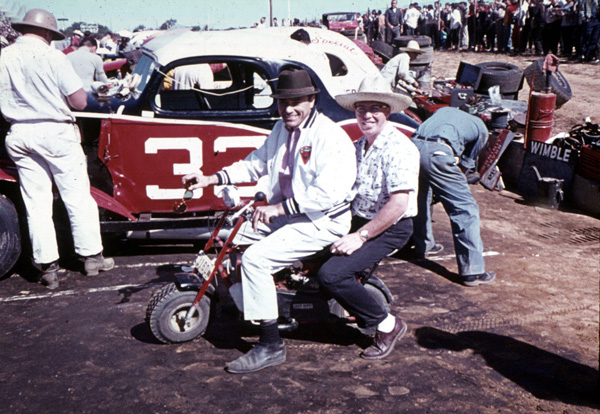 |
|
#1715 - They were two
buddies – and two of the very best – so we have
to forgive them their hats. That’s Al Tasnady up
front and Bill Wimble on the back, Langhorne
1963. (Steve Pados Collection) |
|
a |
|
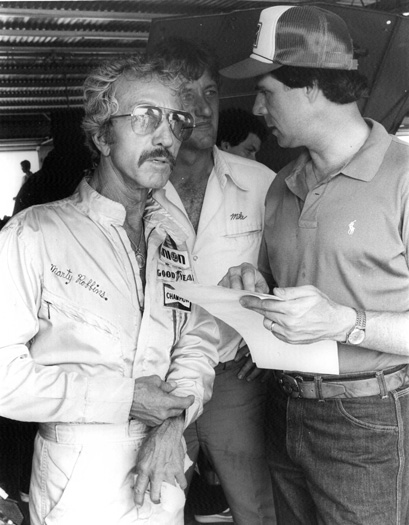 |
|
#1714 - Darrell Waltrip
actually seemed to be listening. But who
wouldn’t when Marty Robbins piped up. (Coastal
181 Collection) |
|
a |
|
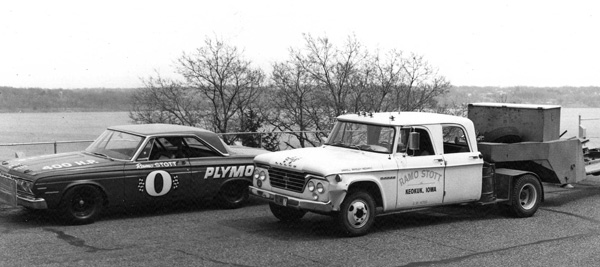 |
|
#1713 - Keokuk, the
southernmost city in Iowa, sits right near the
junction of the Des Moines River and the Big
Muddy. It played a big role in Mark Twain’s Life
On The Mississippi. More recently the city,
population around 10,000, has played a curiously
distinguished role in pit areas in the middle
part of the country. Among the long list of
Keokuk racers past and present are Ernie Derr,
Ron Hutchinson, Dick Hutchinson, Lem
Blankenship, Ramo Stott, Lance Stott, and Don
White. Photo (Coastal 181 Collection) |
|
A |
|
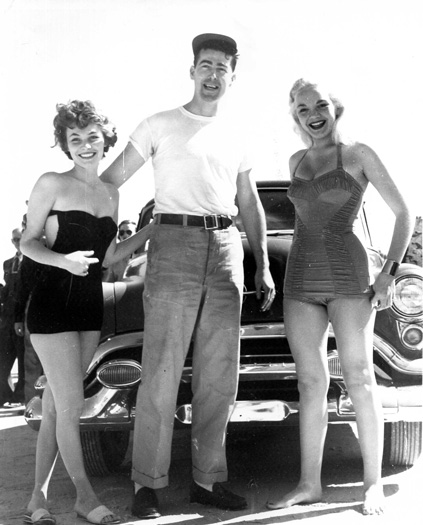 |
|
#1712 - Lots of action
seemed to accompany “Big Bob” Pronger wherever
he went. He blasted onto the scene with vigor in
Daytona in 1953, shown above. He set new
standing-start, measured-mile and two-way run
records and then sat on the pole for the Grand
National race at 115.77 mph. Pronger supposedly
bet Fonty Flock, his front-row mate, that he
would whip him on the first lap. That didn’t
quite work out, as Pronger flipped over the
North Turn embankment. For years and years he
became a standout at Chicago’s Raceway Park,
while allegedly supporting himself as a chop
shop operator with mob ties. He reported being
shot at a couple of times pulling into Raceway
Park, and on June 17, 1971 he just plain
disappeared. A body believed to be his – but
never officially identified – was eventually
found in Griffin, Indiana. (Coastal 181
Collection) |
|
A |
|
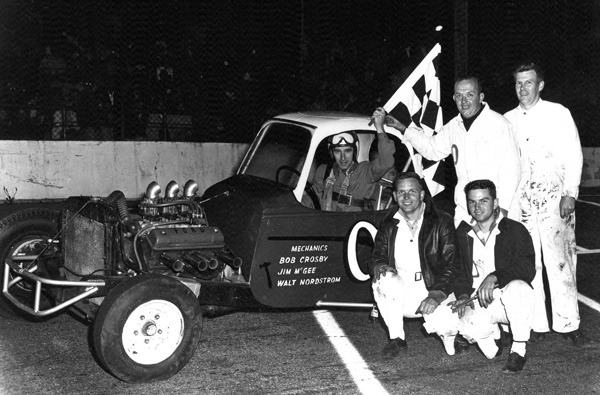 |
|
#1711 - It was a very spiffy
“cutdown” in the very late 1950s at Seekonk, MA-
Speedway. The caffeinated Gavin Couper was
tucked tightly into the office with both
shoulder harnesses and a Sam Brown-type belt,
surrounded by a rather minimalist cage.
Up-and-coming Jim McGee was in the lower right,
at the outset of a spectacular career that
landed him in Indianapolis. (John Monaghan
Collection) |
|
A |
|
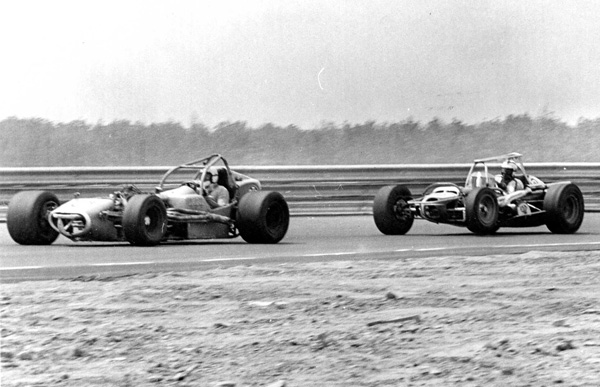 |
|
#1710 - Fearsome looking
Supers under power at Pocono in the 1970s.
Masterful Jim Shampine is chased by versatile
Neal “Terrible” Tooley. (Photo, North East Motor
Sports Museum) |
|
A |
|
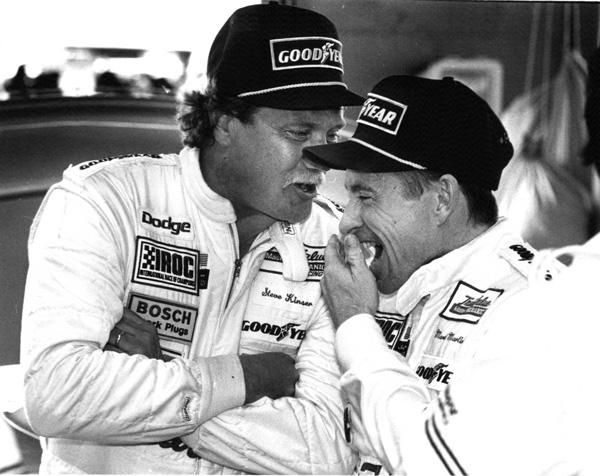 |
|
#1709 - Stars from different
galaxies. What could Steve Kinser had said to
get Mark Martin goin’ like that? Bet it had
something to do with girls. (Photo, North East
Motor Sports Museum) |
|
A |
|
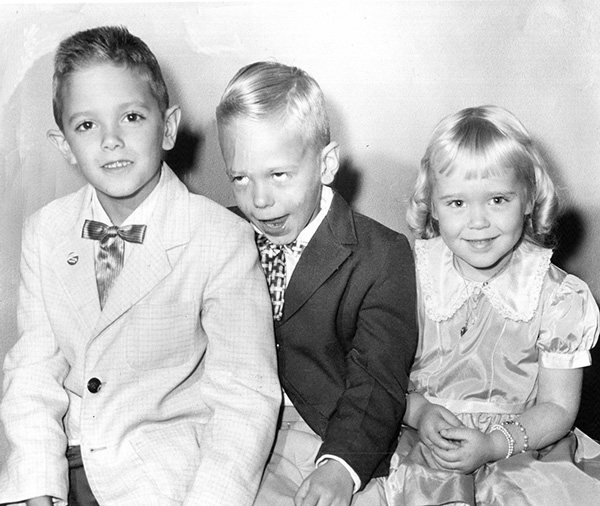 |
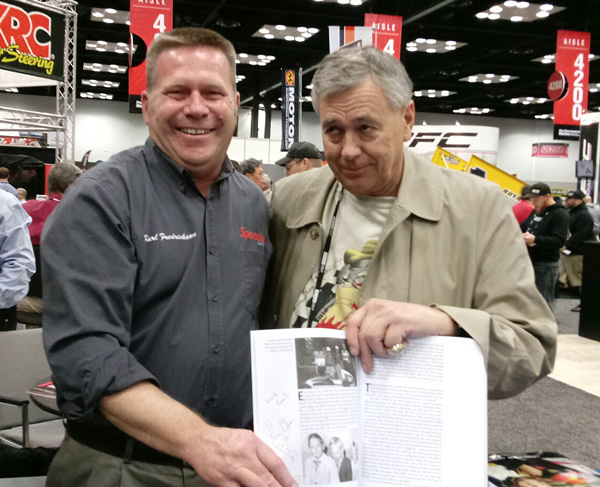 |
|
#1708 - Get two people together who are a
half-bubble off center and guaranteed they will
demonstrate that some things just never
change. This went down at PRI a couple weeks
ago. The top photo is an Olson Family portrait
from the brand new
CAGES ARE FOR MONKEYS book
showing Kevin, brother Loren, and sister Sharon
in the mid-‘50s. In the second shot
Speedway
Illustrated’s Karl Fredrickson has
asked Kevin for an autograph – on that page.
(Photos,
Speedway
Illustrated and KO Family Collection) |
|
A |
|
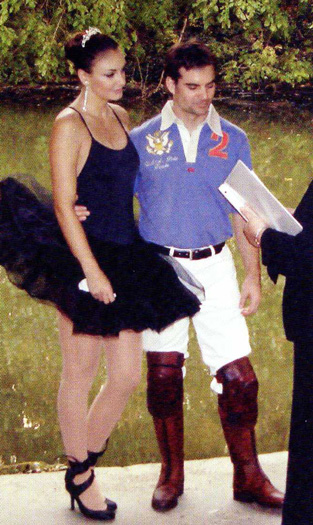 |
|
#1707 - Jeff Gordon and Ingrid
Vandebosch actually were hitched quietly – and
uniquely – on Halloween in 2006. “He and Ingrid
pulled off a surprise wedding – and in costume
no less – in a secluded gazebo in New York’s
Central Park. With a judge dressed like a witch,
Ingrid in a tutu and crown as the black swan
from Swan Lake, and Jeff clad as a polo player
next to their cowboy hat-wearing dog Valentino,
the happy couple took their vows. ‘Normally, a
guy forgets his wedding date, but I was afraid
I’d forget – I’m no good with dates,’ Ingrid
says. “So I said, ‘Let’s do it Halloween so
we’ll never forget.’ A week later, on November
7, they tied the knot again in front of their
friends and family at a ceremony in Mexico.”
From
JEFF GORDON: His Dream, Drive, and Destiny,
by Joe Garner. (Gordon Family Photo) |
|
a |
|
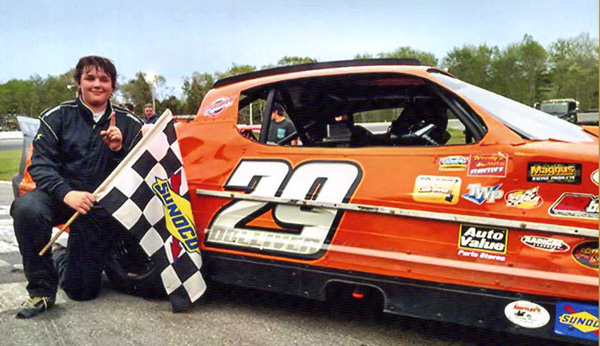 |
|
#1706 - No question that racing is a
family sport. It only makes sense that a kid
spending countless summer nights in a grandstand
with his family would be bitten by the bug and
want to show his stuff in the cockpit. But often
talent seems to seep down through the
generations as well. Take for example the
unassuming teenager from Derry, NH, Max
Dolliver. Watch him run his Dolliver Streeter –
upstairs, downstairs, up the middle. Look
carefully and you might as well have been
watching his dad, Bryan, (named for Jimmy) wheel
his dirt car around Canaan Speedway – or even
his granddad, Jerry, a gentle man who racked up
multiple championships in Supers and Sprinters,
performing with grace and civility. (Dolliver
Family Collection) |
|
a |
|
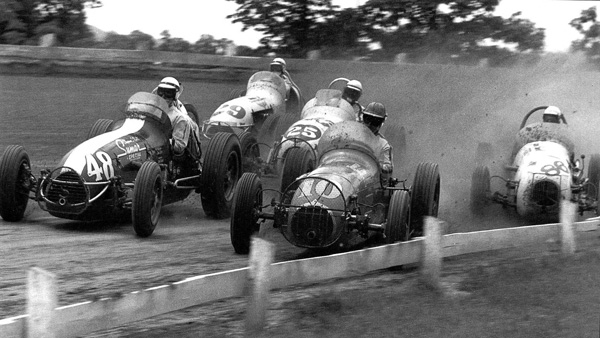 |
|
#1705 - The traffic reports called out
heavy congestion in Williams Grove, PA, in 1958.
Len Sutton #48, Don Branson #10, AJ Foyt #29,
Earl Motter #25, and Buzz Barton. From
FEARLESS: Dangerous Days in Open Wheel Racing,
by Gene Crucean. (Dave Knox Photo) |
|
A |
|
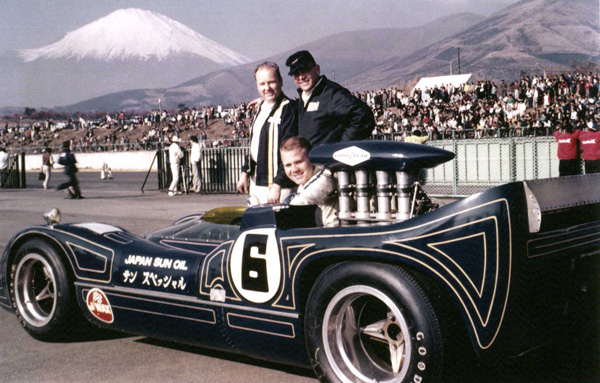 |
|
#1704 - One beautiful race
car. Engine builder Jim Travers of TRACO, Karl
Kainhofer of Penske Racing, and Mark Donohue get
ready at Mt. Fuji, Japan in 1968. From
PENSKE’s MAESTRO: Karl Kainhofer and the History
of Penske Racing, by Gordon Kirby.
(Karl Kainhofer Collection) |
|
a |
|
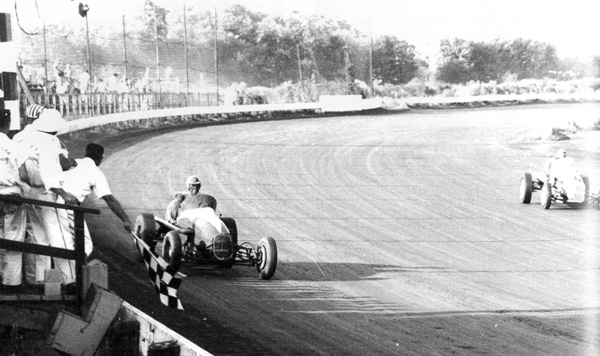 |
|
#1703 - “Ralphie the Racer”
Liguori grins through the Langhorne grime as he
sweeps past the starter for a win in the
Leitenberger Offy. He set a 50-lap record of
104.107mph that will never be broken. His
comments on the grand circle: “It was a tough
place, but I liked it. You know that track, the
way they oiled it, graded it and everything
else, if you were very cautious and you didn’t
get full-throttle on that joint, the car would
jump all over the place. And the faster you
went, the better it felt. When it felt good
enough that you could do anything with it, that
was time to back off a little bit. It was very
deceiving. I got in trouble one time, and that’s
how I learned that. And then down in Puke
Hollow, you had to go up to the fence and run
straight. If you ran through there sideways, you
‘d catch a rut for sure. Also, if you came down
the front and went in there low, you’d get
upside down. ‘Cause that underground stream or
whatever it was, you just had big holes and
everything….You know, I wonder if a house ever
sunk there.” Photo and quote from
LANGHORNE: No Man’s Land, by L. Spencer
Riggs. (Walt Imlay Photo) |
|
a |
|
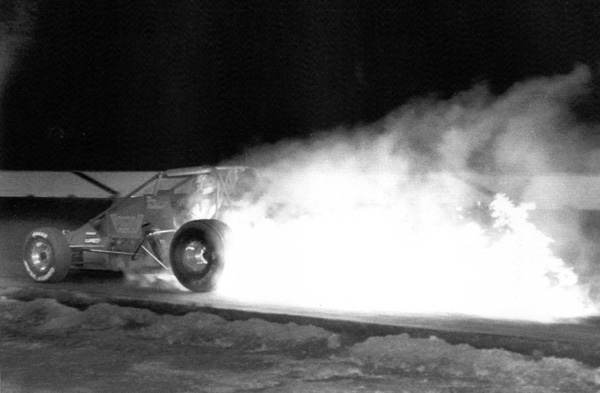 |
|
#1702 - A fiery bummer. Dave
Darland was bidding for the 1995 Championship
when the Silver Crown cars pulled into
California’s West Capital Speedway. All was
going well until lap eleven when an oil fire
erupted, forcing “the People’s Champ” to the
pits. He ended up losing the crown to “Smoke” by
two points. From
SACRAMENTO: Dirt Capital of the Wesr,
by Tom Motter. (Dennis Mattish Photo) |
|
a |
|
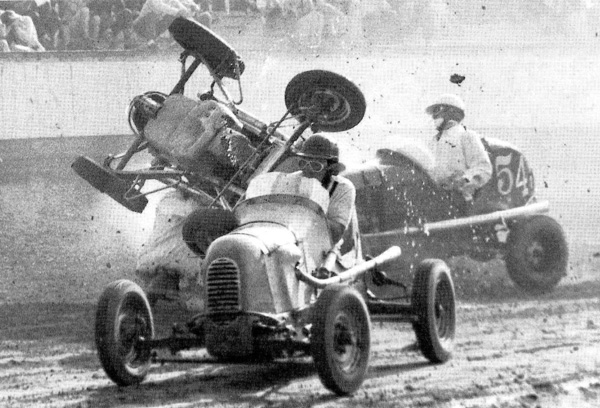 |
|
#1701 - Diminutive Walt
Faulkner, nicknamed “Little Dynamo,” was a
native of Tell, Texas, who moved to L.A. in 1936
and became a top-rate racer. He showed his stuff
by going to Indy in 1950 for his first
Championship event, becoming the first rookie to
gain the pole position. He ran seventh. He was
especially proficient in Midgets, but they
nearly did him in. Here he is at Bonelli Ranch
Stadium in California on October 7, 1945,
getting drilled face first into the dirt. Tossed
around with his feet caught in the seat belts,
he ended up with a broken pelvis and multiple
leg fractures. Eleven years later he died in a
USAC Stock Car at Vallejo Speedway. From
DISTANT THUNDER: When Midgets Were Mighty,
by Dick Wallen (Dick Wallen Collection) |
|
a |
|
|
a |
 Previous
Photos of the Day - PAGE 8 Previous
Photos of the Day - PAGE 8
 Previous
Photos of the Day - PAGE 7 Previous
Photos of the Day - PAGE 7
 Previous
Photos of the Day - PAGE 6 Previous
Photos of the Day - PAGE 6
 Previous
Photos of the Day - PAGE 5 Previous
Photos of the Day - PAGE 5
 Previous
Photos of the Day - PAGE 4 Previous
Photos of the Day - PAGE 4
 Previous
Photos of the Day - PAGE 3 Previous
Photos of the Day - PAGE 3
 Previous
Photos of the Day - PAGE 2 Previous
Photos of the Day - PAGE 2
 Previous
Photos of the Day - PAGE 1 Previous
Photos of the Day - PAGE 1 |
|
|
|
|